Technalogix TXUD1000 1000 W Digital TV Transmitter User Manual TAUD 1000 ADRENALIN cover page
Technalogix, Ltd. 1000 W Digital TV Transmitter TAUD 1000 ADRENALIN cover page
Users Manual

TAUD-1000
BROADCAST TRANSMITTER
OPERATING
MANUAL
You’ve already unpacked it, haven’t you? You’ve unpacked
it and plugged it in and turned it on and fiddled with the
knobs. No? Okay, good. Please take a few minutes to read
the manual and familiarize yourself with your new
Technalogix power amplifier.
We believe that this manual, and of course our equipment,
should be everything you need to get on the air with superb
broadcast quality video. We understand that a capable and
confident user will get the most out of our product and we
have made every attempt to educate readers of all technical
levels. If there is something that is not clear, or you require
further information, please do not hesitate to contact us and
we’ll be glad to help out.
Technalogix Ltd.
#4, 8021 Edgar Industrial Place
Red Deer, Alberta, Canada
T4P 3R3
Phone: 403.347.5400
Fax: 403.347.7444
URL: www.technalogix.ca
Email: technical@technalogix.ca
sales@technalogix.ca
We truly appreciate that you have chosen us as your
television broadcast system supplier. Happy viewing.
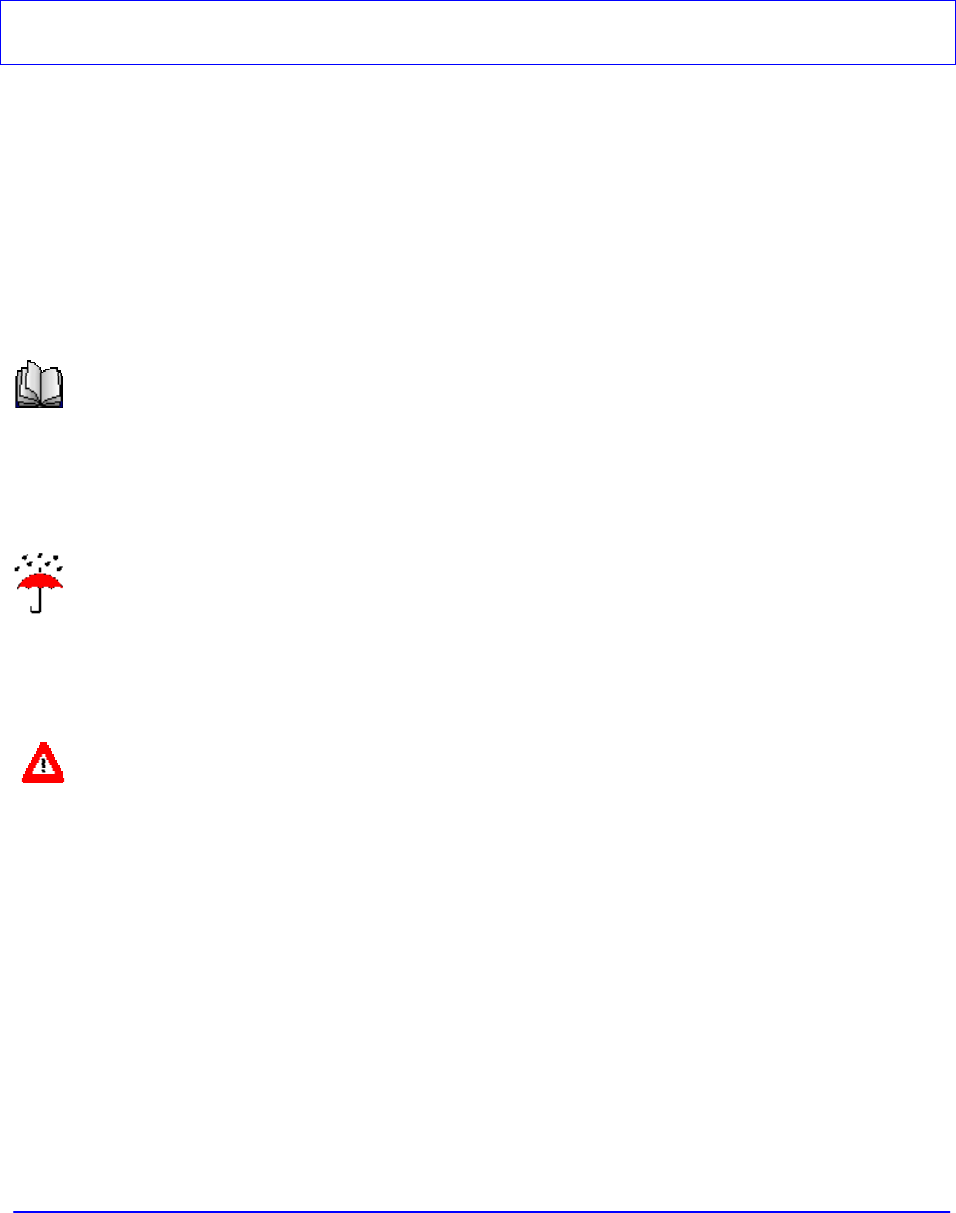
I-1
Technalogix Ltd
Section I - Safeguards
General Safeguards
This section is written as a general guide to keep all 5 fingers on your hand and is intended for
those having previous knowledge and experience with these kinds of equipment. It is not intended
to contain a complete statement of all safety precautions, which should be observed by personnel
using this or other electronic equipment.
DOCUMENTATION - Read, retain and follow instructions before operating the equipment.
There is a lot of useful information in the manual, and besides, we spent a lot of time
writing it!
ENVIRONMENT - To reduce the risk of fire or electric shock, do not expose this
equipment to rain, moisture, or rye and sodas at the company Christmas party. Refer all
servicing to qualified service personnel.
SERVICING - Do not attempt to service this equipment yourself as opening or removing
covers can result in a warm tingly feeling and will void the warranty. Refer all servicing to
qualified service personnel.

I-2
Technalogix Ltd
Safety and First Aid
Personnel engaged in the installation, operation, maintenance, or servicing of electronic equipment
are exposed to the hazard of high voltage. It is imperative that all safety regulations and
precautions are consistently observed. Knowledge of first aid procedures is recommended. The
following information is presented as a reference only.
• At all times, avoid placing any part of the body in series between ground and circuit points,
whether power is on or off.
• Dangerous voltage may be present in equipment even though power is off. Do not open the
cabinet. Refer servicing to qualified service personnel.
• It is the duty of all personnel to be prepared to give adequate emergency first aid treatment and
thereby prevent avoidable loss of life.
• There are three principle degrees of burns, recognizable as follows:
• a first-degree burn reddens the skin.
• a second-degree burn blisters the skin.
• a third degree burn chars the flesh and frequently places the victim in a state of shock
accompanied by respiratory paralysis.
• Respiratory paralysis can cause death by suffocation within seconds. It is imperative that the
approved methods of artificial respiration are initiated immediately and continue until the victim’s
breathing is normal.
• A muscular spasm of unconsciousness may render the victim unable to break free of the
electric power. If this is the case, turn the power off immediately.
DO NOT TOUCH THE VICTIM OR YOU MAY SHARE THE SAME
PREDICAMENT.
• If the power cannot be turned off immediately, very carefully loop a dry rope, article of clothing,
length of strong cloth or a rolled-up newspaper around the victim and pull the victim free of the
power source. Carefully avoid touching the victim or clothing.
• Once free of the power source, the victim must be placed in a reclining position and covered
with a blanket or newspapers to keep warm. At the first opportunity, enlist help in
summoning a doctor. If a doctor cannot be summoned, transport the victim to the doctor or
a hospital. Be sure the victim is kept well covered and warm while awaiting professional
treatment.

I-3
Technalogix Ltd
Operating Safeguards
It is a known fact that our broadcast transmitters and translators enjoy 50-ohm load
impedances. So much so, that it is imperative you maintain 50-ohm impedances throughout
your system. In return, your equipment will provide you with maximum power transfer to the
antenna and decreased reflected power heading back towards the amplifier pallets, reducing
the amount of magic smoke that gets let out of the power amplifier. Before anything is turned
on, ensure that there is a 50-ohm path from the output of each stage to the input of the next, all
the way to the antenna.
In addition to maintaining proper 50-ohm impedances throughout the signal chain, it is also
important, whenever possible, to make sure the RF drive going to the input of the power
amplifier is removed before turning on or turning off the DC power supply. This is because all of
the RF transistors used in the individual amplifier pallets are fabricated with LDMOS (Laterally
Diffused Metal Oxide Semiconductor) technology. Nice and linear yes, but they do not like to
make any RF power when their supply voltages are not within a specific range. When you first
turn your power amplifier on or off, the DC power supply’s output voltage may take a while to
stable out to a safe operating voltage. Ten seconds wait before applying the RF drive will
ensure no issues arise.
Our power amplifiers are designed to reliably generate a specific RF output power. Failing to
adhere to overdriven amplifier warnings can decrease the reliability of your system, and frankly,
makes our repair department busy and grumpy. If you need to transmit to a little larger
coverage, you are better off increasing antenna gain, and more importantly, antenna height
above average terrain. On TV and FM broadcast frequencies, insufficient antenna height puts
an upper limit on your range, regardless of power levels, as the distance from your antenna to
the radio horizon is limited.

Technalogix Ltd Transmitter
II-1
Section II - Warranty
Our legalese is straightforward. It is simply designed to give you peace of mind and helps you resist
the temptation to have your electronics friend try to repair your Technalogix product.
Technalogix Ltd. products have been completely tested and found to meet specifications and be in
proper operating condition. They are warranted to be free from defects in materials and
workmanship for a period of one year from the date of shipment. If the system becomes damaged in
shipment and there are obvious signs of damage to the outside of the packaging, notify your courier
immediately before that courier walks out the door.
Technalogix Ltd. will not be liable for damages of whatever nature arising out of or in connection
with the equipment or its use thereof. Technalogix does not assume responsibility for injury or
damage resulting from the practices of untrained or unqualified personnel in the handling of this
equipment.
Technalogix Ltd. warranty does not include:
• misuse, neglect or accident.
• incorrect wiring and /or improper installation.
• unauthorized repairs, modifications or use in violation of instructions issued by Technalogix.
• incidental or consequential damages as a result of any defect.
• reshipment cost or insurance of the unit or replacement units or parts.
• acts of nature or terrorism.
Technalogix agrees, at our option, to remedy warranted defects or furnish a new part in exchange
for any part of a unit which, under normal installation, use and service, becomes defective. The user
will pay for transportation costs to and from the repair center. If you require technical service on the
site, the cost to you will be $800.00 US per day plus air fare and meals.

Technalogix Ltd Transmitter
II-2
To claim your rights under this warranty:
• Contact Technalogix and describe the problem in as much detail as possible. See
troubleshooting section in this manual. If a solution cannot be found at this time, it may be
determined that the unit will have to be returned to Technalogix for repair, once a Return
Materials Authorization (RMA) number is provided. Please look under our web site
(www.technalogix.ca) for the RMA form (Service) and fill it out. Either fax it to us or email to us.
• Package equipment carefully for prepaid shipment to Technalogix. Include a written description
of the problem experienced, a copy of the original invoice establishing warranty status, and the
RMA.
Technalogix reserves the right to make revisions in current production of the equipment and
assumes no obligation to incorporate these changes in earlier models.
Shipping Address:
Technalogix Ltd.
ATTN: RMA#
#4, 8021 Edgar Industrial Place
Red Deer, Alberta, Canada
T4P 3R3
Ph: 403.347.5400
Made in Canada, returned for repairs

Technalogix Ltd Transmitter
II-3
Terms & Conditions of Sale
Sales by Technalogix Ltd (“Seller”) are made only on the terms which are contained in this
Terms and Conditions of Sale Policy. Seller hereby gives notice of its objection to any different
or additional terms and conditions. All sales are expressly conditional upon Buyers’ assent to
the terms and conditions set forth below. These terms and conditions may be modified or
supplemented only by a written document sighed by the authorized representative of Seller.
These terms and conditions supersede any prior and/or contemporaneous agreements or
correspondence between Buyer and Seller. Any order received and accepted by Technalogix
Ltd (Seller) shall be construed as an acceptance of Seller’s offer to sell its products to the
purchaser (Buyer) in accordance with the terms and conditions of sale set forth herein. No
waiver, whether express or implied, by Seller of any of the terms or conditions hereof shall be
deemed a continuing waiver or trade custom between the parties, but shall apply solely to the
instance to which the waiver is directed.
Ordering Information
All orders must be in writing and/or accompanied by a PO. 50% down payment is required with
all orders. No orders are considered an order until the down payment has been paid.
Order Confirmation
A purchase order is not binding on Seller until Buyer has received Seller’s order confirmation or
acknowledgement.
Pricing Policy
Prices for products do not include taxes or any additional charges. All prices are FOB shipping
point and prices do not include freight/handling charges and insurance charges. All prices are
in U.S. currency.
All prices published or quoted by Seller may be changed at any time without notice. Unless
otherwise specified, written quotations expire thirty (30) days from the date issued and are
subject to change or termination by notice during this period.
Taxes
Prices for all products do not include any sales, use, excise or other taxes. Buyer agrees to pay
all applicable federal, state, and local taxes, duties and other fees on product and services
ordered. If Buyer claims an exemption form any tax, Buyer shall submit to Seller the
appropriate exemption certificates.
Shipping
Shipping is the responsibility of the Buyer. This includes all freight, custom and brokerage
charges and duties.

Technalogix Ltd Transmitter
II-4
Terms of Payment
Seller will provide credit terms to Buyer at its discretion. Such terms are subject to change at all
times. If credit is provided, Seller will invoice Buyer on the date the product is ordered. Such
invoices will be due and payable net thirty (30) days from date of invoice, subject to credit
approval. If credit is not established or maintained, terms shall be net cash on or prior to the
Delivery Date. Seller reserves the right, at its sole discretion at any time to revoke any credit
previously extended.
Past due accounts shall be charged two percent (2%) per month, or the highest rate permitted
by Alberta law, whichever is less, and will be added to the outstanding balance. In the event
Buyer defaults on payment, Buyer shall be liable for all collection cost, including reasonable
attorney’s fees and costs.
Changes and Cancellation
Purchase orders that have been accepted by Seller may not be changed or cancelled, in whole
or in part, without written consent of Seller. All changes must be include in a change order
reflecting the purchase order number and submitted to the Seller. All other changes will not be
accepted or acknowledged. Changes may affect delivery dates. Expenses incurred because of
the changes shall be charged to the Buyer. Buyer will be liable for Seller’s costs incurred, plus
a reasonable profit, for the portion of the work terminated, in accordance with generally
accepted accounting principle, together with cancellation charges.
Orders for standard product may be changed by Buyer, with no penalty to the Buyer, provided
that Buyer provides Technalogix notification at least 30 days prior to the scheduled ship date.
Order changes received within 30 days of the scheduled ship date may be subject to an order
change charge; a schedule detailing these charges will be forwarded to Buyer when Buyer’s
change order is acknowledged. In no event can any aspect of the order be changed after
product shipment has occurred.
Orders for custom product may be canceled by Buyer, provided that Buyer pays Seller for
completed work allocated to Buyer’s order at the time of termination of the work at the unit
selling price and all costs, direct and indirect for work-in-progress as well as costs resulting from
cancellation and a reasonable profit therein. Specific cancellation charges will be dependent on
the type of custom product ordered; a schedule detailing these charges will be forwarded to
Buyer when Buyer’s cancellation is acknowledged. Orders for custom product are subject to a
cancellation fee of up to 100% of the order, depending on the stage of completion of the order
at the date the cancellation or revision is accepted.
Custom Products Policy
Custom items are not returnable; items other than “off the shelf” products are considered
custom. Custom products, by their nature, are products and materials which have been altered,
modified, cut, amended and customized to your order, and are not resalable or returnable.

Technalogix Ltd Transmitter
II-5
Orders for custom product are subject to a cancellation fee of up to 100% of the order,
depending on the stage of completion of the order at the date the cancellation or revision is
accepted.
Returns
The return of Products without a written authorization by Seller will not be accepted. Returns
are accepted only with a valid Return Material Authorization (RMA) number for items to be
returned. To receive authorization for Product return, please call customer service. There is a
standard 25% restocking cost assessed on most returns.
All returned products must be unused, and in original condition. No refund or credit shall be
given for damaged products.
We do not accept return packages without a valid RMA number and we do not accept postage-
due or C.O.D. packages at any time for any reason.
Excusable Delay
Seller shall not be liable for any loss or damage resulting from any delay in delivery or failure to
deliver which is due to any cause beyond Seller’s control, including, without limitation, acts of
nature, unavailability of supplies or sources of energy, riots, wars, fires, floods, epidemics,
lockouts, strikes and slowdowns, delays in delivery by supplies, or acts or omissions of the
Buyer. The Buyer shall be liable for stage charges, including but not limited to all third party
costs and expenses incurred by Seller, in holding or storing products for the Buyer or at the
Buyer’s request.
Assignment
Buyer shall not assign any duties nor assign any order or any interest therein without the written
consent of the Seller. Any such actual or attempted assignment shall entitle Seller to cancel the
order upon written notice to Buyer.
Installation
Seller assumes no obligation to install any product sold or to place any products in working
order at Buyer’s premises
Validity of Separate Clauses
If any provisions of this agreement shall be held invalid, illegal, or unenforceable, the validity,
legality or enforceability of the remaining provisions shall not be affected or impaired thereby.

III-1
Section III – Overview
Standard Features
• Narrow output bandpass filter allows adjacent channel operation
• Front panel Display to monitor system parameters
• Microcontroller-based monitoring and control ensures amplifier will never be overdriven and
high VSWR will not damage amplifier
• All aluminium enclosure maintains power amplifier’s light weight
• Simple design using commonly available parts ensures reliable operation
• Ethernet, SNMP and Remote Port system monitoring

III-2
Principle of Operation
The TAUD-1000 power amplifier supplies a 1000-watt (rms) 8VSB television signal on any of the
UHF television channels 14 through 69. Please note that channel selection must be made at time
of order, as the transmitter or translator is calibrated and tested to the channel requested and is not
field tuneable. The TAUD-1000 power amplifier is a modular solid-state 1000-watt broadcast
amplifier utilizing readily available RF components wherever possible, thus enhancing the
serviceability of the equipment.
The TAUD-1000 is comprised of two TAUD-500 500-watt RMS power amplifiers that get combined
to create the 1,000-watts RMS 8VSB RF signal, as illustrated in the following block diagram
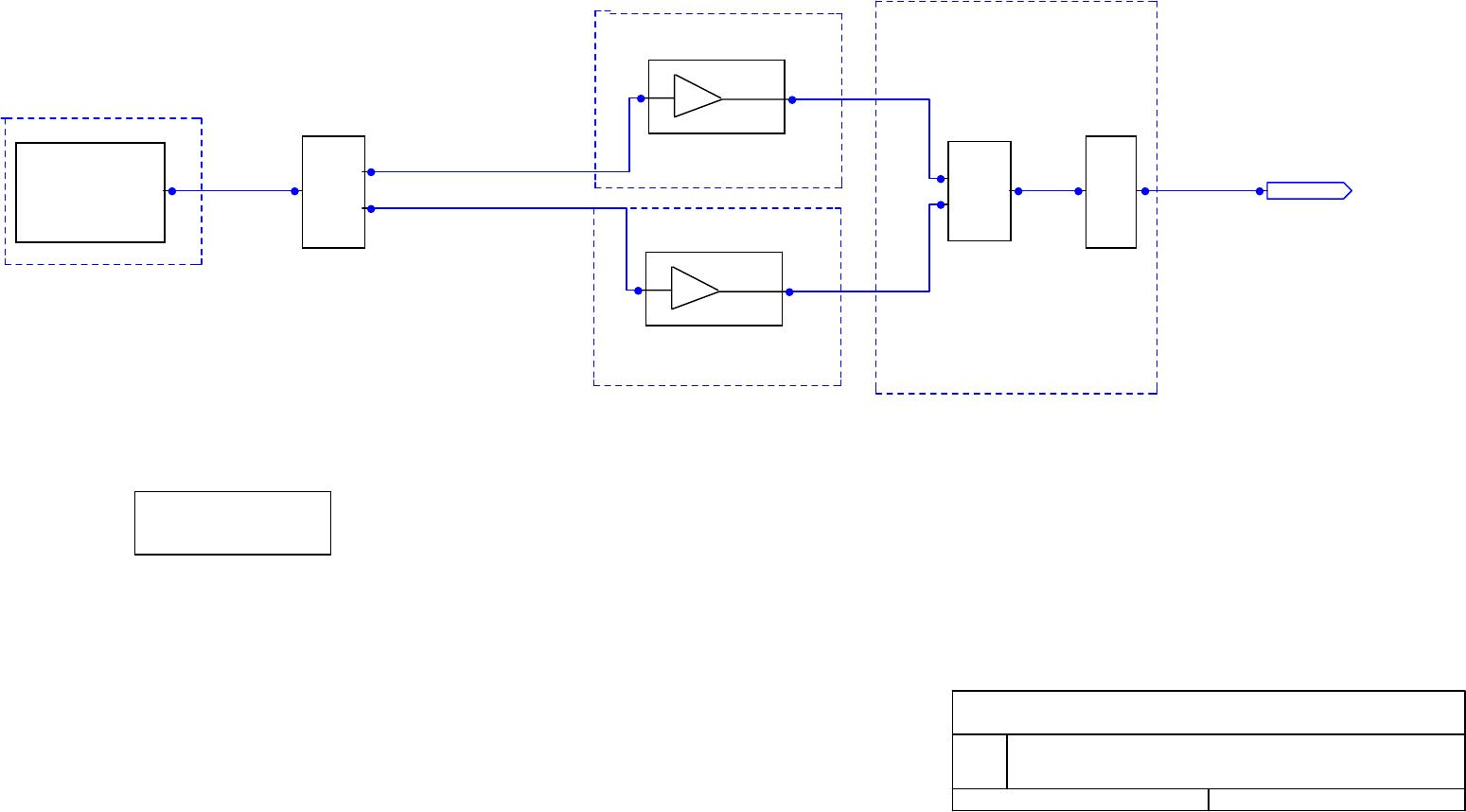
TAUD-500 AMPLIFIER
TAUD-500 AMPLIFIER
Modulator or
Processor
External
power
supply
COMBINER/FILTER
RF Out
TAUD-1000 BLOCK DIAGRAM
Date: November 17, 2008 Page: 1 of 1
Rev ID

III-3
Inside each of the 500-watt RMS power amplifiers, the signal passes through an RF attenuator
to limit the output power level of the power amplifier and to help buffer any transients that may
come into the power amplifier. After attenuation, the signal gets preamplified through a UHFTV-
50 driver amplifier before the signal gets split into (3) signals for final amplification using a 3-way
microstrip power divider. The final amplification stage is comprised of (3) BLF878 final
amplifiers. The outputs of the (3) final amplifier pallets are combined with a 3-way microstrip
combiner and pass through an isolator as illustrated in the following TAUD-500 block diagram.
After the isolator, the signal passes through a dual directional coupler before heading into the
combiner/filter enclosure.
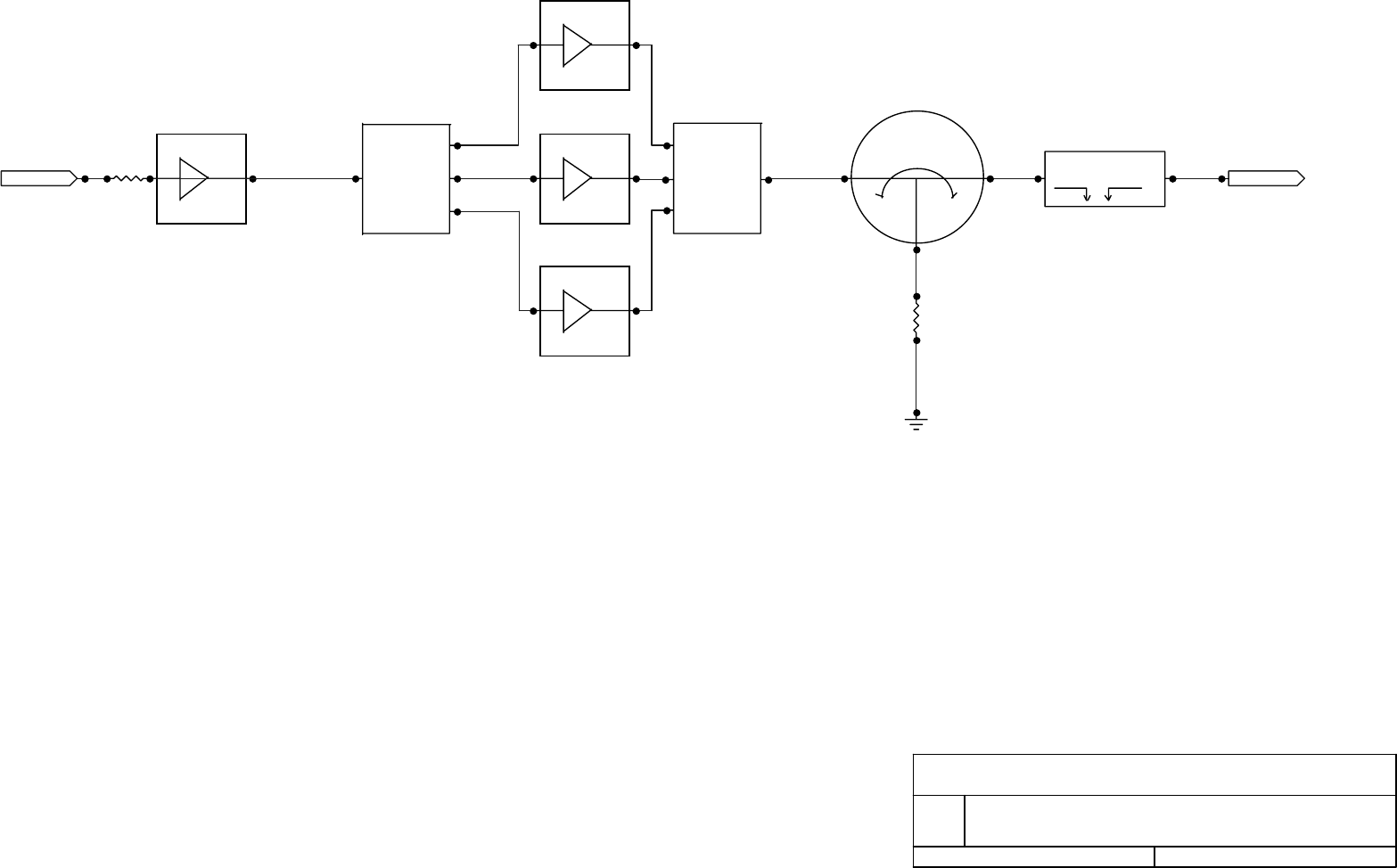
BLF878 FINAL
AMPLIFIER PALLET
BLF878 FINAL
AMPLIFIER PALLET
A=-0.05dB typical
A=-0.5dB typical
To Wattmeter
and Antenna
UHFTV-50 Driver
Pallet
3 WAY SPLIITER 3 WAY COMBINER
RF INPUT RF OUT
Directional C
TERMINATION
50 OHM
ATTENUATION
TAUD-500 ENCLOSURE
Date: NOVEMBER 29, 2010 Page: 1 of 1
Rev ID

III-4
After amplification, the signal exits the power amplifier enclosure and goes into the filter/coupler
enclosure. The two RF signals from each of the TAUD-500 amplifiers (500-watts RMS) get
combined by a 2-way, 90 degree combiner via phased cables. The amplified signals are filtered
with a bandpass filter and monitored again with another directional coupler before heading out
to the customers inline 8VSB reading wattmeter and then to an antenna for broadcast, as
depicted in the following filter/coupler block diagram.
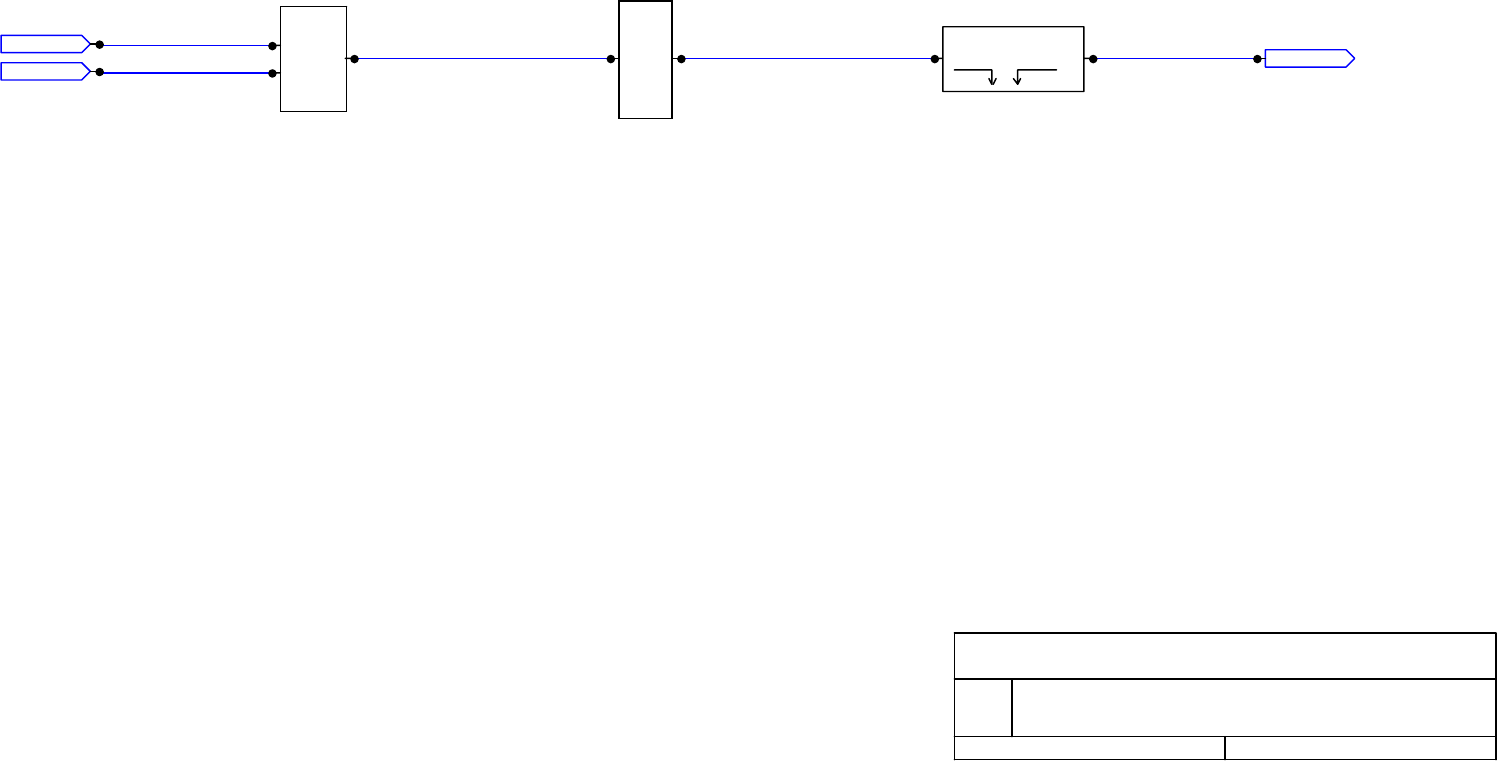
A=-0.6dB to -1.0dB
A=-0.05dB
A=-0.45dB
TO WATTMETER
AND ANTENNA
COMBINER DIRECTIONAL COUPLER
FILTER
RF OUT
PA2 OUT
PA1 OUT
TAUD-1000 COMBINER/FILTER ENCLOSURE
Date: November 17, 2008 Page: 1 of 1
Rev ID
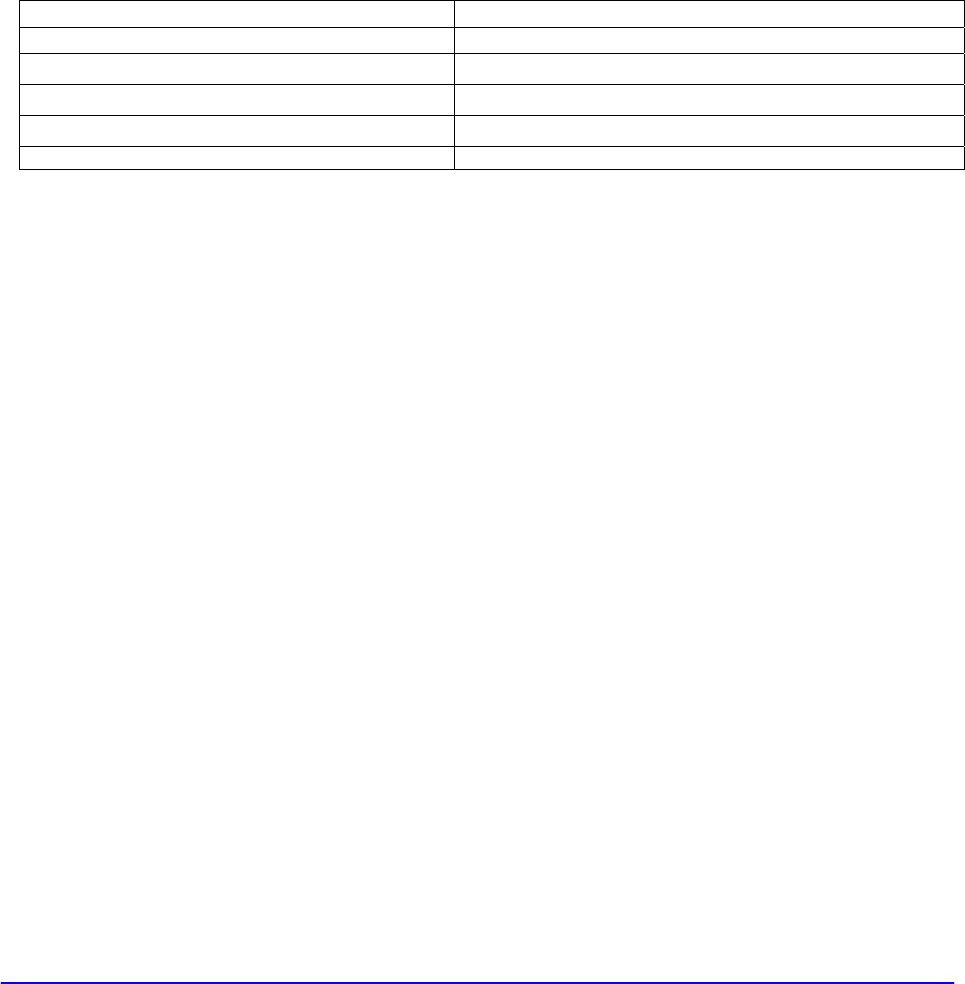
III-6
Specifications
Electrical specifications that are specific to the unit are included with the shipment in addition to
being kept on file at Technalogix
Physical Characteristics
Operating Temperature 0 - 50°C
Dimensions
TAUD-500 Power Amplifier (each) W-19" flange (17” encl.), D-25-¼", H-10 ½” (6U) each
Combiner/Filter W-19" flange (17” encl.), D-25-¼", H-10 ½” (6U)
Power Supply W-19" flange (17” encl.), D-25-¼", H-5 ¼” (3U)
TM600-8VSB Modulator (if supplied) W-19" flange (17” encl.), D-16", H-3 ½” (2U)

Technalogix Ltd TAUD-1000 Transmitter
IV-1
Section IV – RF Components
Amplifier Pallets
The UHFTV-50 driver pallet is also a linear class-AB pallet. It has a typical gain of 37dB and draws
no more than 3.0Adc total drain current. The quiescent and drain currents can be measured on the
UHFTV-50 by inserting an ammeter in series with the power supply lead to the pallet or by
measuring the voltage drop across the current sense resistor found directly at the DC power supply
lead input to the pallet. This resistance is 0.01-ohms, providing a 10mV per ampere ratio.
The BLF878 pallets used in the final amplification stage use LDMOS (Laterally Diffused Metal Oxide
Semiconductor) technology. LDMOS technology offers higher gain, efficiency and linearity over
standard MOSFET and Bipolar devices and enhances ruggedness and reliability. LDMOS
transistors have the added advantage of not having BEO (Beryllium Oxide) in their construction.
The BLF878 amplifier pallets have a typical gain of 17dB and draw no more than 25Adc. Currents
for these pallets must be measured with an ammeter in series with the power supply lead.
Each of the amplifier pallets is connectorized to optimize servicing and accessibility

Technalogix Ltd TAUD-1000 Transmitter
IV-4
Power Divider/Combiner (internal to each TAUD-500 enclosure)
A Wilkinson power divider and combiner (identical printed circuit boards) are used to split the RF
signal into, and combine the amplified RF signal out of the (3) BLF final amplifier pallets. Flanged
power resistors help ensure that any differences between the inputs or outputs are balanced.
The Wilkinson design takes advantage of the fact that an impedance transformation can take place
across a quarter-wavelength transmission line if the line has different impedance than the source or
load impedances being matched. In this case, quarter-wavelengths of 75-ohm coaxial are used to
maintain 50-ohm impedances at the input and output of the Wilkinson divider/combiner. Due to its
electrical and mechanical symmetry, the Wilkinson design’s performance over moderate
bandwidths is superior to other types. This design maintains phase and amplitude equality, in
addition to providing isolation and matched outputs.
Splitter/Combiner
The splitter and combiner are used to split the RF signal into, and combine the amplified RF signal
out of the (2) final amplifier pallets. The connectorized designs are based on the simple isolated
Wilkinson combiner design. Due to its electrical and mechanical symmetry, the Wilkinson design’s
performance over moderate bandwidths is superior to other types.
Directional Coupler
The Technalogix dual directional coupler provide DC voltages proportional to forward and reflected
RF power monitoring. These analog voltages are converted for processing using analog-to-digital
converters and provide the control system with valuable data for monitoring purposes. Output power
should be set following the operating procedure found elsewhere in this manual. The directional
coupler has a typical insertion loss of 0.5dB and its Type N connectors can handle 1,500 watts
peak. On higher power systems, 7/16 DIN connectors are used for increased power handling
capability.
Isolator
The power amplifier pallets are protected in part by the isolator located in the filter enclosure. It is
actually made up of a circulator and 50-ohm dump resistor. The circulators’ specifications include
an insertion loss of less than 0.2dB with an isolation rating better than 20dB. Any reflected power
gets dumped into the flanged power resistor. Even though the flanged power resistor is rated for
less than the transmitter’s rated power, the software will recognize quickly that reflected power is
present and turn the carrier off. This way, there is instantaneous protection due to the isolator setup
and long term protection due to the software.

Technalogix Ltd TAUD-1000 Transmitter
IV-5
Filter
The passive bandpass filter rejects spurious and harmonic output products and passes the channel
RF output. The cavity resonator uses aperture coupling and is a linear resonator design. Typical
insertion loss is 0.4 dB to 0.6 dB depending on channel frequency. The filter is DC grounded on
both the input and output for additional lightning protection.

Technalogix Ltd TAUD-1000 Transmitter
V-1
Section V – Power Supply
Switching AC-DC power supplies are used to power the amplifier pallets, the control circuits, and all
of the fans. There are switching supplies in the Power Supply enclosure that feed all of the amplifier
pallets and fans inside each of the two TAUD-500 amplifier enclosures that make the 1,000-watts
RMS. In addition, the Combiner/Filter enclosure has a small switching supply to feed the control
circuitry in that enclosure.
The power supplies found in the Power Supply enclosure are (2) Meanwell RSP-3000-48. The
switching power supply is fully protected against short circuit and output overload. Short circuit
protection is a cycling type power limit. The internal AC fuse is designed to blow only on a
catastrophic failure in the unit – the fuse does not blow on overload or short circuit. The thermal
shutdown automatically recovers when the power supply chassis cools down. AC (220Vac) is fed
into the power supply enclosure via a resettable circuit breaker. The power supplies are set at
48.0Vdc nominally. All fans in the Power Amplifier enclosure run off this same supply.
The power supply found in the Combiner/Filter enclosure is a Meanwell S60-24. It powers the
control PCBS in the Combiner/Filter enclosure. Its output voltage is set to 24.0 Vac.
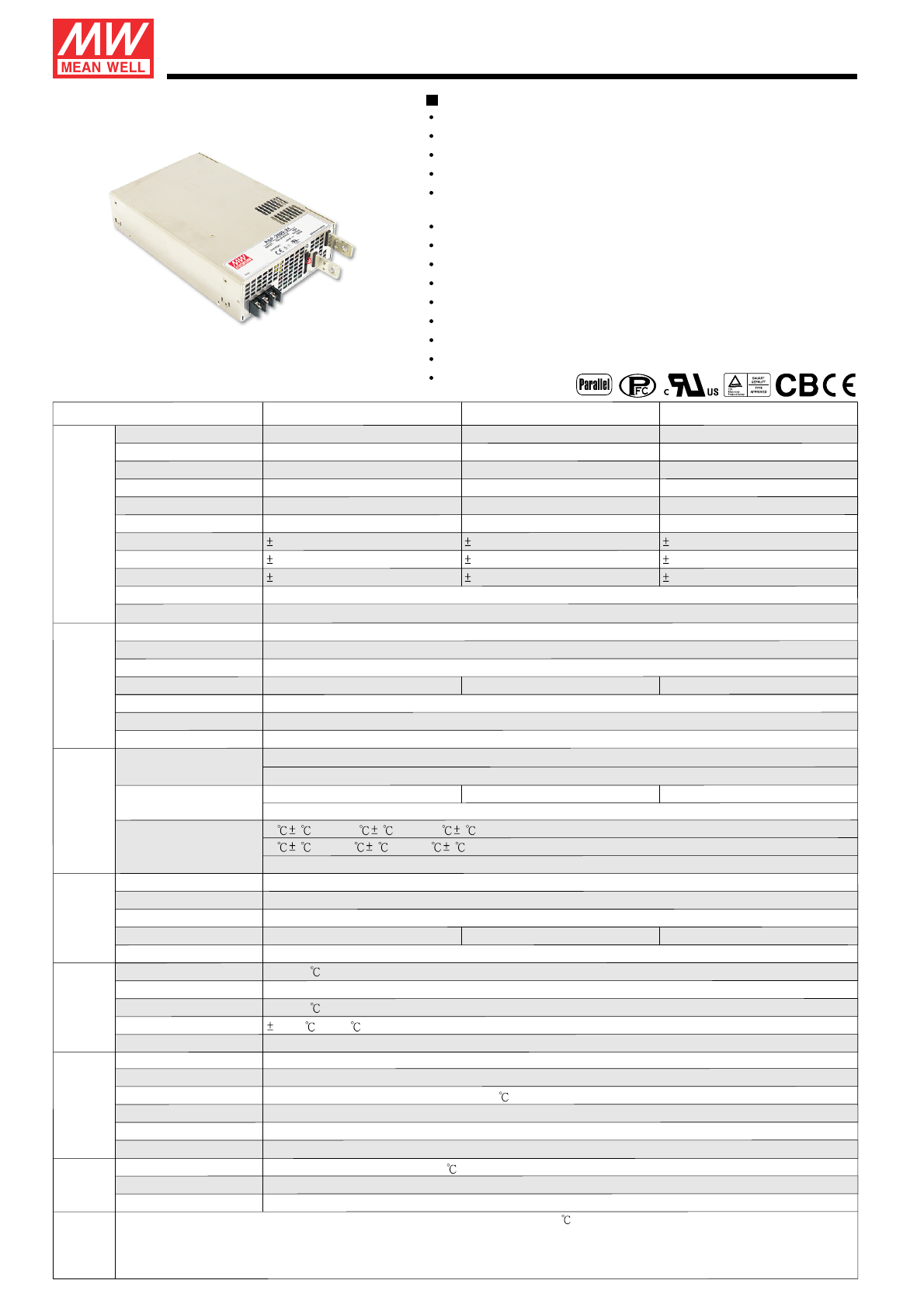
SPECIFICATION
RSP-3000-12
MODEL
DCVOLTAGE
RATEDCURRENT
CURRENTRANGE
RATEDPOWER
OUTPUT VOLTAGE ADJ.RANGE
LINEREGULATION
LOADREGULATION
SETUP,RISETIME
HOLDUP TIME (Typ.)
VOLTAGERANGE
FREQUENCY RANGE
EFFICIENCY (Typ.)
INPUT
INRUSHCURRENT (Typ.)
LEAKAGECURRENT
OVERTEMPERATURE
WORKINGTEMP.
CURRENTSHARING
OUTPUTVOLTAGETRIM
ALARMSIGNAL OUTPUT
REMOTEON/OFFCONTROL
AUXILIARY POWER(AUX)
WORKINGHUMIDITY
STORAGETEMP.,HUMIDITY
TEMP.COEFFICIENT
VIBRATION
MTBF
DIMENSIONOTHERS
NOTE
PACKING
OVERLOAD
OVERVOLTAGE
ACCURRENT (Typ.)
12V
200A
0~200A
2400W
150mVp-p
10.8~13.2V
1.0%
0.5%
0.5%
1000ms,80msatfullload
10msatfullload
180~264VAC254~370VDC
47~63Hz
86%
20A/180VAC16A/230VAC
60A/230VAC
<2.0mA /240VAC
100~112% ratedoutputpower
13.8~16.8V
Useradjustablecontinuousconstantcurrentlimitingorconstantcurrentlimitingwithdelayshutdownafter5seconds,re-powerontorecover
28.8~33.6V
4.8~28V
57.6~67.2V
9.6~56V
Protectiontype:Shutdowno/pvoltage,re-powerontorecover
Protectiontype:Shutdowno/pvoltage,recoversautomaticallyaftertemperaturegoesdown
-20~+70 (Refertooutputloadderatingcurve)
PleaseseetheFunctionManual
PleaseseetheFunctionManual
2.4~13.2V
PleaseseetheFunctionManual
12V@0.1A(OnlyforRemoteON/OFFcontrol)
20~90%RHnon-condensing
-40~+85 ,10~95%RH
0.05%/ (0~50 )
10~500Hz,2G10min./1cycle,60min.eachalongX, Y,Zaxes
104.5Khrsmin.MIL-HDBK-217F(25 )
278*177.8*63.5mm(L*W*H)
4Kg;4pcs/16Kg/1.89CUFT
90% 90.5%
0.5% 0.5%
0.5% 0.5%
1.0% 1.0%
150mVp-p
22~28V
200mVp-p
43~56V
24V
125A
0~125A
3000W
48V
62.5A
0~62.5A
3000W
RSP-3000-24 RSP-3000-48
1. All parameters NOT specially mentioned are measured at 230VAC input, rated load and 25 of ambient temperature.
2. Ripple & noise are measured at 20MHz of bandwidth by using a 12" twisted pair-wire terminated with a 0.1uf & 47uf parallel capacitor.
3. Tolerance : includes set up tolerance, line regulation and load regulation.
4. The power supply is considered a component which will be installed into a final equipment. The final equipment must be re-confirmed that it still meets
EMC directives.
FileName:RSP-3000-SPEC2009-09-21
POWERFACTOR (Typ.) 0.95/230VACatfullload
SAFETY STANDARDS
HARMONICCURRENT
EMSIMMUNITY
UL60950-1, TUVEN60950-1approved
CompliancetoEN55022(CISPR22)
Complianceto EN61000-3-2,-3
Complianceto EN61000-4-2,3,4,5,6,8,11;ENV50204,EN55024,lightindustrylevel,criteria A
3000WSingleOutputPowerSupply RSP-3000 seri es
RIPPLE&NOISE(max.) Note.2
VOLTAGETOLERANCE Note.3
EMICONDUCTION&RADIATION
WITHSTANDVOLTAGE
ISOLATIONRESISTANCE
I/P-O/P:3KVACI/P-FG:1.5KVACO/P-FG:0.5KVAC
I/P-O/P,I/P-FG,O/P-FG:100MOhms/500VDC /25 /70%RH
ENVIRONMENT
SAFETY &
FUNCTION
EMC
(Note4)
PROTECTION
AC input 180 ~ 264VAC
AC input active surge current limiting
High efficiency up to 90%
Built-in active PFC function,PF>0.95
Protections: Short circuit / Overload / Over voltage / Over temperature
/ Fan alarm
Forced air cooling by built-in DC with fan speed control function
Output voltage can be trimmed between 20~110% of the rated output voltage
High power density 15.6W/inch
Current sharing up to 3 units
Alarm signal output (relay contact and TTL signal)
Built-in 12V/0.1A auxiliary output for remote control
Built-in remote ON-OFF control
Built-in remote sense function
3 years warranty
3
Features :
90 5 (12V),110 5 (24V),105 5 (48V)(TSW1:detectonheatsinkofpowertransistor)
90 5 (12V),85 5 (24V),75 5 (48V)(TSW2:detectonheatsinkofo/pdiode)
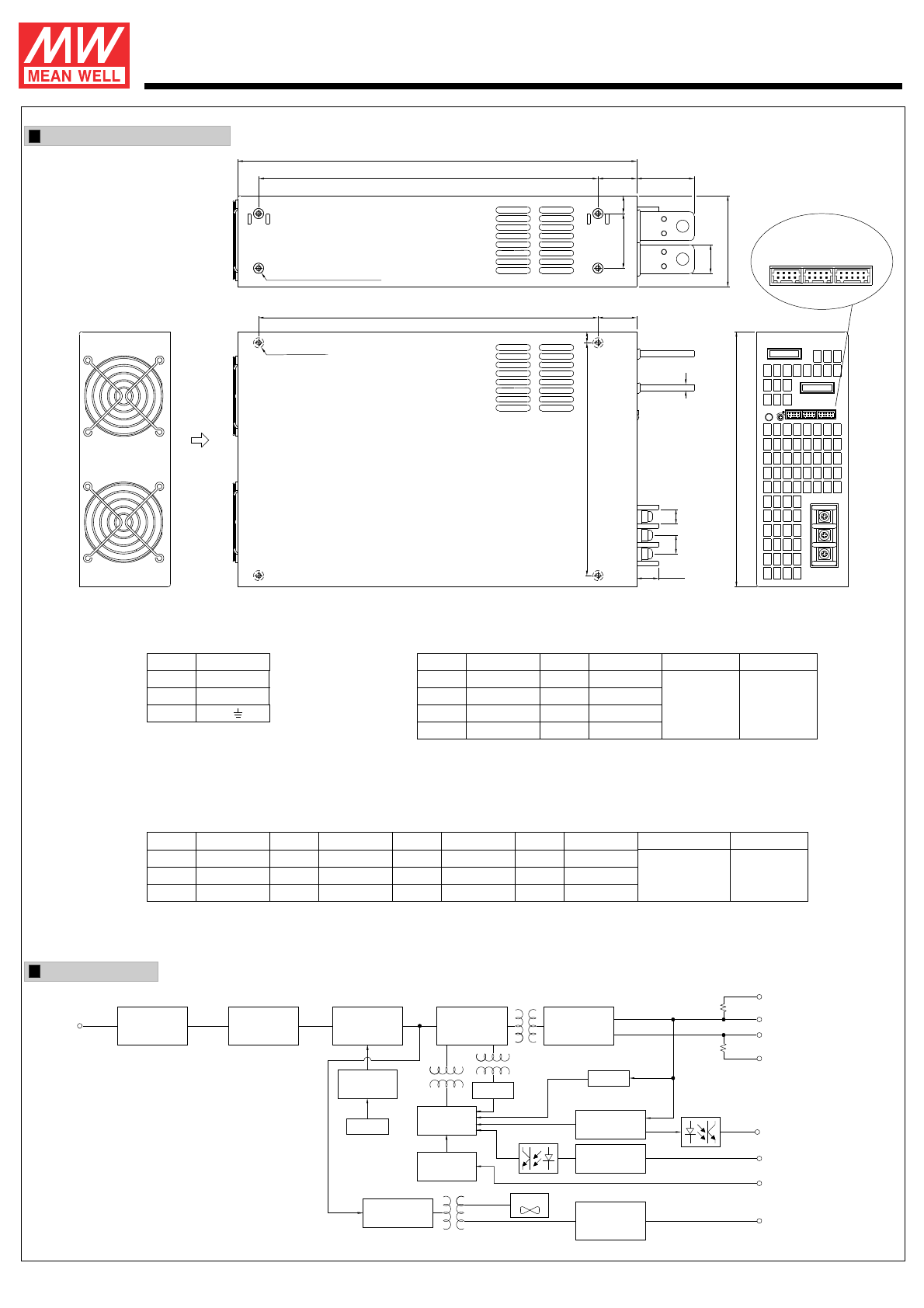
MechanicalSpecification
FileName:RSP-3000-SPEC2009-09-21
ACInput TerminalPinNo. Assignment
PinNo.
1
3
2
Assignment
AC/N
AC/L
FG
BlockDiagram PFCfosc:88KHz
PWMfosc:100KHz
FAN
O.V.P.
-V
+V
RECTIFIERS
&
FILTER
-S
+S
CIRCUIT
DETECTION
POWER
AUX
REMOTE
CONTROL RC
FILTER
&
RECTIFIERS AUXPOWER
(12V/0.1A)
SHARING
LOAD
CS
P OK
LIMITING
ACTIVE
CURRENT
INRUSH
CONTROL
I/P SWITCHING
POWER
RECTIFIERS
FILTER
EMI
PWM
&
PFC
PFC
CONTROL
O.T.P.
O.L.P.
CaseNo.982BUnit:mm
+
8-M4(BothSides)L=5mm
40
27
236.3
278
63.5
20
38
12.5
CN1
CN1
CN2
CN2
LED
SVR
CN3
CN3
TB1
1 2 3
177.8
16max.
+V
-V
OUTPUT
27
236.3
4-M4L=5mm
4
7.9
162
10
13
direction
Airflow
INPUT
PinNo. PinNo.
2
1
3
4
RCG:RemoteON/OFFGround
RC:
-S:-RemoteSensing
RemoteON/OFFCS:LoadShare
PV:OutputVoltageExternalControl+S:+RemoteSensing
PS:ReferenceVoltage Terminal
Assignment Assignment
RC
RCG
PV
PS
MatingHousing Terminal
orequivalent orequivalent
8
6
5,7
+S
-S
CS(CurrentShare)
ControlPinNo. Assignment(CN1,CN2):HRSDF11-8DP-2DS orequivalent
HRSDF11-8DS
HRSDF11-**SC
PinNo. PinNo. PinNo. PinNo.
3 6 9
2 5 8
P OKGND:PowerOKGround RCG:RemoteON/OFFGround AUX: AuxiliaryOutput
P OK:PowerOKSignal(RelayContact) RC:RemoteON/OFF OLP:OLP/OL-SD:OLP modeselect
P OK2:PowerOKSignal(TTL Signal) AUXG: AuxiliaryGround
1 4 7 10
Assignment Assignment Assignment Assignment
P OKGND2
P OK
P OKGND
MatingHousing Terminal
orequivalent orequivalent
ControlPinNo. Assignment(CN3):HRSDF11-10DP-2DS orequivalent
HRSDF11-10DS
HRSDF11-**SC
RC OLP
RCG AUX
P OK2 AUXG OL-SD
8
8
6
6
4
4
2
2
1
1
3
3
5
5
7
7
10
10
9
9
8
8
6
6
4
4
2
2
1
1
3
3
5
5
7
7
8
8
6
6
4
4
2
2
1
1
3
3
5
5
7
7
3000WSingleOutputPowerSupply R SP-30 00 s e r ies
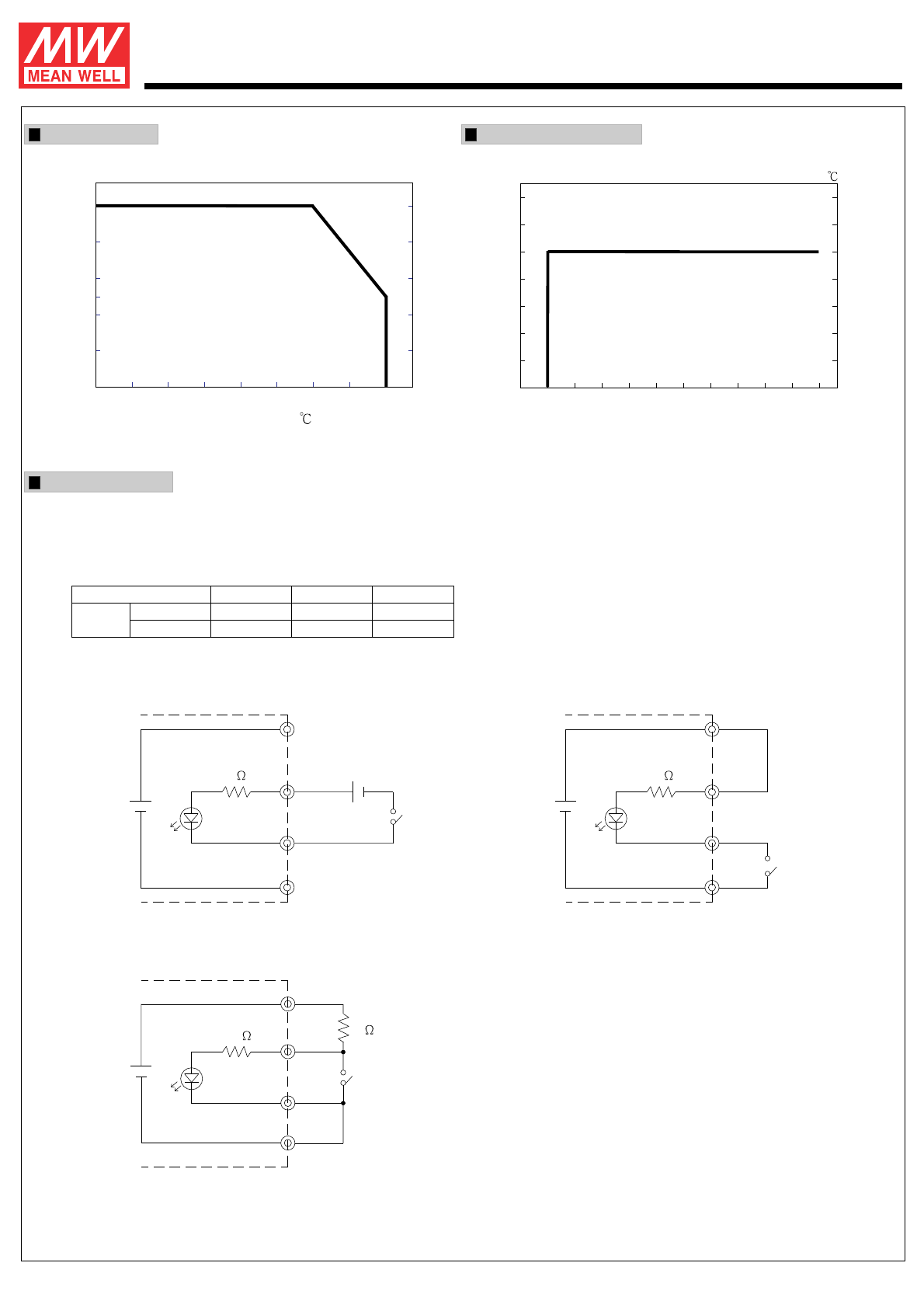
FunctionManual
1.RemoteON/OFF
(1)RemoteON/OFFcontrolbecomesavailablebyapplyingvoltageinCN1&CN2&CN3.
(2)Table1.1showsthespecificationofRemoteON/OFFfunction.
(3)Fig.1.2showstheexampletoconnectRemoteON/OFFcontrolfunction.
FileName:RSP-3000-SPEC2009-09-21
Table1.1SpecificationofRemoteON/OFF
Fig.1.2ExamplesofconnectingremoteON/OFF
ConnectionMethod
SWLogic Outputon SWOpen SWOpen
SWOpen
Fig.1.2(A) Fig.1.2(B) Fig.1.2(C)
Outputoff SWClose SWClose
SWClose
AUX
12Vtyp.
AUXG
1K
RCG
RC
SW
12V 1K RC
12Vtyp.
RCG
AUXG
AUX
(A)Usingexternalvoltagesource (B)Usinginternal12Vauxiliaryoutput
SW
1K RC
12Vtyp.
AUXG
SW
RCG
(C)Usinginternal12Vauxiliaryoutput
AUX
DeratingCurve StaticCharacteristics
AMBIENTTEMPERATURE( )
LOAD(%)
20
40
60
50
80
100
-20 0 10 20 30 40 50 60 70
INPUTVOLTAGE(V)60Hz
100
90
80
70
60
LOAD(%)
Ta=25
180 185 190 195 200 210 220 230 240 250 264
(HORIZONTAL)
3000WSingleOutputPowerSupply R SP- 30 00 se r ies
1K
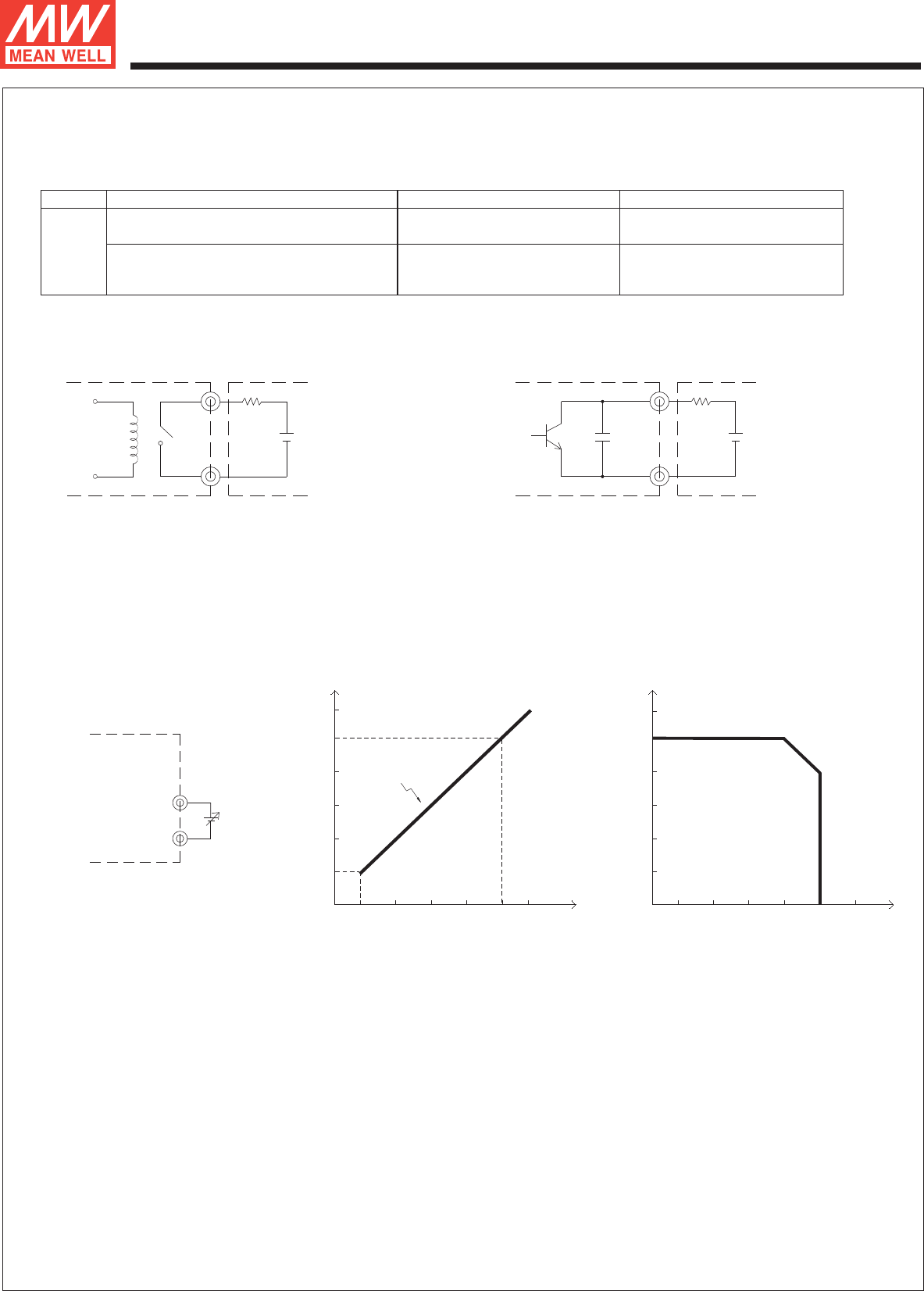
3.Output Voltage TRIM
(1)Connecting an external DC source between PV and-S on CN1 or CN2 that is shown in Fig. 3.1.
(2)Adjustment of output voltage is possible between 20~110%(Typ.) of the rated output which is shown in Fig. 3.2. Reducing output current is required when the
output voltage is trimmed up.
2.Alarm Signal Output
(1)Alarm signal is sent out through "P OK" & "P OK GND" and P OK2 & P OK GND2 pins.
(2)An external voltage source is required for this function.
(3)Table 2.1 explain the alarm function built-in the power supply.
Fig. 2.2 Internal circuit of P OK (Relay, total is 10W)
Fig. 3.1 Add on 1~6V external voltage
Fig. 3.2 Output voltage trimming
External voltage and R
(The max. sink is 500mA and 20V)
POKGND
POK
Function
POK
The signal is "Low" when the power supply is
80% of the rated output voltage-Power OK
above Low (0.5V max at 500mA) Low (0.5V max at 10mA)
Description Output of alarm(P OK, Relay Contact) Output of alarm(P OK2, TTL Signal)
The signal turns to be "High" when the power supply
is under 80% of the rated output voltage-Power Fail
High or open
(External applied voltage, 500mA max.)
High or open
(External applied voltage, 10mA max.)
R
V
Fig. 2.3 Internal circuit of P OK2 (Open collector method)
External voltage and R
(The max. sink is 10mA and 30V)
P OK GND2
POK2
R
V
0.1uF
Table 2.1 Explanation of alarm
123456 V
Vout
100
120
40
60
80
20
OUTPUT VOLTAGE (%)
EXTERNAL VOLTAGE (DC)
Non-Linear
OVP >120%
40 60 80 100 120 V
100
40
60
80
20
OUTPUT CURRENT (%)
OUTPUT VOLTAGE (%)
20
PV
1~6V
-S
File Name:RSP-3000-SPEC 2009-09-21
3000W Single Output Power Supply RSP-3000 series
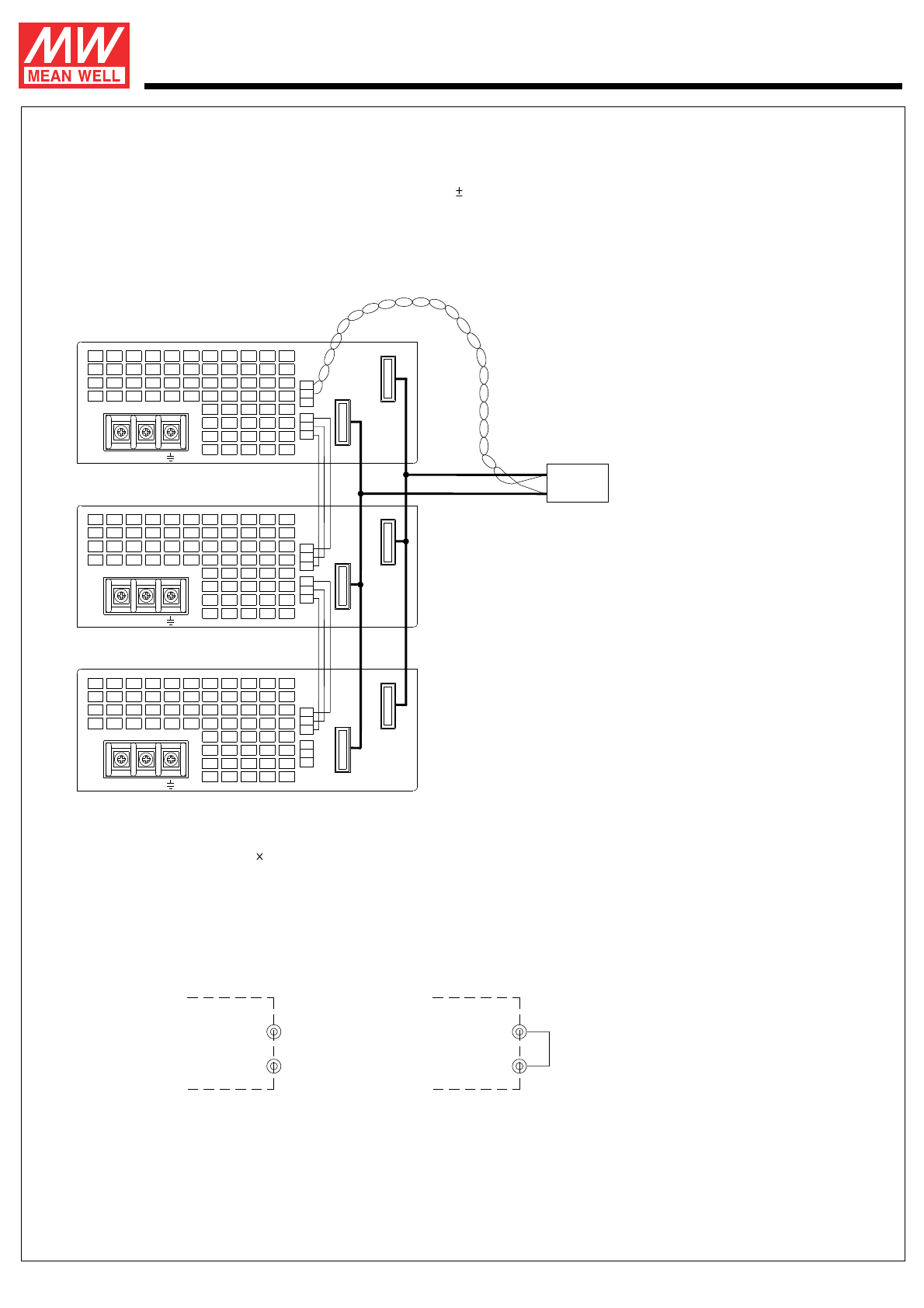
Fig.5.1RemovetheCN3 Fig.5.2InserttheCN3
OL-SD OL-SD
OLP OLP
FileName:RSP-3000-SPEC2009-09-21
3000WSingleOutputPowerSupply R SP- 30 00 se r ies
4.CurrentSharing
5.SelectO.L.P mode
(1)Paralleloperationisavailablebyconnectingtheunitsshownasbelow
(1)RemovetheshortingconnectoronCN3thatisshowninFig5.1,theO.L.P.modewillbe"continuousconstantcurrentlimiting".
(2)InserttheshortingconnectoronCN3thatisshowninFig5.2,theO.L.P.modewillbe"constantcurrentlimitingwithdelayshutdownafter5seconds,
re-powerontorecover.
(+S,-SandCSareconnectedmutuallyinparallel):
(2)Thevoltagedifferenceamongeachoutputshouldbeminimizedthatlessthan 2%isrequired.
(3)Thetotaloutputcurrentmustnotexceedthevaluedeterminedbythefollowingequation.
(4)Inparalleloperation3unitsisthemaximum,pleaseconsultthemanufacturerforotherapplications.
(5)Whenremotesensingisusedinparalleloperation,thesensingwiremustbeconnectedonlytothemasterunit.
(6)Wiresofremotesensingshouldbekeptatleast10cmfrominputwires.
(7)Wheninparalleloperation,theminimumoutputloadshouldbegreaterthan2%oftotaloutputload.
(Min.Load>3%ratedcurrentperunit numberofunit)
(8)Underparalleloperation,the"outputvoltagetrim"functionisnotavailable.
(Outputcurrentatparalleloperation)=(Theratedcurrentperunit)x(Numberofunit)x0.9
AC/L
AC/L
AC/L
No.1(Master)
No.2(Slave)
No.3(Slave)
AC/N
AC/N
AC/N
-V
-V
-V
+V
+V
+V
CN1
CN1
CN1
CN2
CN2
CN2
+S
+S
+S
+S
+S
+S
-S
-S
-S
-S
-S
-S
CS
CS
CS
CS
CS
CS
Load
+V
-V
+S
-S
OLP Mode:constantcurrentlimiting OLP Mode:constantcurrentlimitingwithdelayshutdownafter5seconds
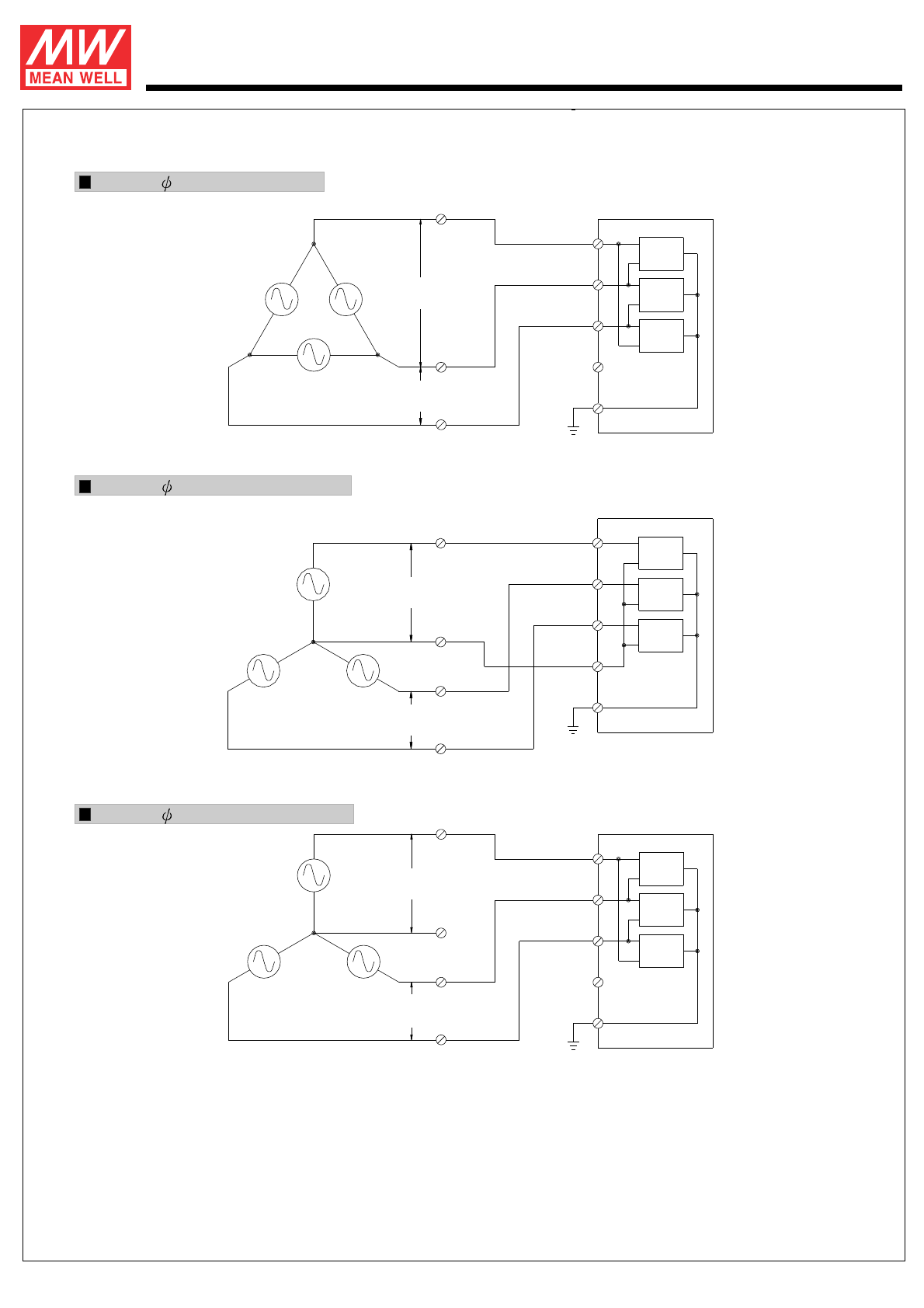
FIG.B:3 4W220/380VACSYSTEM
FIG.C:3 W190/110VACSYSTEM4
FileName: RSP-3000-SPEC2009-09-21
FIG. A:3 3W220VACSYSTEM (STANDARDMODEL FORSTOCK)
R
N
S
T
220V 220V
FG1
N1
L1
FG
R
SL2
N2 FG2
TL3
N3 FG3
N
(N.C.)
T
S
N
R
FG1
N1
L1
FG
R
SL2
N2 FG2
TL3
N3 FG3
N(NC)
R
S
T
FG1
N1
L1
FG
R
SL2
N2 FG2
TL3
N3 FG3
N(NC)
220V
380V
110V
190V
3000WSingleOutputPowerSupply R SP -30 00 s e ries
6.ThreePhaseConnect
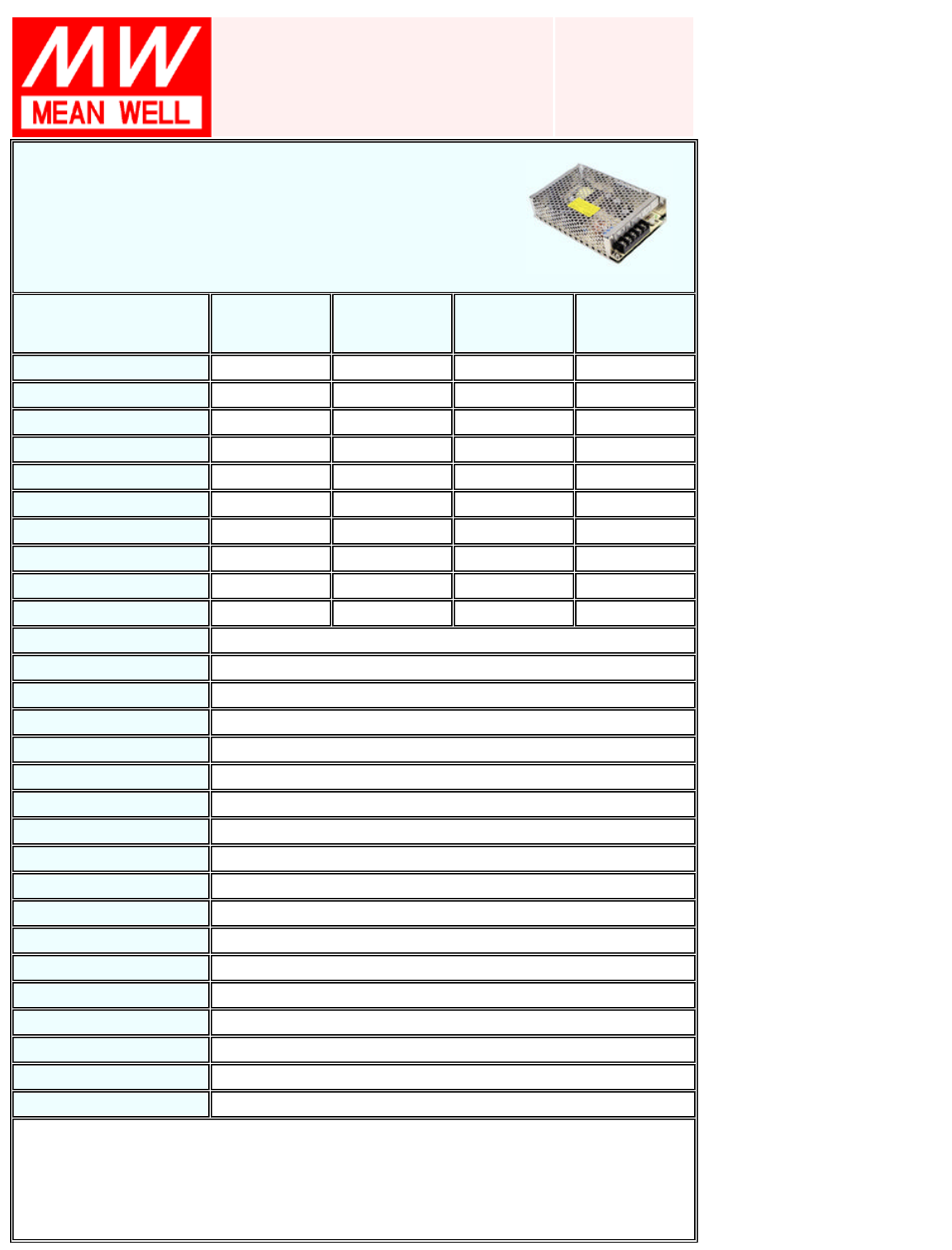
MEAN WELL
SWITCHING POWER SUPPLY
ISO-9001 CERTIFIED MANUFACTURER
S-60
SERIES
.LOW COST, HIGH RELIABILITY .COMPACT SIZE, LIGHT WEIGHT
.105ºC OUTPUT CAPACITOR .100% FULL LOAD BURN-IN TEST
.INTERNATIONAL AC INPUT RANGE .BUILT IN EMI FILTER, LOW RIPPLE NOISE
.HIGH EFFICIENCY, LOW WORKING TEMPERATURE
.SOFT-START CIRCUIT, LIMITING AC SURGE CURRENT
.SHORT CIRCUIT, OVERLOAD, OVER VOLTAGE PROTECTED
MODEL
SPECIFICATION S-60-5S-60-12 S-60-15 S-60-24
DC OUTPUT VOLTAGE 5V 12V 15V 24V
OUTPUT V. TOLERANCE ±2% ±1% ±1% ±1%
OUTPUT RATED CURRENT 12A 5A 4A 2.5A
OUTPUT CURRENT RANGE 0-12A 0-5A 0-4A 0-2.5A
RIPPLE & NOISE 120mVp-p120mVp-p150mVp-p150mVp-p
LINE REGULATION ±0.5% ±0.5% ±0.5% ±0.5%
LOAD REGULATION ±1% ±0.5% ±0.5% ±0.5%
DC OUTPUT POWER 60W 60W 60W 60W
EFFICIENCY 73% 76% 77% 79%
DC VOLTAGE ADJ. +10,-5% ±10% ±10% ±10%
INPUT VOLTAGE RANGE 85~264VAC 47~63Hz; 120~370VDC
AC CURRENT 2A/115V 1A/230V
INRUSH CURRENT COLD START 30A/115V 60A/230V
LEAKAGE CURRENT <3.5mA/240VAC
OVERLOAD PROTECTION 105%~150% TYPE:PULSING HICCUP SHUTDOWN RESET:AUTO RECOVERY
OVER VOLTAGE PROTECTION 115%~135%
OVER TEMP. PROTECTION ----------
TEMP. COEFFICIENT ±0.03% / ºC (0~50ºC)
SETUP, RISE, HOLD UP TIME 800ms, 50ms, 10ms / 115VAC 300ms, 50ms, 80ms / 230VAC
VIBRATION 10~500Hz, 2G 10min./1cycle, PERIOD FOR 60min. EACH AXES
WITHSTAND VOLTAGE I/P-O/P:3KVAC I/P-FG:1.5KVAC O/P-FG:0.5KVAC
ISOLATION RESISTANCE I/P-O/P, I/P-FG, O/P-FG:500VDC / 100M Ohms
WORKING TEMP., HUMIDITY -10ºC~+60ºC(REFER TO OUTPUT DERATING CURVE), 20%~90% RH
STORAGE TEMP., HUMIDITY -20ºC~+85ºC, 10%~95% RH
DIMENSION 159*97*38mm CASE:901
WEIGHT 0.55Kgs
SAFETY STANDARDS UL1012, TUV EN60950, IEC950, UL1950 APPROVED
EMC STANDARDS CISPR22 (EN55022), IEC801-2,3,4, IEC555-2 VERIFICATION
NOTE : 1.ALL PARAMETERS ARE SPECIFIED AT 230VAC INPUT, RATED LOAD, 25ºC 70% RH. AMBIENT.
2.TOLERANCE GINCLUDE SET UP TOLERANCE, LINE REGULATION, LOAD REGULATION.
3.RIPPLE & NOISE ARE MEASURED AT 20MHz BY USING A 12" TWISTED PAIR TERMINATED WITH A 0.1uF & 47uF CAPACITOR.
4.LINE REGULATION IS MEASURED FROM LOW LINE TO HIGH LINE AT RATED LOAD.
5.LOAD REGULATION IS MEASURED FROM 0% TO 100% RATED LOAD.
6.C2,3,6 MUST BE REMOVED. 2000-10-03

Technalogix Ltd Adrenaline Control System
VI-1
Section VI – Monitor and Control System
Control System Overview (Adrenaline)
The Adrenaline control system is used for a variety of functions, the most important of which is
ensuring that the transmitter continues to operate in a safe manner. The control system also
allows the user to monitor and control the transmitter from both the front panel and remotely
through the parallel port, Ethernet, or SNMP access port (some features optional).
The Adrenaline control system is comprised of three modules. These modules work together to
provide all the functions of the control system and include: Display Interface, RF, and
Temperature Sensor modules. In higher power/multiple pallet systems, a fourth module (DC
Distribution) is included. The operation of each module is outlined in the following sections and
illustrated in the following block diagram.
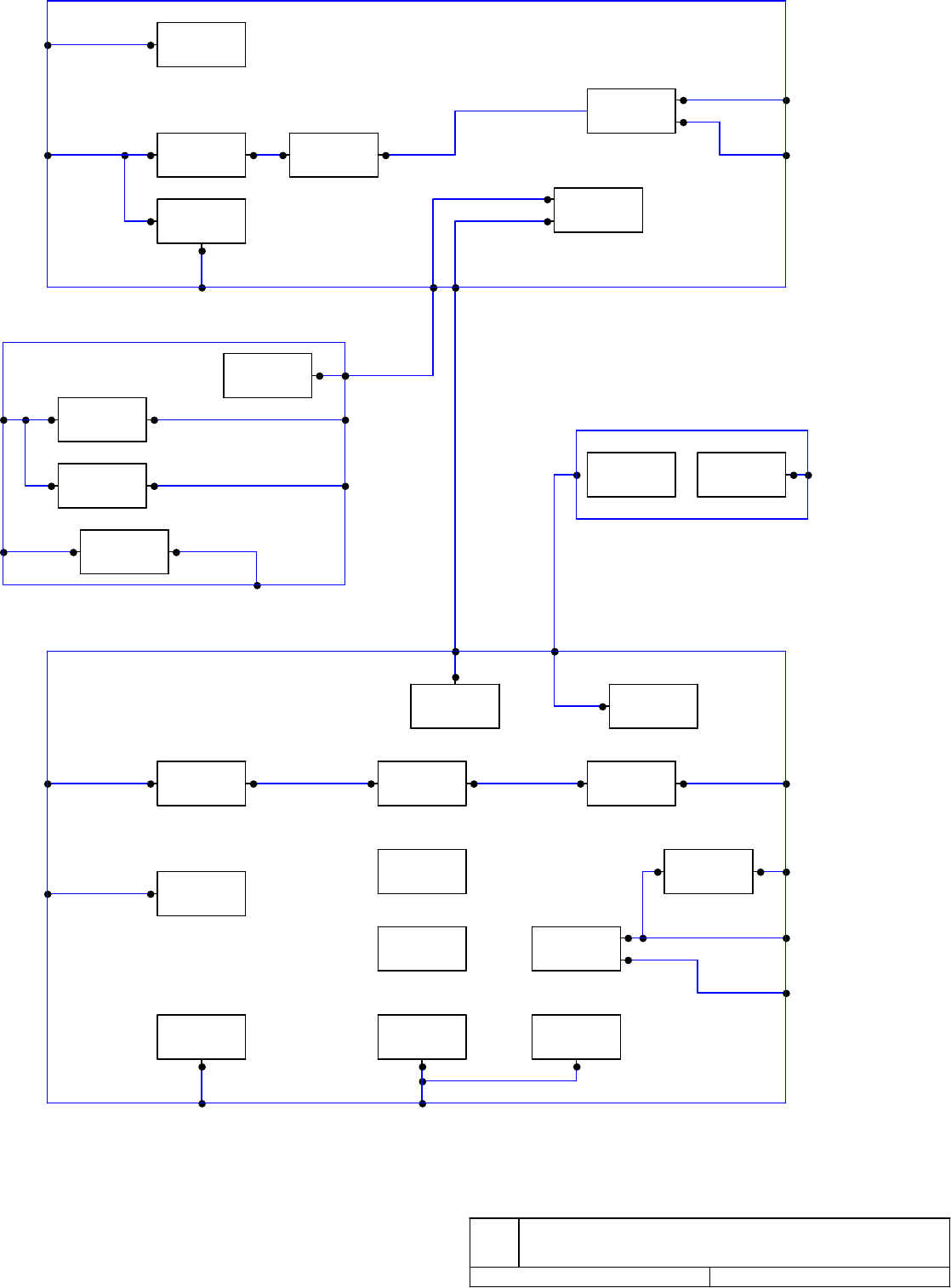
RF SHUTDOWN
EXTERNAL
SHUTDOWN
SHUTDOWN
INTERFACE
DC DISTRIBUTION
DC
OUT
FAN
CURRENT
MONITORING
DC IN
PALLET
CURRENT
MONITORING
CAN
INTERFACE
CAT5
CAN
INTERFACE
RF
TAPOFF
TEMP AND
SHUTDOWN
INTERFACE
CAT5
REAL
TIME
CLOCK
AUDIO
PROCESSING
(FM)
SNMPETHERNET
DB25 PARALLEL
INTERFACE
REMOTE
PORT
RF
SHUTDOWN
FAULT
COMPARATORS
SYSTEM
MEASUREMENTS
RF IN
VARIABLE
ATTENUATOR
RF IN
LEVEL
MONITORING
PHASE
ADJUST
DC OUT
DC IN
PANEL
SWITCH
INTERFACE
MEMBRANE
SWITCH
CAT5
DISPLAY
INTERFACE
TOUCHSCREEN
RF TEST
POINT
RF TO GAIN
STAGES
FWD
RFL
RF SAMPLE
FROM
COUPLER
RF-TO-DC
CONVERTER
TEMP
SENSOR
SHUTDOWN
INTERFACE
RF
TEMPERATURE SENSOR
RJ45
INTERFACE
DISPLAY INTERFACE
+5V
SWITCHING
SUPPLY
CHARACTER
LCD
CONTRAST
SUPPLY
EXTERNAL
DC-DC
CONVERTER
CAN
INTERFACE
Adrenaline Block Diagram
Date: September 15, 2010 Page: 1 of 1
Rev ID
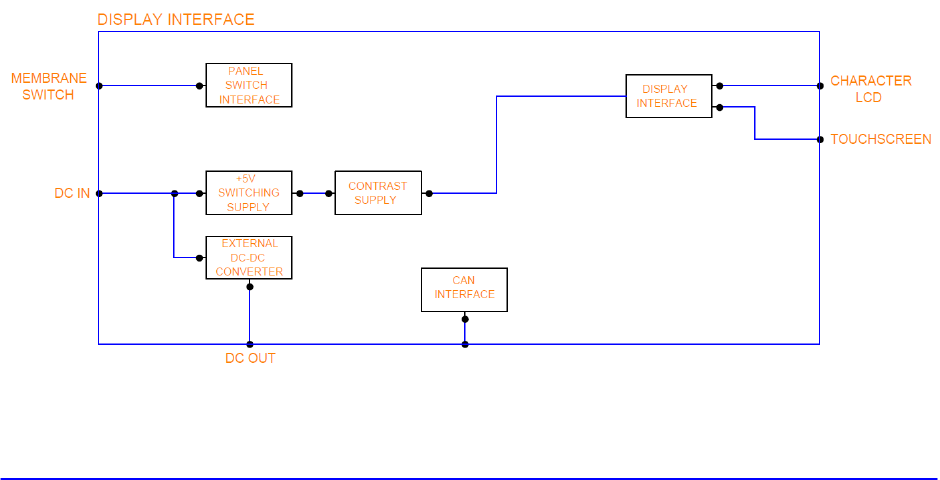
Technalogix Ltd Adrenaline Control System
VI-3
Display Interface Module
REV 1.01 (ASY 015)
Touchscreen Option
The primary function of the Display Interface module is, as the name suggests, providing the
display and user interface for the control system. This circuit board is mounted behind the front
panel of the power amplifier enclosure(s) in the transmitter/translator, near the 4.3” touchscreen
display. All switch/settings and user interface is handled through the resistive touchscreen. The
touchscreen on the front panel is connected to the Display Interface PCB through a cable.
These components provide the user with the ability to monitor the following power amplifier
parameters from the front panel:
• Forward (incident) power at the power amplifier output.
• Reflected (reverse) power at the power amplifier output.
• DC voltage of the power amplifier’s power supply.
• DC current in the power amplifier.
• Temperature of the heat sink of the power amplifier.
• The time since the transmitter/translator was last shut down.
• Full history of faults and events
• Mode of the power amplifier (selectable between Manual and AGC).
• Indication if there is attenuation added to the front end of the power amplifier indicating
fold back in RF power (indicates amount of attenuation)
• Settings to change the VSWR trip point shutdown between 1.1:1 and 1.8:1.
• Settings to change the RF power units between % power (maximum of 110%) or watts.
• Summary of PCB modules and assembly numbers specific to the power amplifier
A block diagram of the Display Interface PCB follows:

Technalogix Ltd Adrenaline Control System
VI-4
The hardware of the Display Interface module is based around microcontroller (U101). This part
interfaces directly with the touchscreen to provide output and receive input from the user. It
also communicates with the RF board (and DC Distribution Module, if installed) over a
Controller Area Network (CAN) bus. This communication is facilitated by U103, and passes
through a CAT5 cable attached to connector J104. The communication link with the RF module
allows the Display Interface Module to receive information about the forward power, reflected
power, and temperature of the transmitter, as well as relay commands from the user to the rest
of the system. If the DC Distribution Module is installed (on higher power systems with multiple
pallets), then the Display Interface receives DC currents from the DC Distribution via the same
CAN bus.
Other elements of the Display Interface module are also controlled by the microcontroller. A
buzzer (BZ101) and software status LED (D101), which flashes when the software /
microcontroller is running, are all controlled through a buffer (U102). DC supply enters through
connector J103, which powers the PCB and also the optional DC-DC converter (based around
U111), if populated. The PCB voltage is regulated at +5V by U106 and associated circuitry. If
the PCB is populated for FM broadcast, then the PWM filter circuit (based around U104) is also
populated and provides a DC output control voltage on pin 3. The touchscreen interfaces to the
Display Interface via connector J107.
The fuses on the Display Interface are all resettable. F102 protects the +5V line while F101
protects the DC-DC converter, if installed.
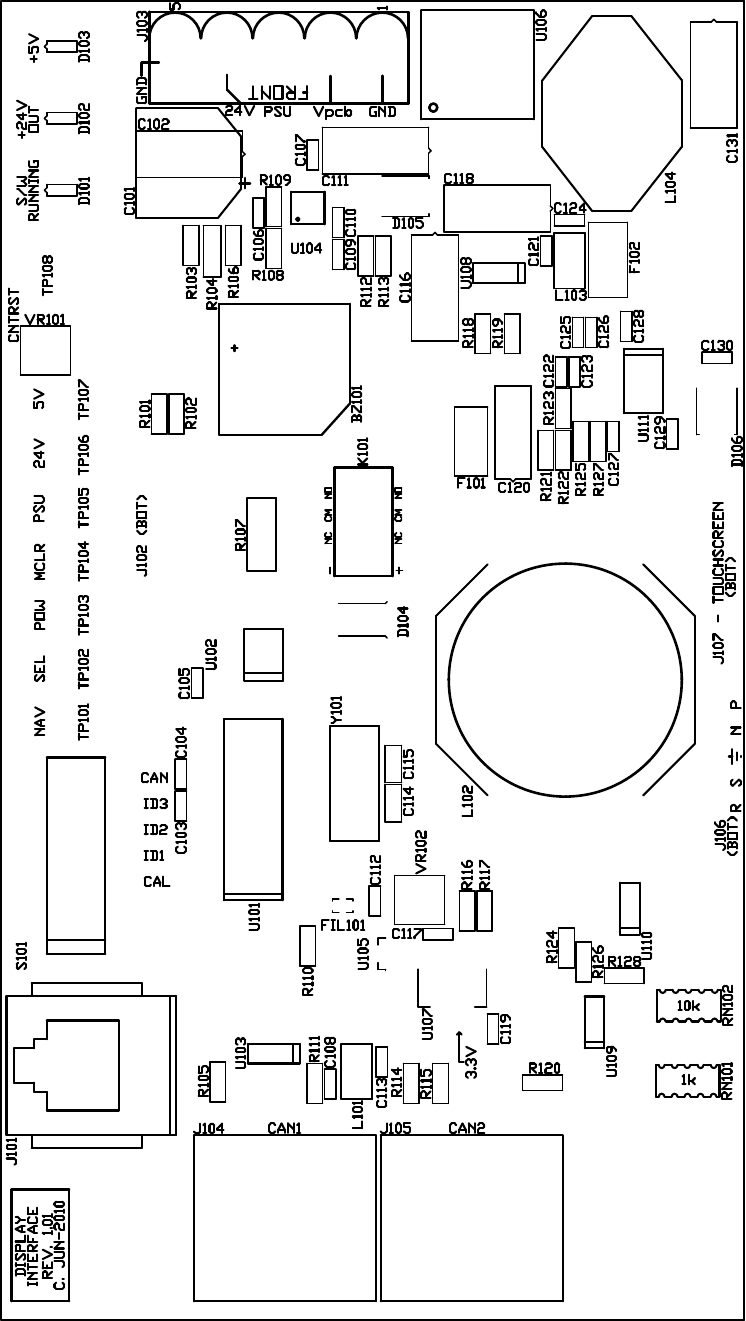
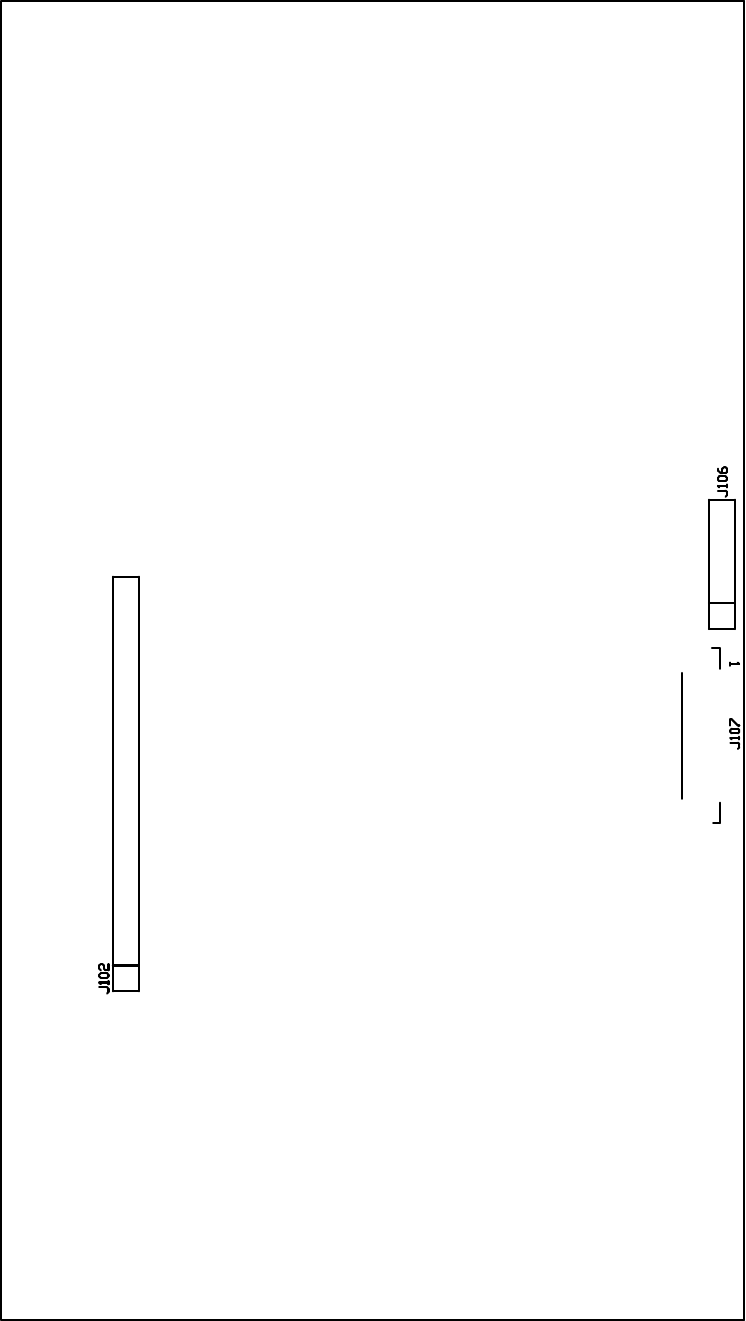
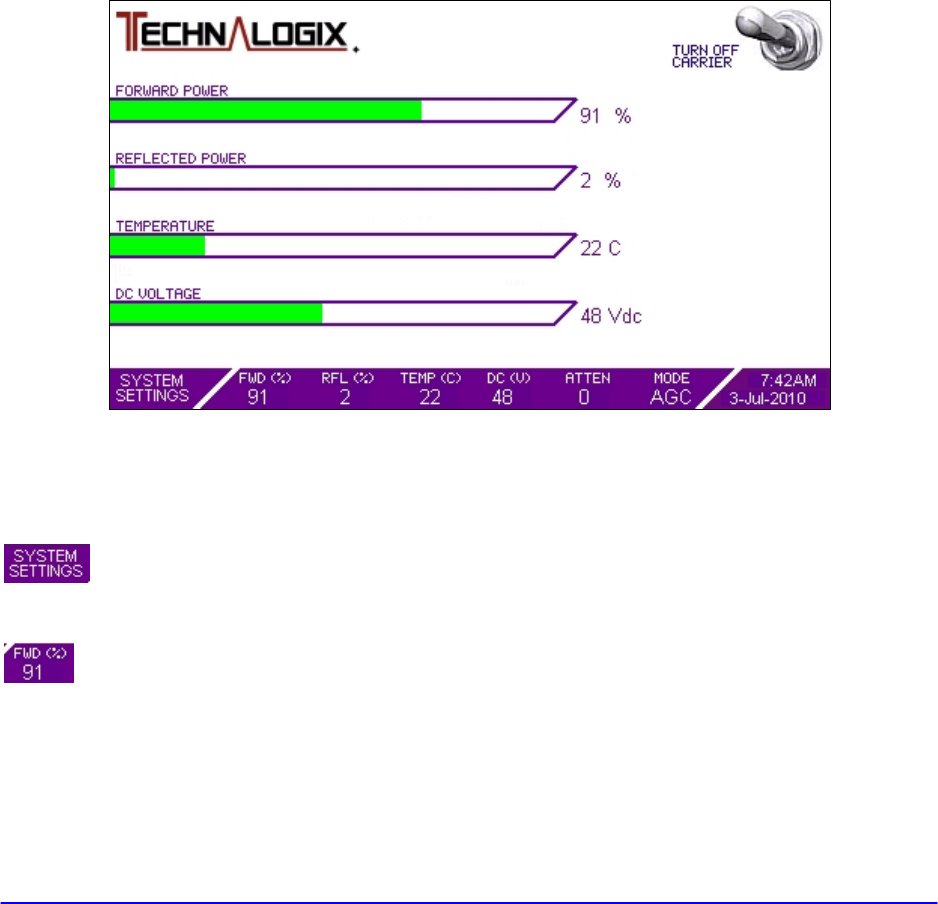
Technalogix Ltd Adrenaline Control System
VI-10
Main Screen
From the screen shot of the main screen, as seen in the figure below, all of the system’s main
parameters can be viewed at a quick glance. The three main sections of this screen are the four
level bars, the summary bar at the bottom of the screen, and the carrier ON/OFF button. The
level bars show real time system performance and help illustrate any transient changes that
occur. The FORWARD POWER and REFLECTED POWER level bars can also be shown in
watts (a full description of how to do this is found in the SETTINGS section. The summary bar at
the bottom of the screen will stay in place no matter what screen is being viewed to allow for an
operating summary at any time. Also from any screen, the transmitter’s carrier can be turned on
or off to facilitate adjustments, settings, and testing/troubleshooting.
The following breakdown describes the Main Screen features in further detail:
Toggles between Main Screen and Menu Screen. The menu screen has
additional settings and monitoring over the Main Screen, and is illustrated in the
next section.
Forward RF power level in % out of 100 or watts. Mimics data from level bar.
Overdrive protection starts at 110% where the power amplifier folds back power
by adding attenuation to the power amplifier input until a safe level obtained.
System continually checks power level and tries to bring RF power level back to
where it was when the fault occurred. If overdrive occurs, a warning is also
displayed in red text near the top of the touchscreen and the event recorder logs
the event.
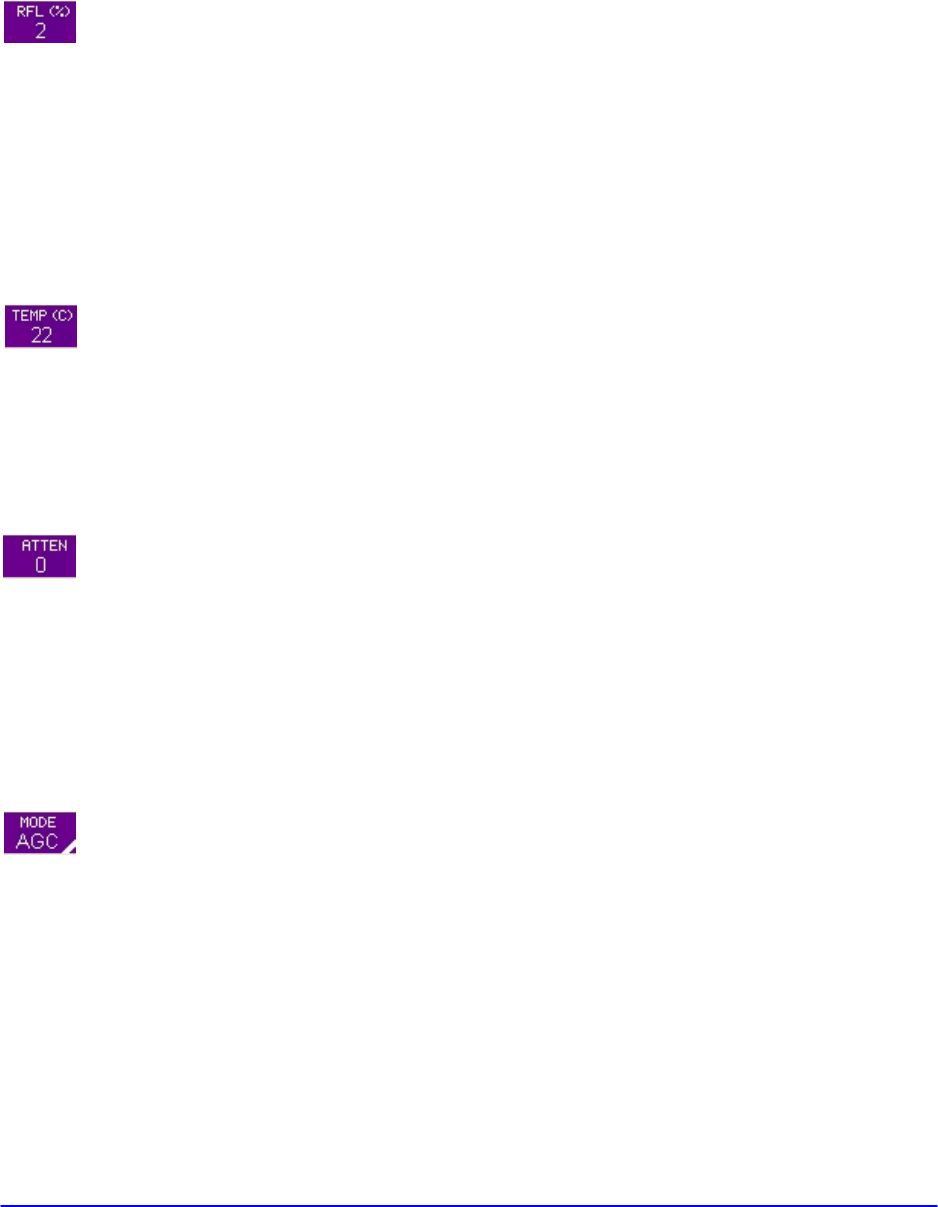
Technalogix Ltd Adrenaline Control System
VI-11
Reflected RF power level in % out of 100 or watts. Mimics data from level bar.
The high VSWR fault occurs when the measured VSWR of the system exceeds
the user-defined VSWR trip point found in the RF Power Menu, described later in
this section. If the VSWR exceeds the user defined shutdown level, but is below
1.8:1, then attenuation is added to the power amplifier input until a safe level is
reached. If the measured VSWR exceeds 1.8:1, then the RF carrier is turned off
to protect the amplifier chain. At this point, the system will continually check to
see if it is safe to come back on. This protection scheme helps ensure that the
system stays on the air as long as possible before doing a complete shutdown. If
high reflected power occurs, a warning is also displayed in red text near the top
of the touchscreen and the event recorder logs the event.
Temperature from sensor mounted on heat sink surface. Shutdown trip point is
factory set at a predetermined level to keep the amplifier pallets safe. Should a
fan fail inside the power amplifier enclosure, or air conditioning fails inside the
broadcast facility causing the temperature to exceed the trip point, the control
system will lower forward RF power until a safe level of measured temperature is
achieved. The system will continually try and bring the RF power back to the
same level when the fault occurred if it is safe to do so, a warning is displayed in
red text near the top of the touchscreen, and the event recorder logs the event.
RF output power is determined largely in part by the amount of attenuation that
the control system places on the input of the power amplifier. Whether a fault
occurs and attenuation gets added or the user requests a change in RF power
level via the web/SNMP/Remote Port interface, the attenuation section of the
summary bar conveys important operating information. If the user requests a
change in forward power level via the web interface, SNMP monitoring and
control, or simply via the Remote Port connector on the back of the enclosure,
and an asterisk (*) is placed next to the attenuation value in the summary bar.
This informs the user whether or not the attenuation was added due to a fault or
simply because it was requested.
Automatic Gain Control or Manual mode. In AGC mode, the control system
maintains a user-settable forward RF power level by monitoring output power
and making slight adjustments as necessary. In Manual mode, the forward RF
power level is adjusted from the touchscreen via the RF Power Screen described
later in this section. If a fault occurs while the system is in AGC mode, the system
kicks out of AGC mode, goes into Manual mode, and the fault procedures are
followed. The user can toggle back and forth from AGC and Manual modes by
going to the RF Power Screen and changing the mode.

Technalogix Ltd Adrenaline Control System
VI-12
Date and Time. Displays current date and time. Power amplifiers ship from
factory with default Mountain Standard Time (MST). Users can adjust this info
from the Date and Time Screen. The event recorder pulls this info when it logs an
event so the user can correlate events in the field. Events stored prior to a date
and/or time change will maintain their original event stamp and will not be
modified to reflect the change. A Real Time Clock holds time for about one week
without AC power.
Carrier ON/OFF switch. By pressing the toggle switch on the touchscreen, the
user can turn on or off the RF carrier. The same result occurs by turning on or off
the system via the web or SNMP interface, or through controlling of the Remote
Port. A quick beep from the on-board buzzer signifies that the response has been
taken. The power supplies and fan will remain active while the carrier is turned
off via this switch.
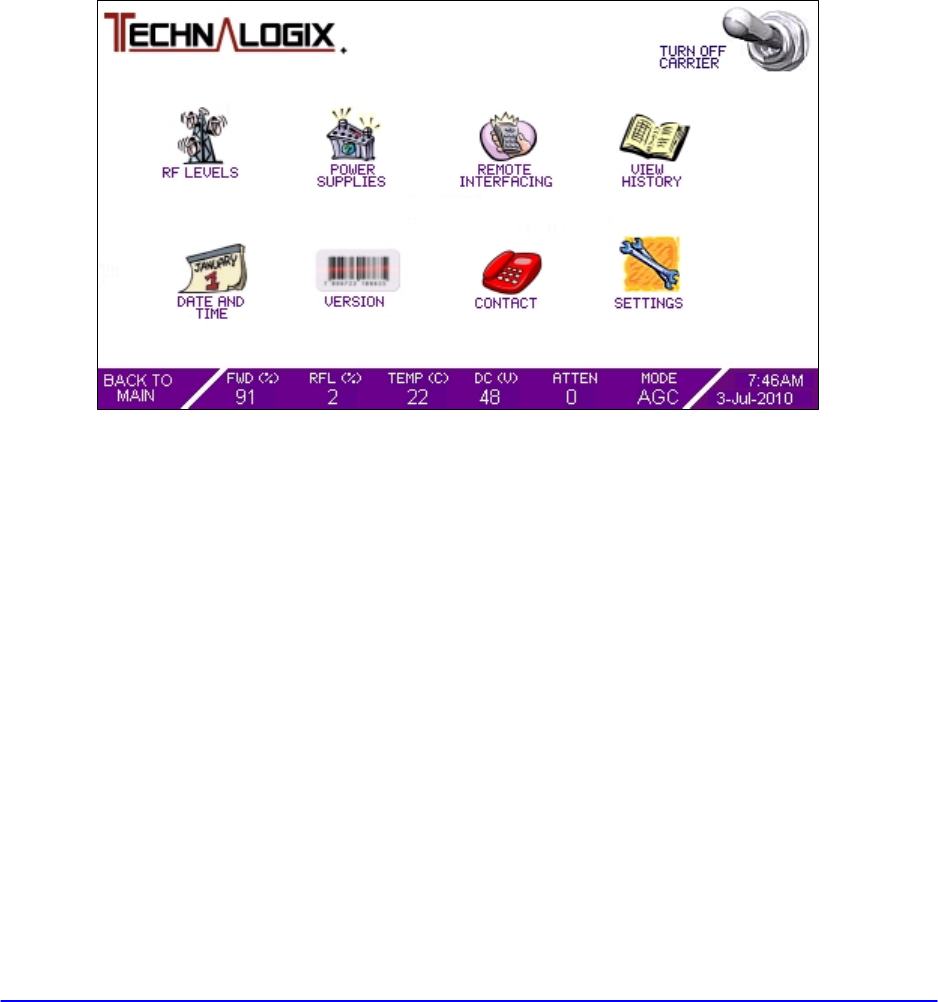
Technalogix Ltd Adrenaline Control System
VI-13
Menu Screen
The menu screen allows the user to dive into further details of the power amplifier’s operations.
Pressing the BACK TO MAIN button will toggle between the Main Screen and the Menu Screen.
The Menu Screen is shown below:
Each of the menu icons on the Menu Screen allow the user to take additional readings or make
settings that are not provided from the Main Screen. Any changes to settings will be stored in
non-volatile memory with the exception of the date and time which are stored as long as the
backup battery remains charged (approximately one week of loss of AC power or power down).
While the user is in the sub menu screens (anything besides the Main Screen), full monitoring
and protection is taking place. This means that is a user makes a change to a setting or
parameter that jeopardizes the power amplifier, the control system will provide protection,
display the fault in red text near the top of the touchscreen, and stay in the current menu.
The individual menu screens will now be covered.
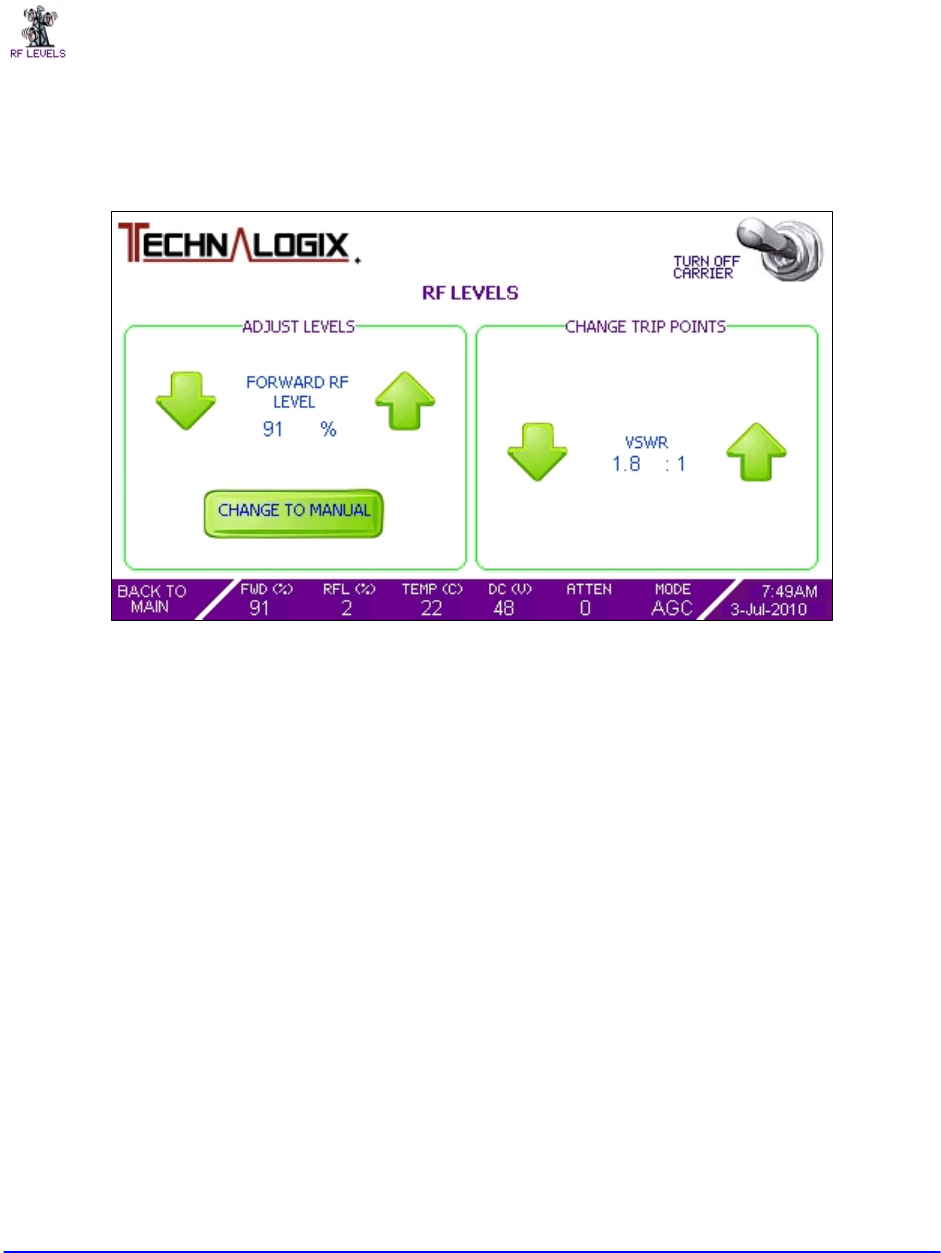
Technalogix Ltd Adrenaline Control System
VI-14
RF Levels Screen
This screen allows the user to change settings to the RF levels, including the Forward RF level
and the reflected (VSWR) trip point. From this screen, the user can also toggle between AGC
and Manual mode. The RF Levels Screen is displayed below:
To adjust Forward RF Level:
Press the up or down arrows until the desired Forward RF level is reached. If the adjusted level
exceeds 110%, the protection will kick in and the system will fold back the RF power to a safe
level. There may be a residual amount of Forward power even at 0% setting, but it should be
insignificant.
To toggle between Manual and AGC Mode:
Simply press the CHANGE TO MANUAL or CHANGE TO AGC button in the Adjust Levels half
of the screen. If a fault occurs while in AGC mode, the system will default back to Manual mode
and protective action will be taken.
NOTE: Pressing the up and down arrows for Forward RF level change while in AGC will
change the power. The same holds true for Ethernet, SNMP, or Remote Port control The AGC
is designed to hold the RF power level steady when the system is unmanned for external events
like temperature, slight changes to the input level, and long term component fatigue.
To change the VSWR Shutdown Trip Point:
Use the up and down arrows to set the VSWR shutdown trip point to between 1.1:1 and 1.8:1. If
a measured VSWR is found above the set trip point, but below 1.8:1, then the system will fold
back the forward power to a safe level. If the measured VSWR exceeds 1.8:1, then the carrier
will be initially turned right off.
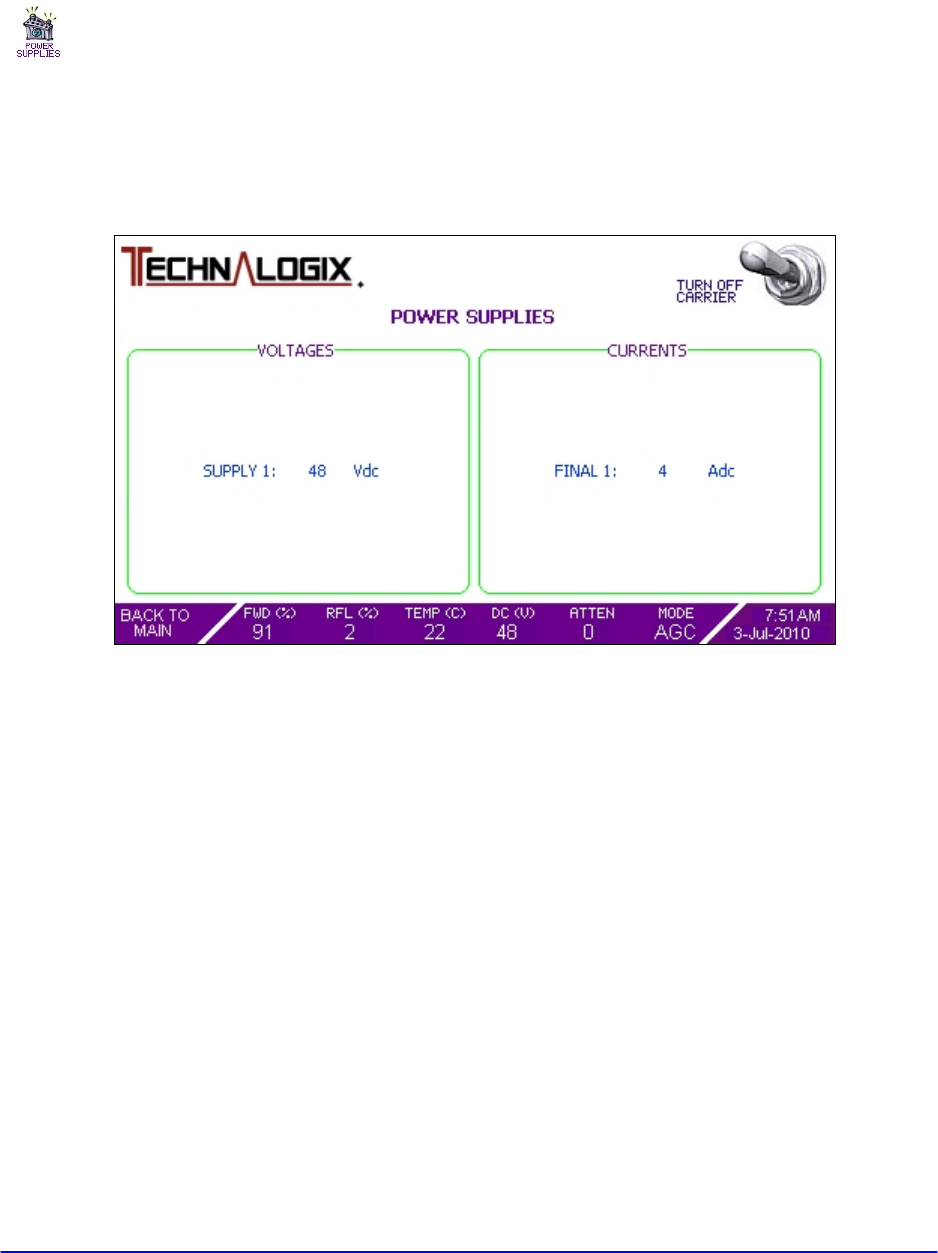
Technalogix Ltd Adrenaline Control System
VI-15
Power Supplies Screen
This screen allows the user to view individual voltage and current readings. The Power Supplies
Screen is displayed below:
DC supply voltages are nominally 30 or 48Vdc depending on the system. Readings of this
voltage in the Power Supplies Screen, and on the summary bar at the bottom of the
touchscreen, should not vary more than +/- 2%.
If multiple amplifier pallets are included in the amplifier chain, then the individual currents will all
be displayed in the Currents section of the screen. In the case of multiple pallets in the chain,
typically the user should see matching of the final pallets to within approximately 10%. Anything
outside this range is usually a sign that there may be an issue. Transistor device or circulator /
isolator load damage could be the culprit, or the tragic spilt-drink-on-transmitter incident. Our
team would be glad to walk you through any troubleshooting issues or questions you may have.
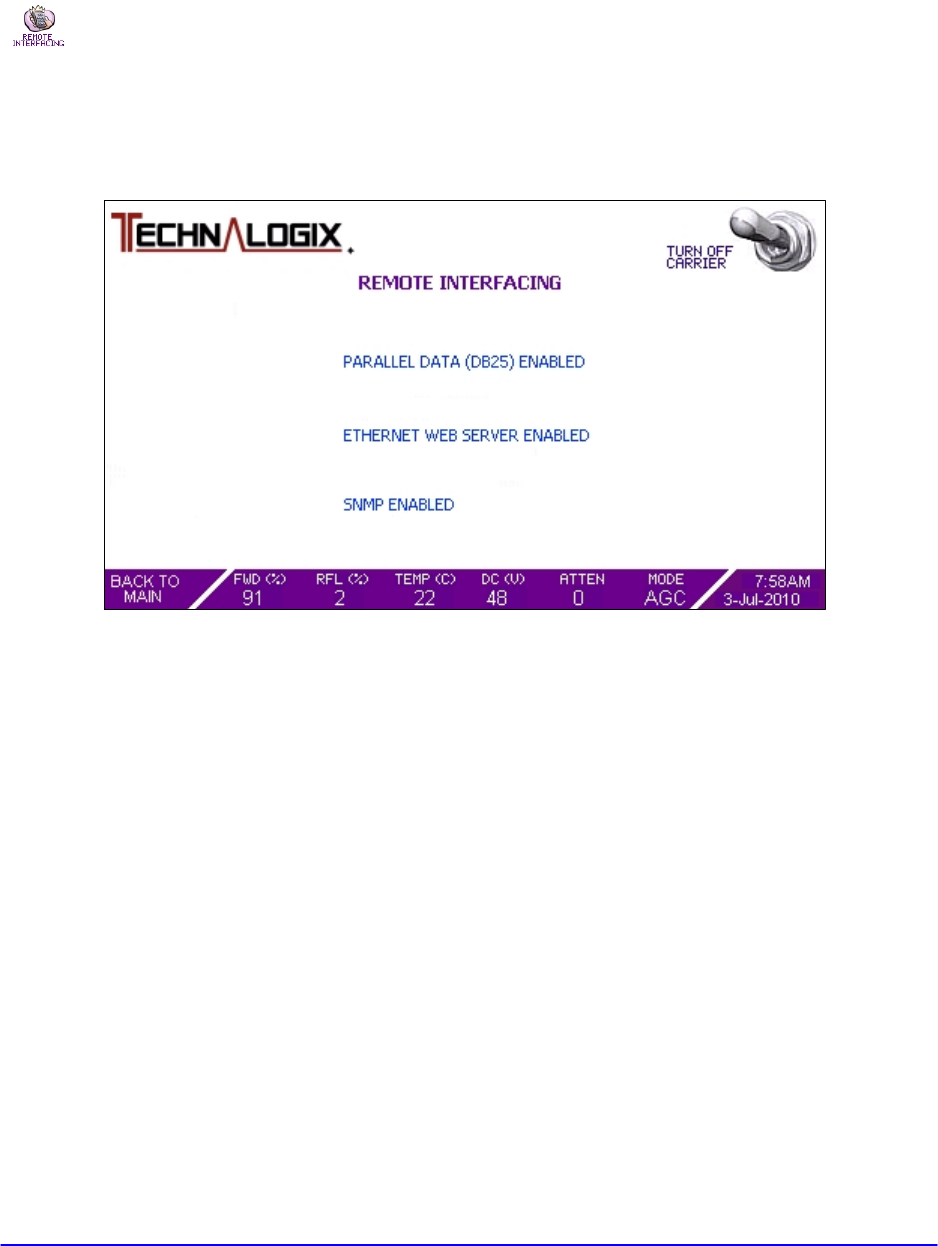
Technalogix Ltd Adrenaline Control System
VI-16
Remote Interfacing Screen
The Remote Interfacing Screen is simply a summary of what features are installed into the
control system, as seen in the following screen shot.
The Remote Port, or parallel data, through the DB25 connector on the back panel of the
enclosure extracts the majority of the internal system information and provides it externally for
processing and control. The Remote Port is the equivalent of a standalone external remote
monitor.
The Ethernet web server provides a means to monitor system information via a web site. This is
accomplished via the Ethernet connector on the back panel of the power amplifier. The unit’s IP
address is listed in the Version Screen.
The SNMP offers a third method of monitoring system parameters and external control. The
user’s Network Management System (NMS) can monitor multiple transmitter sites remotely and
control common functions of the system via the Technalogix Management Information Base
(MIB).
Detailed information on all three remote interfacing subsystems is found later in this section.
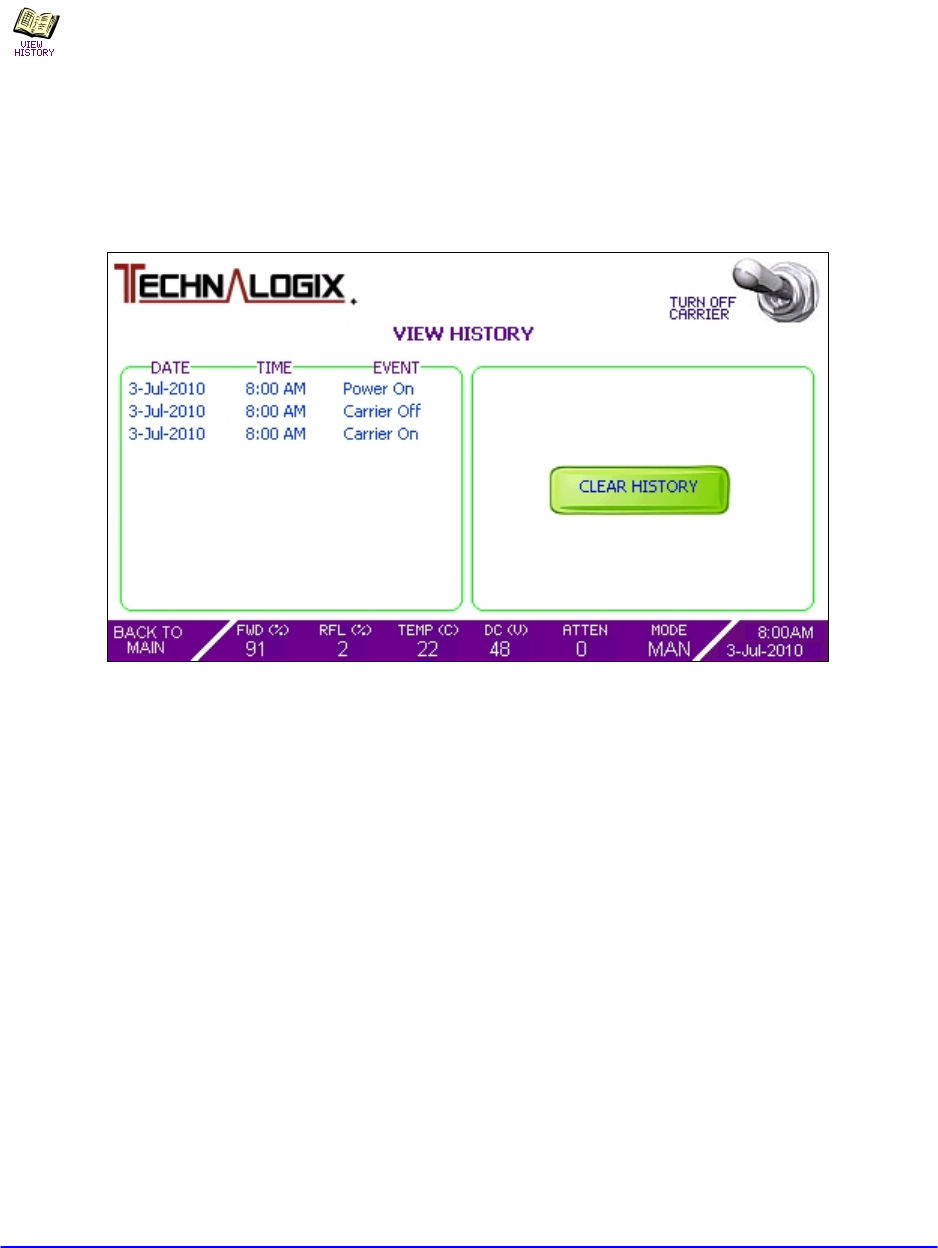
Technalogix Ltd Adrenaline Control System
VI-17
History Screen
The History Screen provides a summary of the most recent events that have occurred in the
power amplifier, including the date and time of occurrence. An event can either be a fault or
simply an action like turning on or off the carrier. The format of the History Screen is illustrated
below:
Ten of the most recent events are displayed on the History Screen. As more events occur, the
earliest recorded event gets displaced on the screen. If the user changes the time and/or date
from the Date and Time Screen, then the events that occurred before the time and/or date
change remain unchanged with their original time stamp.
The user can clear the history screen by pressing the CLEAR HISTORY. Users will find this
screen useful in correlating events in the power amplifier with external events like weather and
changes to the broadcast facility’s environment.
The events are recorded in non-volatile memory so they are safe in the event of a power outage
or pesky lightning-strike-wins-fight-with-power-supply.
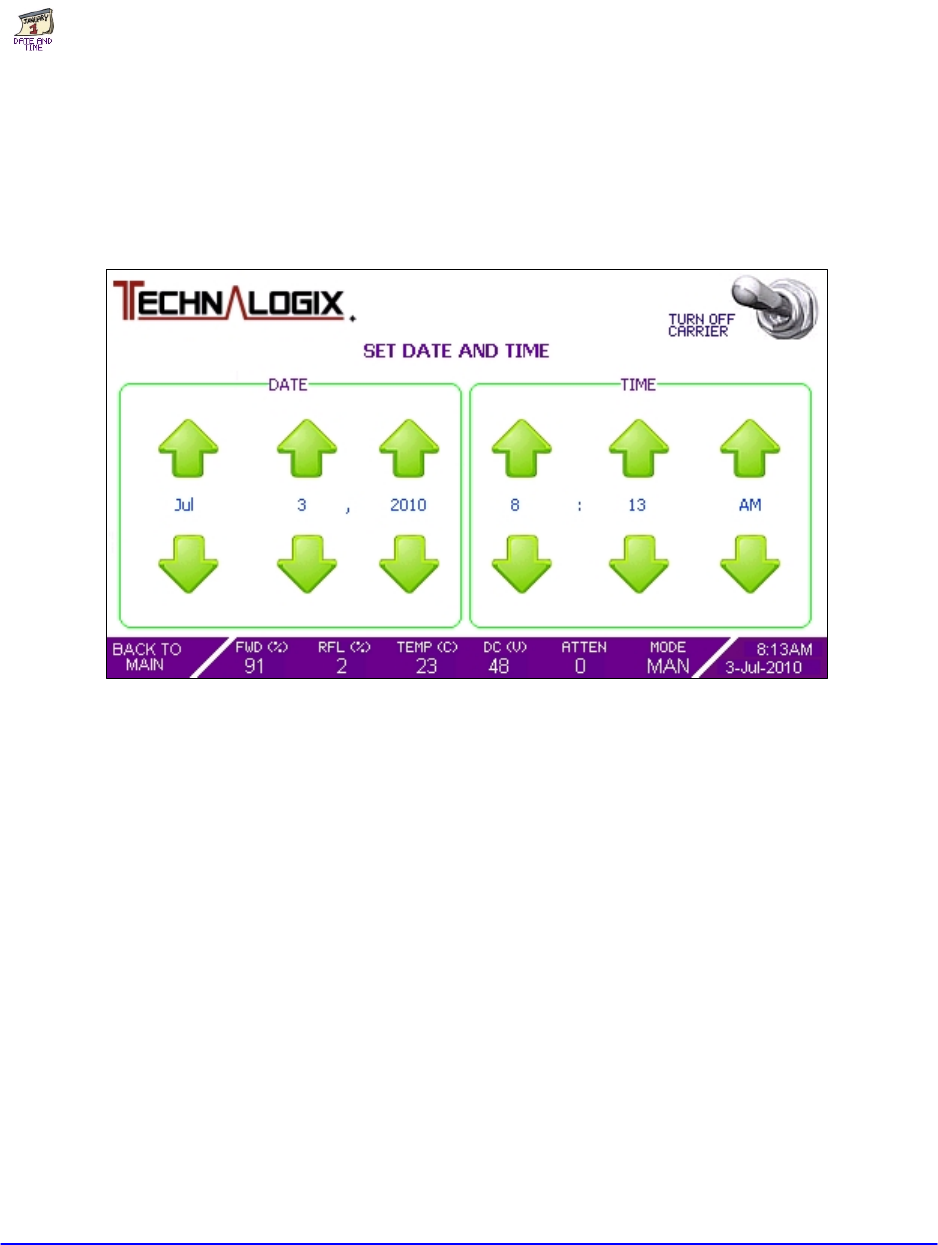
Technalogix Ltd Adrenaline Control System
VI-18
Date and Time Screen
The Date and Time Screen is used to update the date and time of the control system. This is
typically used to create accurate correlations between the event history and events that are
external to the system.
The time is factory set to the factory’s Mountain Standard Time (MST).
Changes to the date or time are made by simply pressing the up or down arrows associated
with each section (month, day, hour, etc). Any changes will immediately be seen in the
summary bar on the bottom right of the touchscreen. When the changes are made, simply press
the BACK TO MAIN button to continue to other screens.
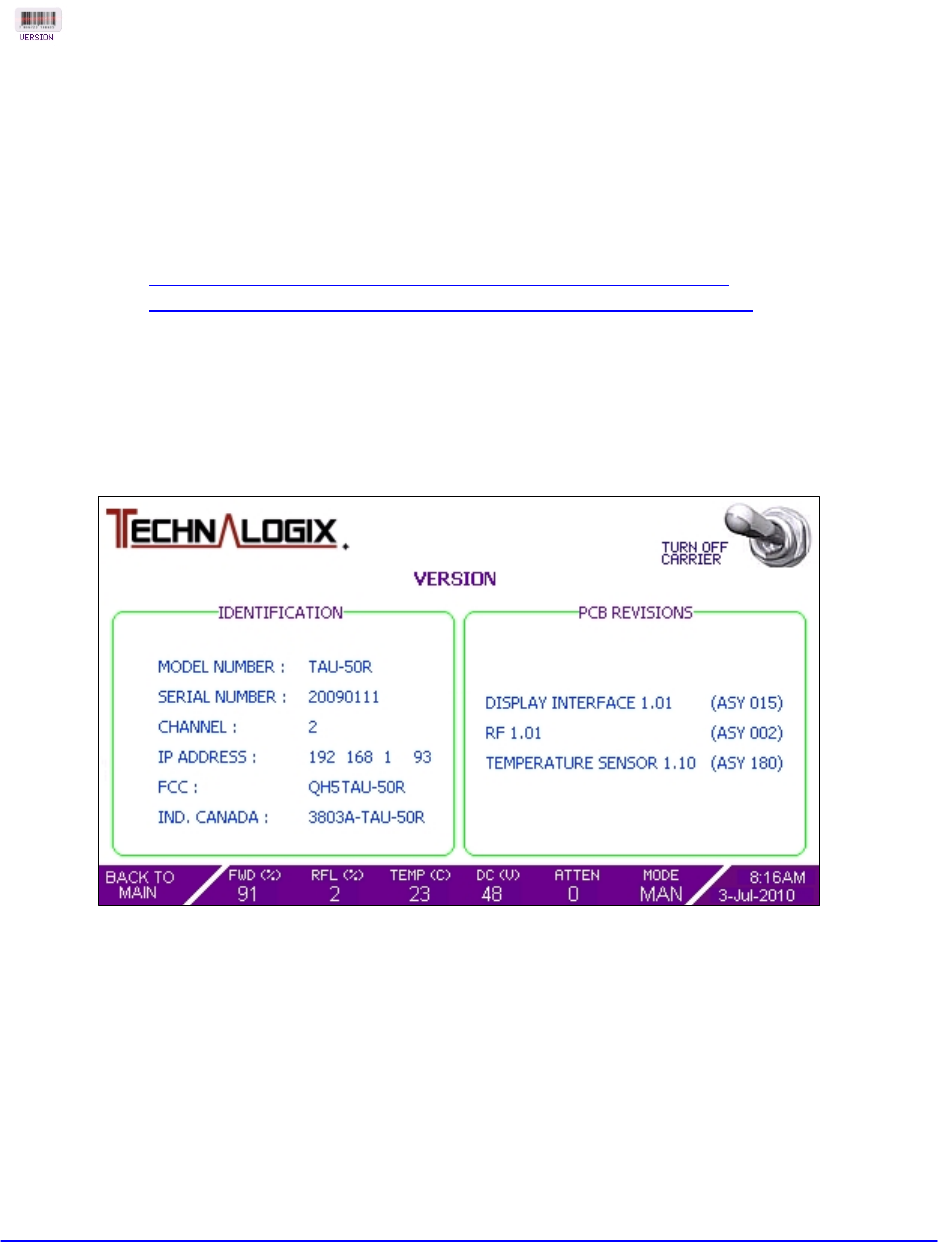
Technalogix Ltd Adrenaline Control System
VI-19
Version Screen
The Version Screen contains no user-settable items, but is intended as an identification screen
to the user. It also helps Technalogix maintain its unmatched service reputation by allowing our
technicians and Service team to know exactly what versions of PCBs are inside a customer’s
unit, even several years down the road. The versions can then be correlated to factory
documentation. In addition, current government certification numbers are included for Industry
Canada and FCC. Please contact Technalogix if you require copies of the actual grants, or visit:
FCC: https://fjallfoss.fcc.gov/oetcf/eas/reports/GenericSearch.cfm (grantee code QH5)
Ind. Canada: http://www.ic.gc.ca/app/sitt/reltel/srch/nwRdSrch.do?lang=eng (company 3803)
Finally, general information is included in the Version Screen for users who may not be familiar
with the equipment and do not want to venture into the dusty abyss behind the rack or cabinet
searching for tiny ID tags. The Version Screen is illustrated below:

Technalogix Ltd Adrenaline Control System
VI-20
Contact Screen
The Contact Screen provides an easy means for the user to get in touch with Technalogix for
anything. Whether they have a technical or installation question or simply want to chat about
how gosh darn cool our equipment is, Technalogix welcomes questions, feedback, and contact.
If you are in the area, please feel free to stop by to tour the facility, test drive some state of the
art products, or get a refresher on some training.
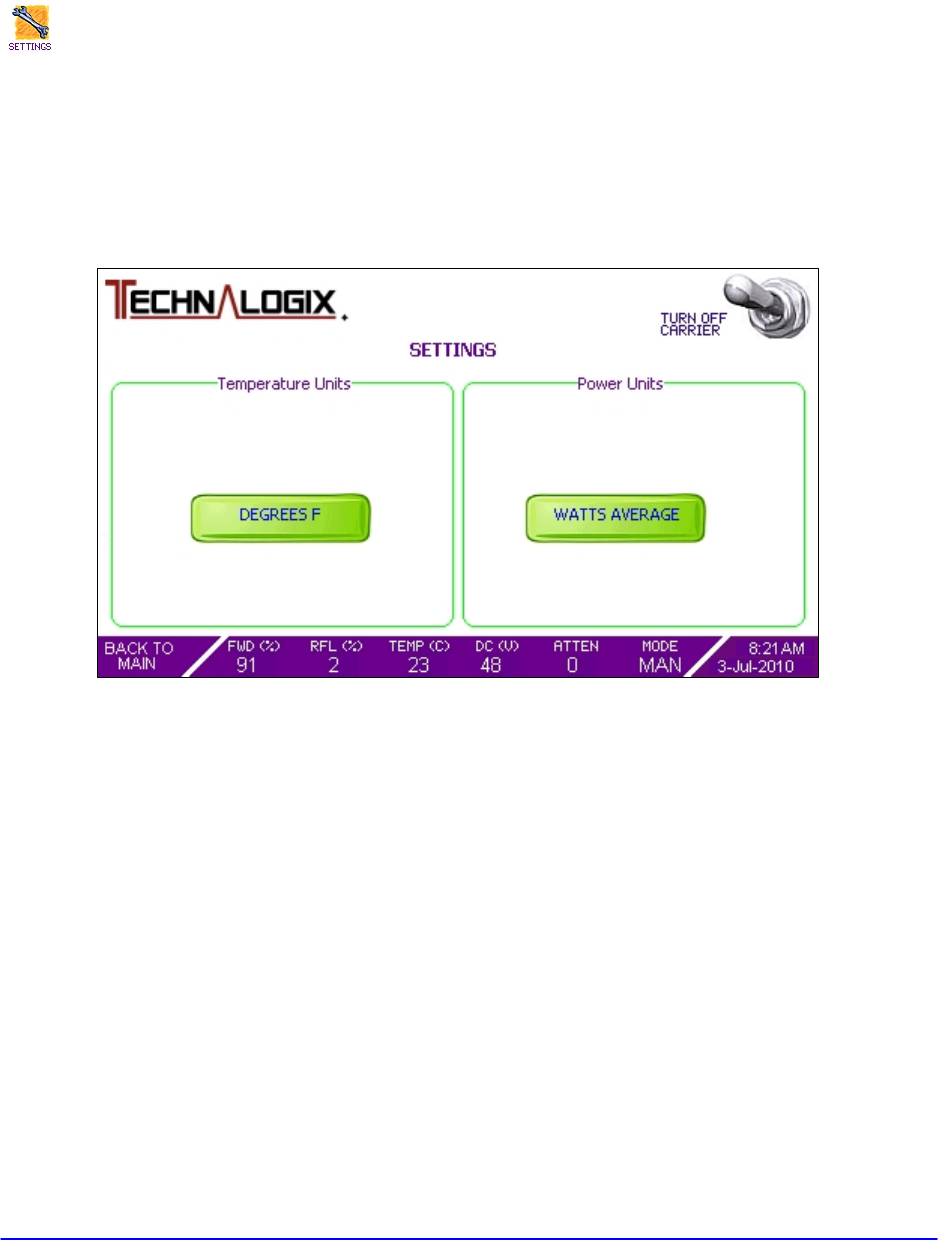
Technalogix Ltd Adrenaline Control System
VI-21
Settings Screen
“You say tomato...”
The Settings Screen allows the user to modify some of their preferences on how information is
displayed on the touchscreen, as seen in the figure below:
Pressing the DEGREES F button will convert all temperature readings to degrees Fahrenheit
from Celsius (and vice versa). Temperature protection trip points are factory set.
Similarly, the user can switch between watts or percentage for their RF power readings. When
in percentage mode, the power amplifier is designed for a maximum operating power of 100%
with overdrive protection at 110%.
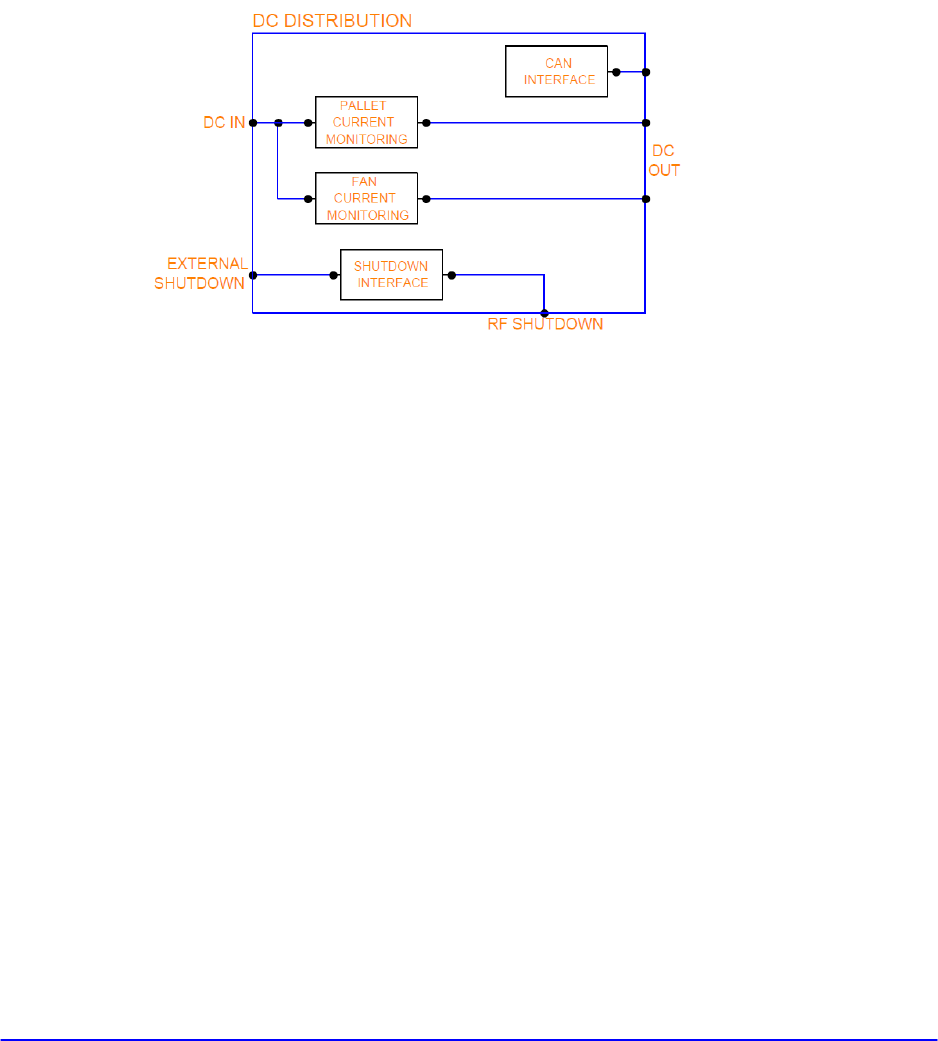
Technalogix Ltd Adrenaline Control System
VI-22
DC Distribution Module
REV 1.01 (ASY 085)
The DC Distribution module takes DC from the system’s power supply, splits it up for drivers,
finals, and fans, and monitors the current draw of the individual loads for protection, as seen in
the following block diagram:
DC is fed into the module via connectors J313 and J314 for the drivers and fans and J315
through J322 for the finals. The DC currents are then monitored for both display and protection
purposes. U308, U310, U312, U314, U316, U318, and U322 convert voltage drops across
current shunts for display purposes (sent to Display Interface), while U307, U309, U311, U313,
U315, and U317 handle high speed protection duties. The shutdown interface circuit takes
internal current faults and external inputs and processes them through an OR/NOR gate before
the shutdown signal heads off board. The DC current measurements that are to be used for
display purposes are also filtered via op amps U301 through U306, and U323. DC voltage is
monitored through U324.
Microcontroller U325 handles the interface between the Display Interface and the DC
Distribution and also converts the DC currents into a format suitable for sending through CAN to
the Display Interface. U321 handles the actual CAN bus data transfer.
The same DC that feeds the drivers and fans also powers the on board regulator (U326) that
generates the +5V. The green LED D302 provides visual indication that the 5V is present and
fuse F301 is good. Two yellow LEDs, D303 and D304, provide visual indication that the DC
supply inputs are present for both the drivers/fans and finals, respectively. A flashing D301
(orange LED) indicates that the software is running.
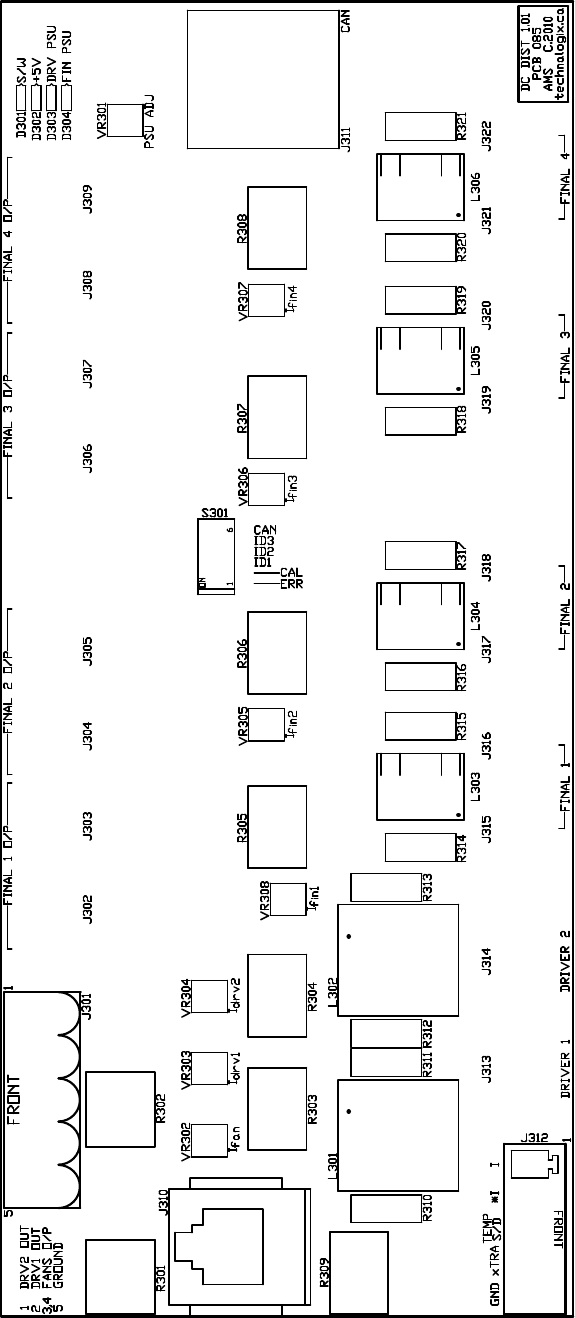
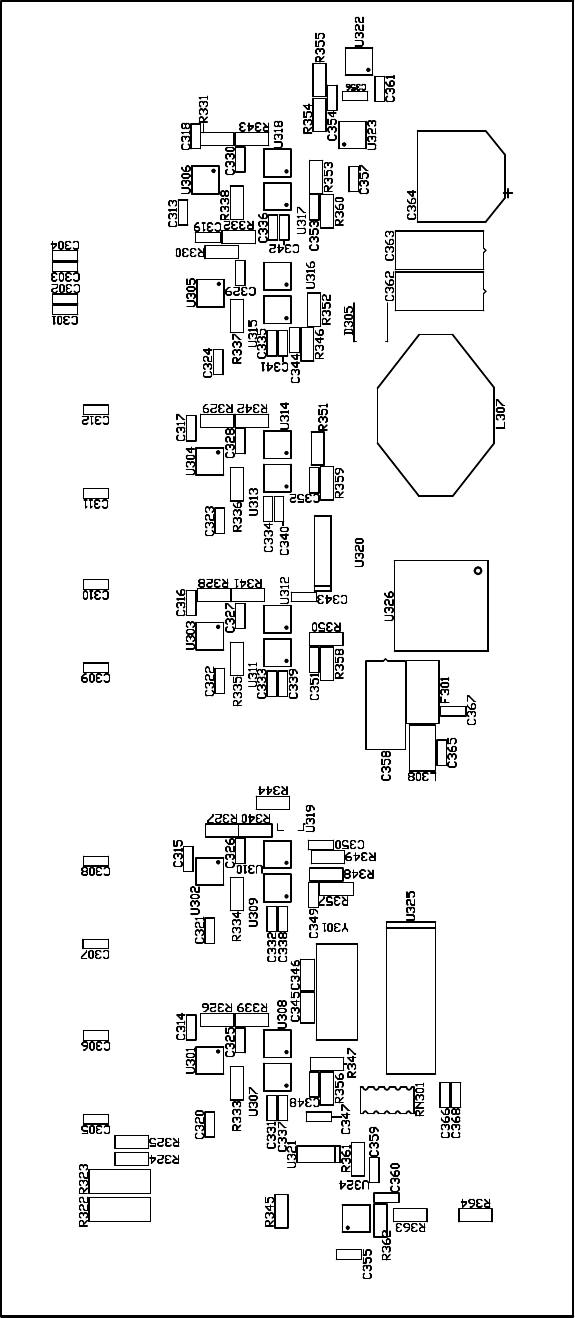
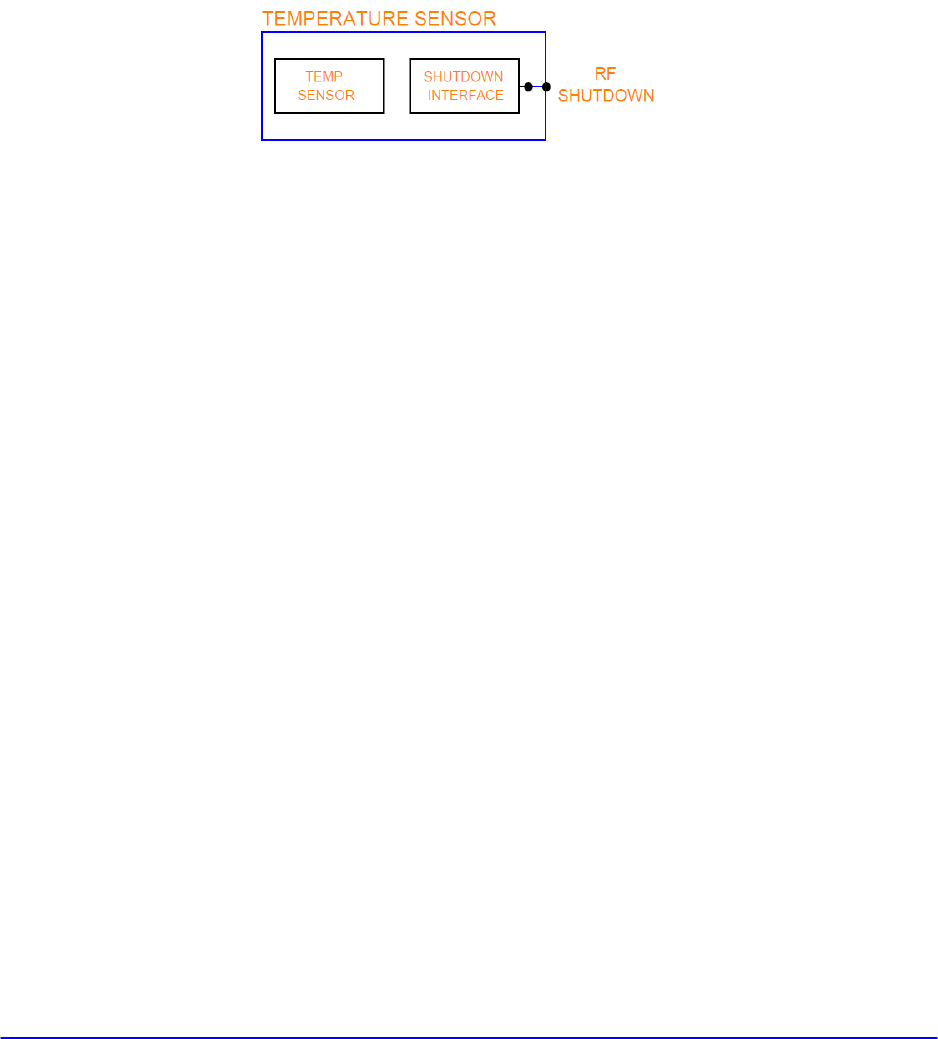
Technalogix Ltd Adrenaline Control System
VI-28
Temperature Sensor Module
REV 1.11 (ASY 181)
The Temperature Sensor module is a small board mounted to the main heatsink of the amplifier.
The main purpose of the temperature sensor module is to take temperature readings of the
heatsink. The following is a block diagram of the Temperature Sensor module:
The temperature sensor IC is U701 which, after it has taken a reading, relays the digital
information to the RF PCB module through J702. Also passing through J702 is a driver disable
signal coming from the RF PCB module. The Temperature Sensor module simply takes this
signal and passes it through to a pad, where a wire connects it to the driver or first gain stage
pallet.
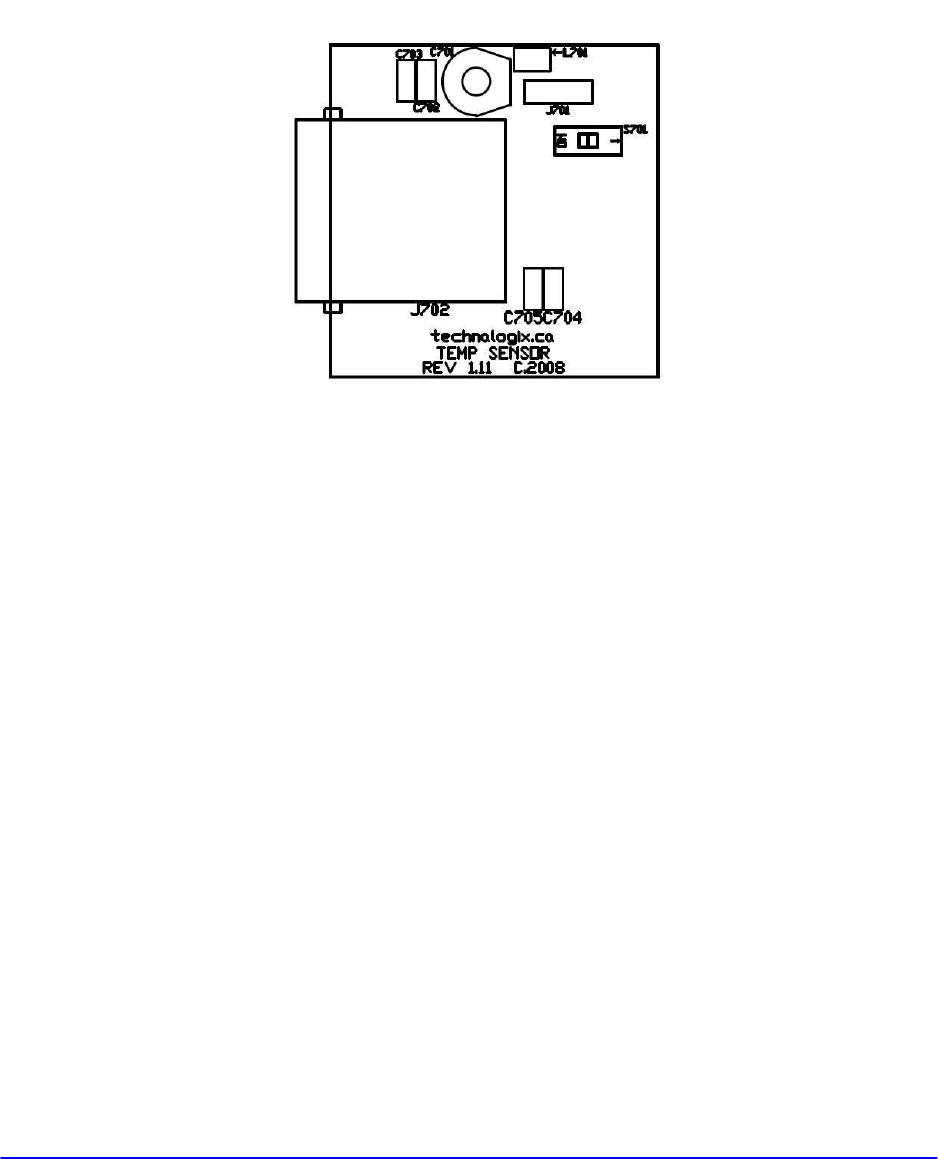
Technalogix Ltd Adrenaline Control System
VI-31
Temp sensor 1.11 component layout Top

Technalogix Ltd Adrenaline Control System
VI-32
Temp sensor 1.11 component layout bottom
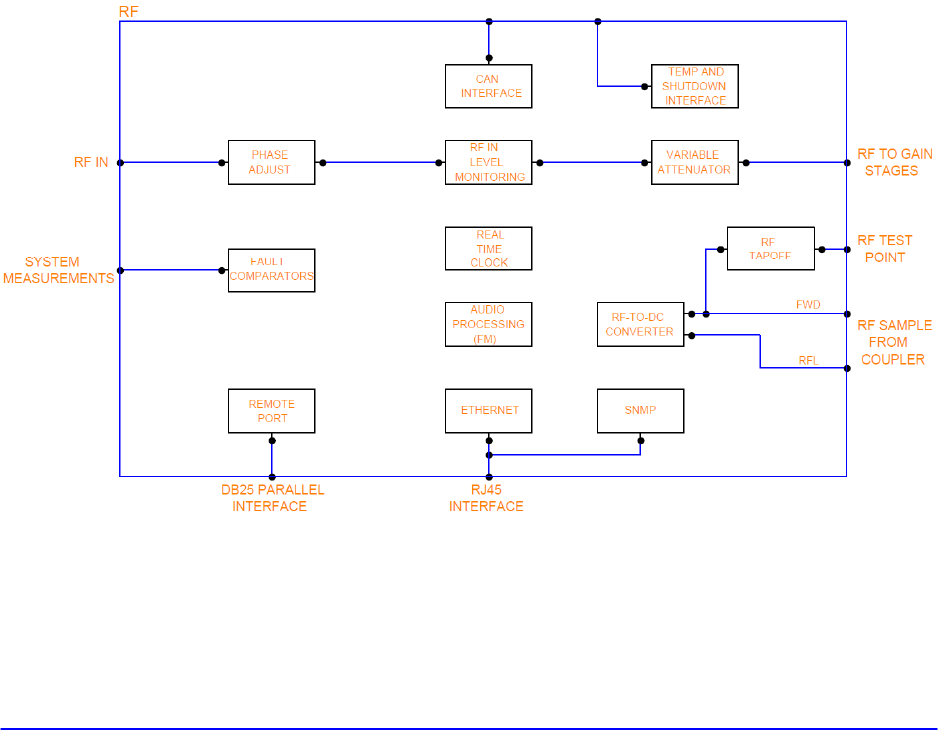
Technalogix Ltd Adrenaline Control System
VI-33
RF Module
REV 1.01 (ASY 002)
The RF PCB module is located on the back panel of the power amplifier enclosure(s) and has
several primary functions:
• act as a variable attenuator so the control system can add attenuation to the RF input of
the power amplifier in order to limit the output power of the transmitter/translator,
• monitor the output of the directional coupler which provides a voltage proportional to the
forward and reflected power at the output of the transmitter/translator,
• communicate with the Temperature Sensor module to read heatsink temperatures and
provide a link to the driver shutdown through the temperature sensor PCB, and
• provide external remote operation to the user through parallel data, Ethernet, and SNMP
interfaces.
These functions can be seen by the block diagram:

Technalogix Ltd Adrenaline Control System
VI-34
The RF input signal comes in to the RF module through J214 (BNC female) or J217 (N female)
before it passes through a phase adjust circuit (installed only in multiple power amplifier
systems) made up of U227/U231 and associated circuitry. The signal then passes through the
voltage-controlled variable attenuator, U236. This attenuator is controlled via DAC (U209) and
buffer (U226) via the microcontroller. Finally, the low level RF signal exits through J207 (BNC
female).
The RF coupled signals produced by the coupler for forward and reflected power are passed
onto the RF module by connectors J203 and J220, respectively. Each signal is then converted
to a DC voltage proportional to the RF levels by detector ICs U229 and U241. The DC voltages
are buffered and filtered via CLC networks before being sent to the microcontroller (U219) and
comparator (U218) for monitoring.
Aside from taking readings from the coupler, the microcontroller on the RF module also
interfaces with the Temperature Sensor (through J211). The high speed shutdown signal for the
pallets is also passed through the Temperature Sensor PCB from the RF module. The lower
speed shutdown for the pallets or control is passed through pin 6 on J201. The microcontroller
interfaces with the system CAN bus using U234 transceiver. Through the CAN bus, the RF
board is able to communicate with the Display Interface module, and any other amplifier
enclosures that are in the system.
The last task of the RF board is to send and receive remote access signals to and from the
transmitter/translator. Two analog outputs, proportional to forward and reflected power and
produced by the digital potentiometer U222 after it receives input from the microcontroller. The
analog outputs are then buffered by U208 before being sent to the DB25 parallel output
connector, J215. J215 also carries the digital fault flags and input/output controls. The digital
signals are then connected to the microcontroller through the opto-isolators U211, U213, U214,
U215, and U237. The Remote Port allows external control of the transmission system via the
DB25. The Power Amplifier enclosure does not include all the pins in the Remote Port like the
Combiner/Filter enclosure.
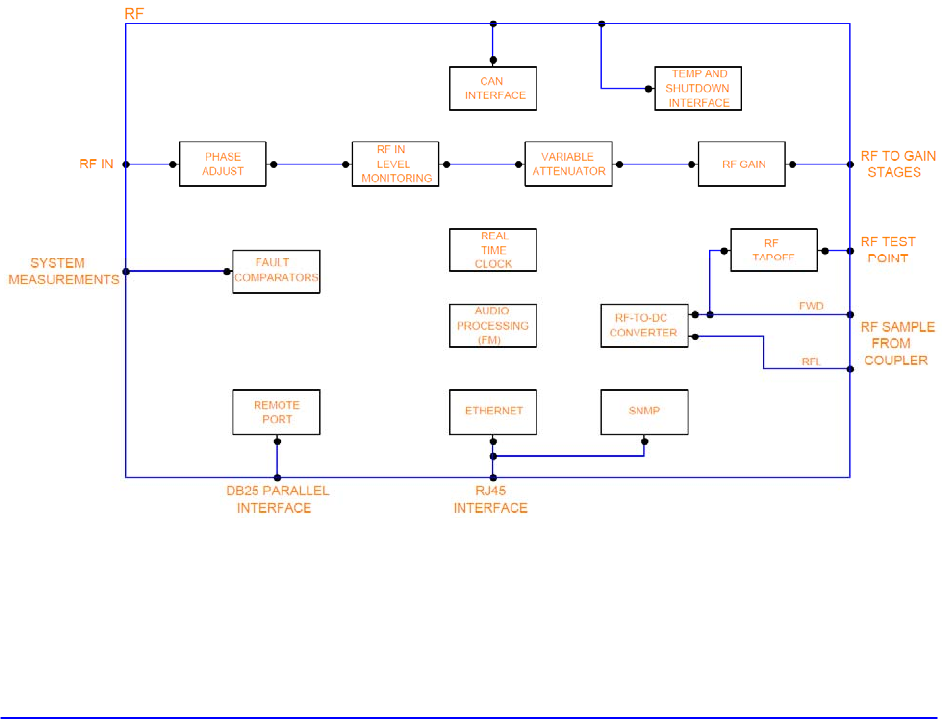
Technalogix Ltd Adrenaline Control System
VI-35
RF Module
REV 1.02 (ASY 003)
The RF PCB module is located on the back panel of the power amplifier enclosure(s) and has
several primary functions:
• act as a variable attenuator so the control system can add attenuation to the RF input of
the power amplifier in order to limit the output power of the transmitter/translator,
• provide additional gain, if required, before passing the RF signal onto the amplifier chain,
• monitor the output of the directional coupler which provides a voltage proportional to the
forward and reflected power at the output of the transmitter/translator,
• communicate with the Temperature Sensor module to read heatsink temperatures and
provide a link to the driver shutdown through the temperature sensor PCB, and
• provide external remote operation to the user through parallel data, Ethernet, and SNMP
interfaces.
These functions can be seen by the block diagram:

Technalogix Ltd Adrenaline Control System
VI-36
The RF input signal comes in to the RF module through J218 (BNC female) or J217 (N female)
before it passes through a phase adjust circuit (installed only in multiple power amplifier
systems) made up of U231/U234 and associated circuitry. The signal then passes through the
voltage-controlled variable attenuator, U241. This attenuator is controlled via DAC (U210) and
buffer (U229) via the microcontroller. Finally, the low level RF signal is passed through a gain
stage (U246) before exiting through J214 (SMA female).
The RF coupled signals produced by the coupler for forward and reflected power are passed
onto the RF module by connectors J203 and J207, respectively. Each signal is then converted
to a DC voltage proportional to the RF levels by detector ICs U232 and U245. The DC voltages
are buffered and filtered via CLC networks before being sent to the microcontroller (U222) and
comparator (U219) for monitoring.
Aside from taking readings from the coupler, the microcontroller on the RF module also
interfaces with the Temperature Sensor (through J211). The high speed shutdown signal for the
pallets is also passed through the Temperature Sensor PCB from the RF module. The lower
speed shutdown for the pallets or control is passed through pin 6 on J201. The microcontroller
interfaces with the system CAN bus using U238 transceiver. Through the CAN bus, the RF
board is able to communicate with the Display Interface module, and any other amplifier
enclosures that are in the system.
The last task of the RF board is to send and receive remote access signals to and from the
transmitter/translator. Two analog outputs, proportional to forward and reflected power and
produced by the digital potentiometer U226 after it receives input from the microcontroller. The
analog outputs are then buffered by U209 before being sent to the DB25 parallel output
connector, J216. J216 also carries the digital fault flags and input/output controls. The digital
signals are then connected to the microcontroller through the opto-isolators U212, U214, U216,
U217, and U240. The Remote Port allows external control of the transmission system via the
DB25. The Power Amplifier enclosure does not include all the pins in the Remote Port like the
Combiner/Filter enclosure.
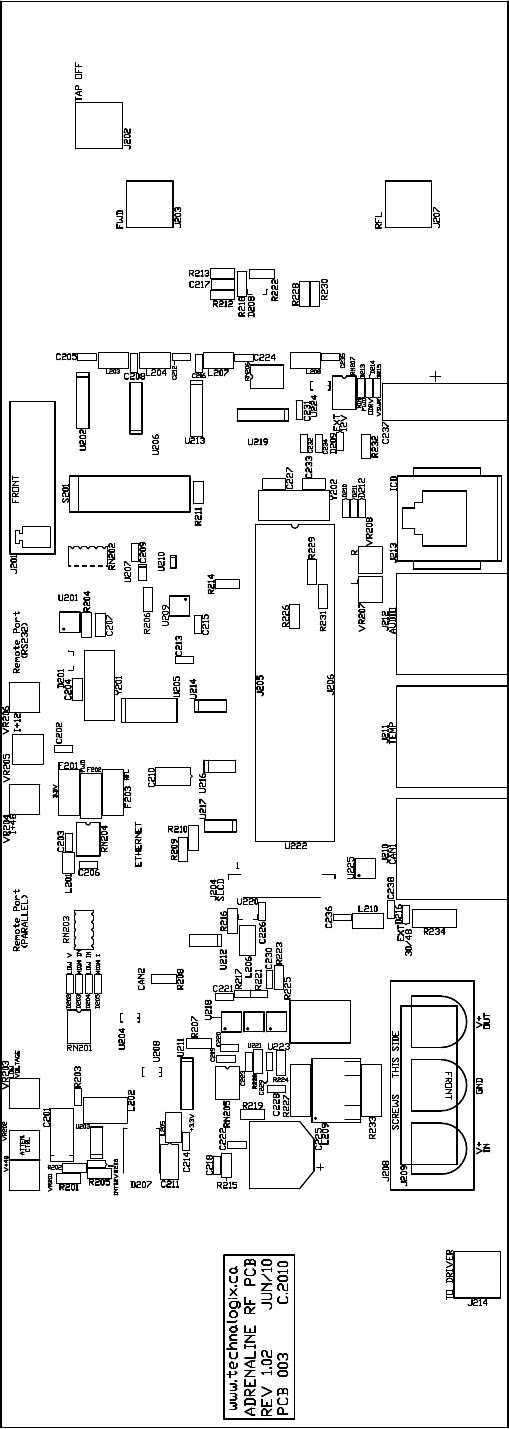
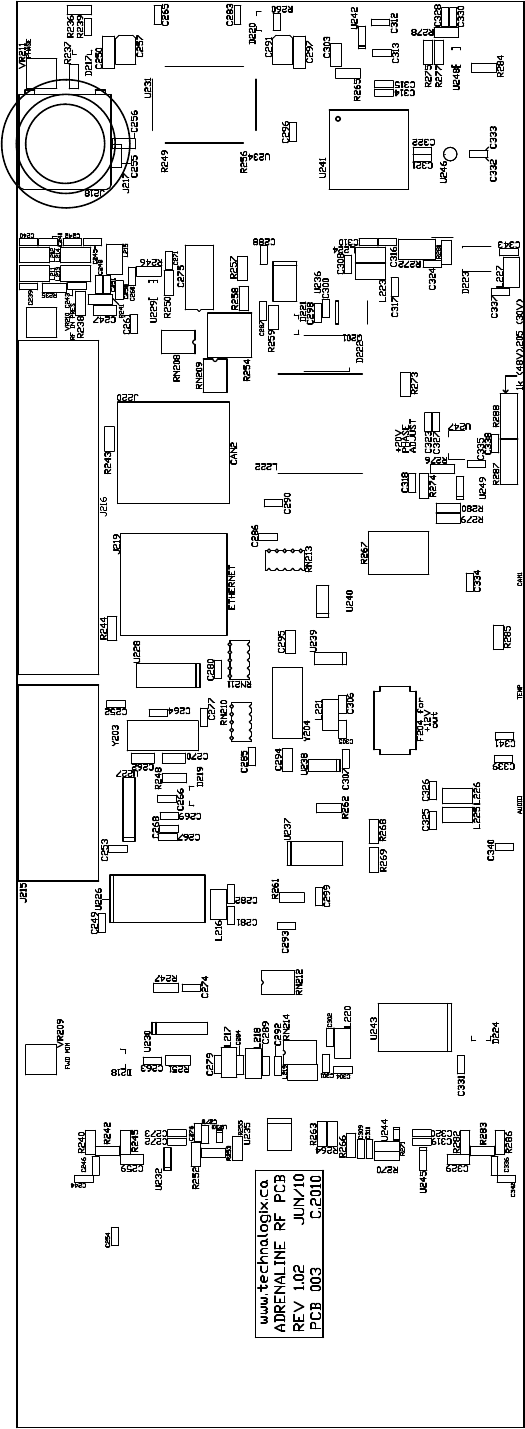
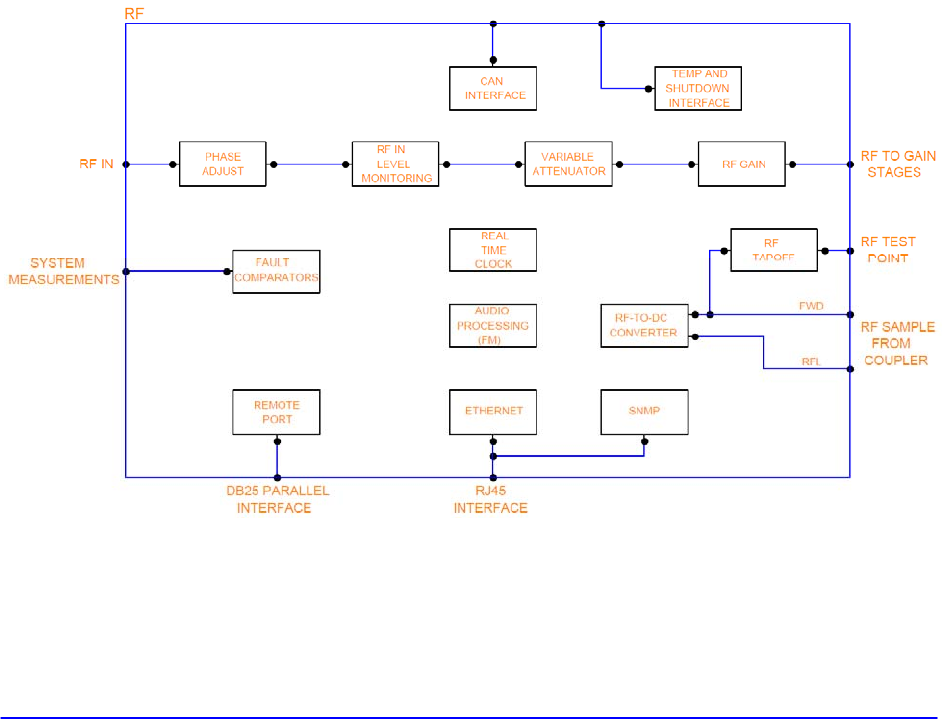
Technalogix Ltd Adrenaline Control System
VI-48
RF Module
REV 1.03 (ASY 004)
The RF PCB module is located on the back panel of the power amplifier enclosure(s) and has
several primary functions:
• act as a variable attenuator so the control system can add attenuation to the RF input of
the power amplifier in order to limit the output power of the transmitter/translator,
• provide additional gain, if required, before passing the RF signal onto the amplifier chain,
• monitor the output of the directional coupler which provides a voltage proportional to the
forward and reflected power at the output of the transmitter/translator,
• communicate with the Temperature Sensor module to read heatsink temperatures and
provide a link to the driver shutdown through the temperature sensor PCB, and
• provide external remote operation to the user through parallel data, Ethernet, and SNMP
interfaces.
These functions can be seen by the block diagram:

Technalogix Ltd Adrenaline Control System
VI-49
The RF input signal comes in to the RF module through J216 (BNC female) or J202 (SMA
female) before it passes through a phase adjust circuit (installed only in multiple power amplifier
systems) made up of U228/U231 and associated circuitry. The signal then passes through the
voltage-controlled variable attenuator, U238. This attenuator is controlled via DAC (U209) and
buffer (U226) via the microcontroller. Finally, the low level RF signal is passed through a gain
stage (U243) before exiting through J213 (SMA female).
The RF coupled signals produced by the coupler for forward and reflected power are passed
onto the RF module by connectors J204 and J207, respectively. Each signal is then converted
to a DC voltage proportional to the RF levels by detector ICs U229 and U242. The DC voltages
are buffered and filtered via CLC networks before being sent to the microcontroller (U220) and
comparator (U217) for monitoring.
Aside from taking readings from the coupler, the microcontroller on the RF module also
interfaces with the Temperature Sensor (through J211). The high speed shutdown signal for the
pallets is also passed through the Temperature Sensor PCB from the RF module. The lower
speed shutdown for the pallets or control is passed through pin 6 on J201. The microcontroller
interfaces with the system CAN bus using U235 transceiver. Through the CAN bus, the RF
board is able to communicate with the Display Interface module, and any other amplifier
enclosures that are in the system.
The last task of the RF board is to send and receive remote access signals to and from the
transmitter/translator. Two analog outputs, proportional to forward and reflected power and
produced by the digital potentiometer U223 after it receives input from the microcontroller. The
analog outputs are then buffered by U208 before being sent to the DB25 parallel output
connector, J215. J215 also carries the digital fault flags and input/output controls. The digital
signals are then connected to the microcontroller through the opto-isolators U211, U213, U214,
U215, and U237. The Remote Port allows external control of the transmission system via the
DB25. The Power Amplifier enclosure does not include all the pins in the Remote Port like the
Combiner/Filter enclosure.
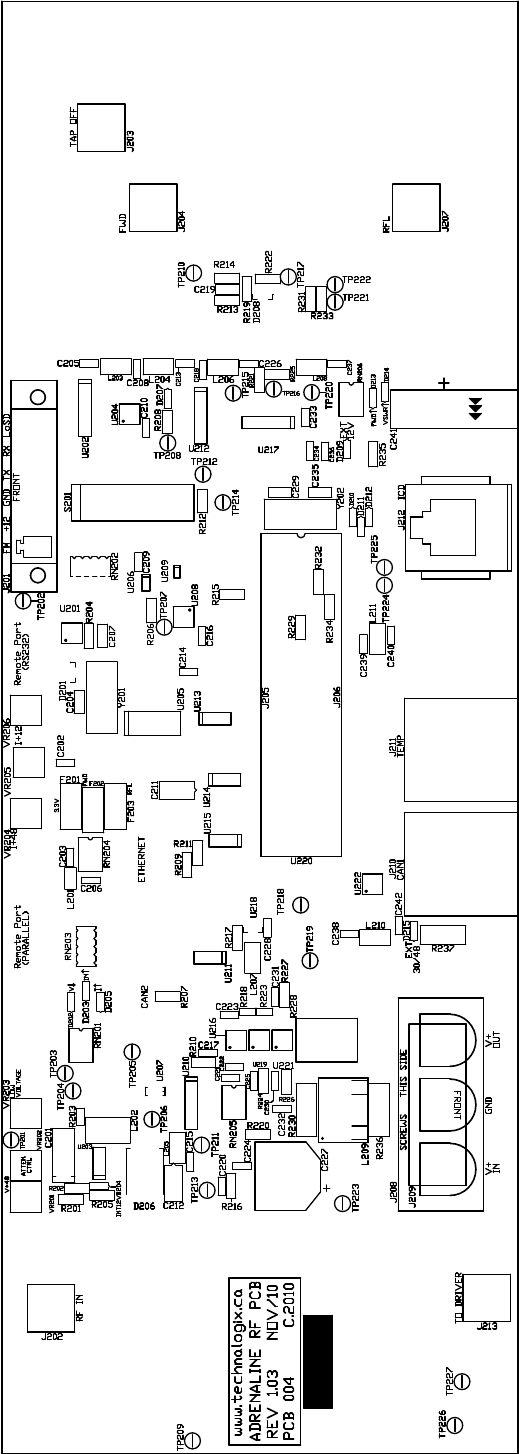
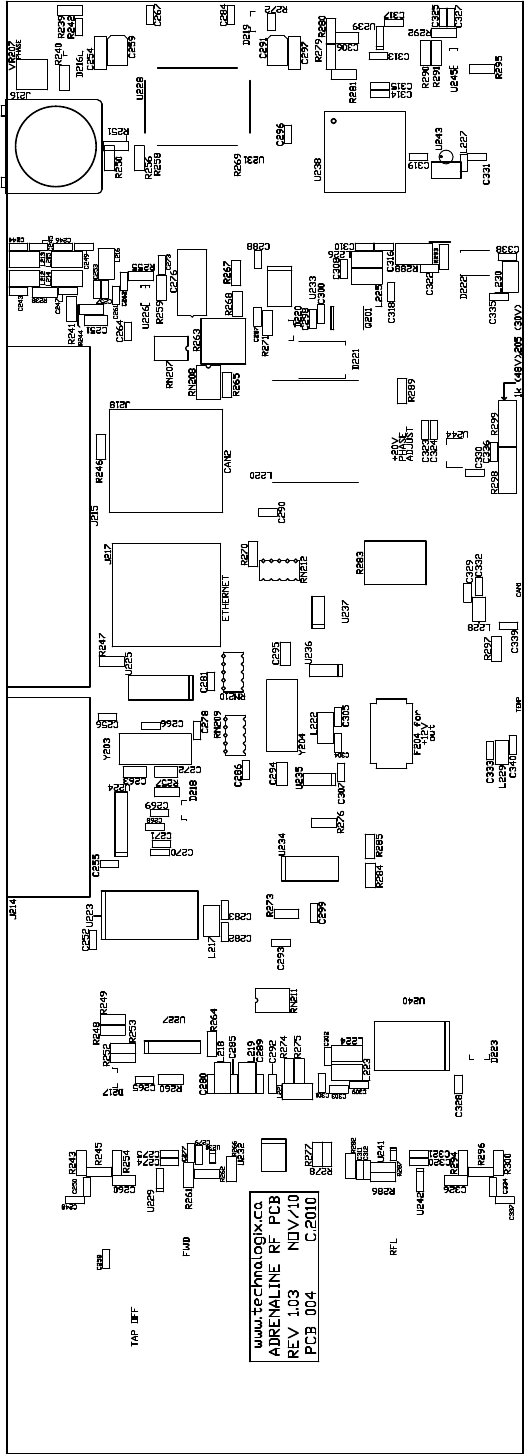

Technalogix Ltd Adrenaline Control System
VI-61
Web Interface
To access the Technalogix Adrenaline Web Interface, connect an Ethernet cable to the RJ45
port on the power amplifier (back panel) to your network. The Adrenaline control system in the
power amplifier should allocate an internal IP from your router or you can set this manually (see
below).
A computer can be plugged directly into the Ethernet port to directly access the on-board web
interface. Most new computers can do this with a standard Ethernet cable but some may
require a crossover Ethernet cable.
The default internal address is http://adrenaline/ or http://adrenaline/index.htm
After entering address into a web browser you will be asked for a password. Initially use:
username: admin
password: admin
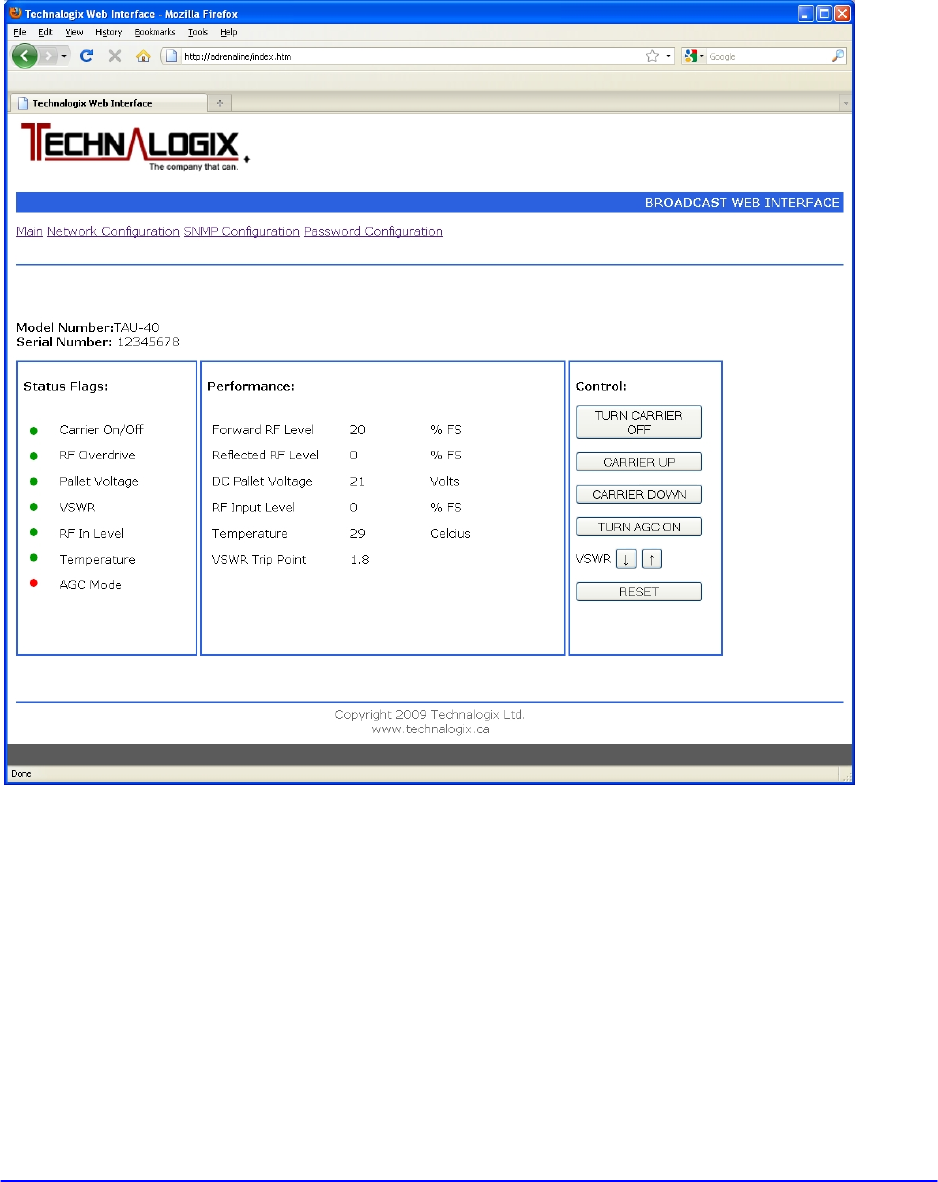
Technalogix Ltd Adrenaline Control System
VI-62
At this will display the main page shown here:
Model number and serial number of the unit are displayed in the top left of the screen.
The Status Flags section provides the user with feedback from the system. Specifically, there
are status flags for:
• Carrier is on or off
• Forward RF in Overdrive (>110% FS)
• Pallet Voltage Supply Good
• High VSWR
• High Temperature
• AGC on or off (AGC or Manual mode)

Technalogix Ltd Adrenaline Control System
VI-63
The Performance section provides the user with specific parameters and measurements in the
system. Measurements that can be viewed from the Performance box are:
• Forward RF Levels as a % of Full Scale (FS)
• Reflected RF Levels as a % of FS
• DC Supply Voltage in volts
• RF Input Levels before attenuator as a % of Full Scale
• Temperature in °C
• VSWR Trip Point Limit (between 1.1 and 1.8)
The Control section of the web interface screen allows the user to control functions inside the
equipment, including:
• Turn Carrier On/Off - Turn the Carrier on/off
• Carrier Up - Increase the Carrier by removing attenuation
• Carrier Down - Decrease the Carrier by adding attenuation
• Turn AGC On/Off - Turns on the AGC (automatic gain control). The
system will then try to maintain the current forward level.
• VSWR ↑↓ - Increase or Decrease the VSWR Trip point by 0.1 between
1.1:1 and 1.8:1.
• Reset - Forces the system to reboot
Note that if AGC is enabled and you press Carrier Up/Down the system will reset the AGC to
manual, make the change in power, and then revert back into AGC mode with the new level.
AGC level is maintained if the power amplifier restarts.
Also on the main web Ethernet page, along the top, are links to the other pages:
Main – Returns to Main Index page
Network Configuration
SNMP Configuration
Password Configuration
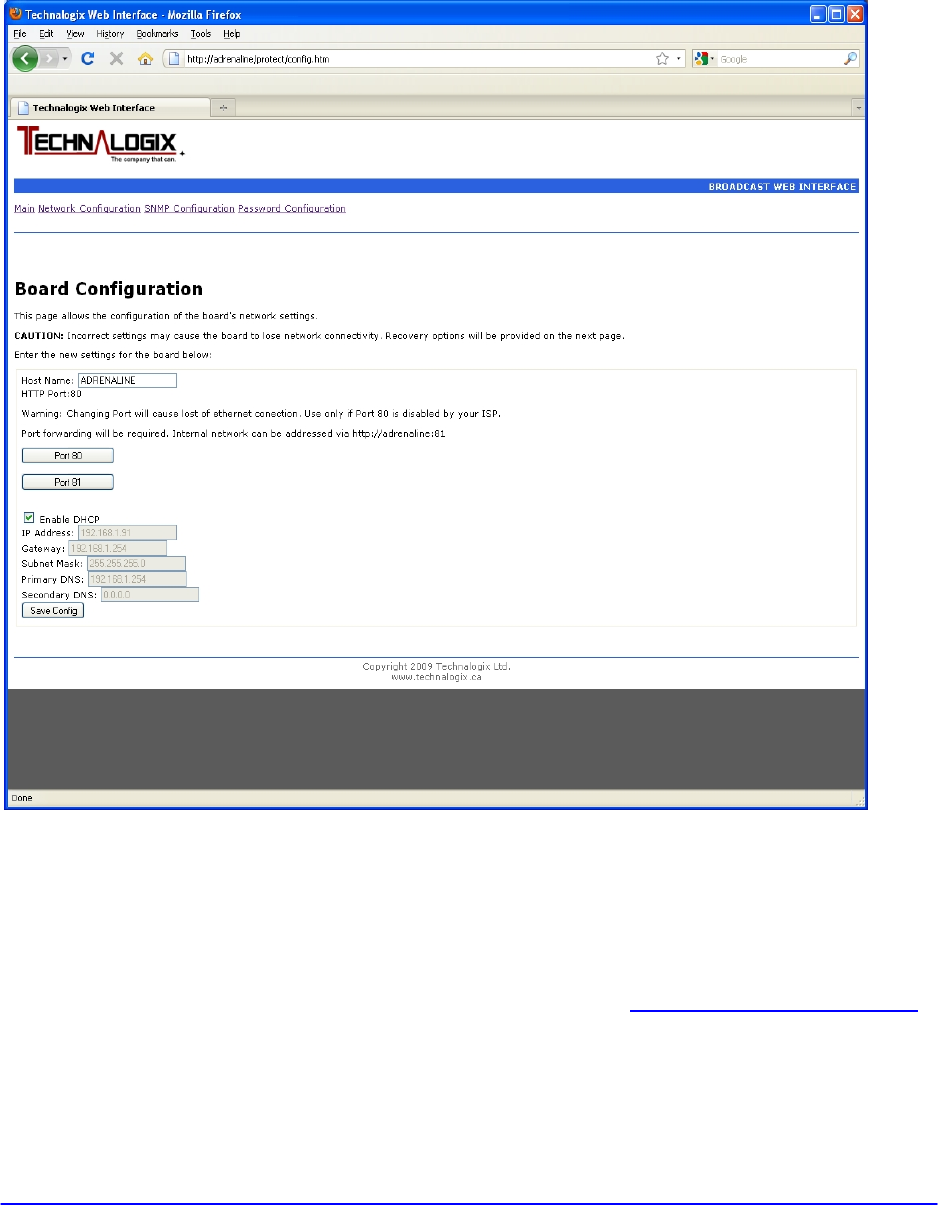
Technalogix Ltd Adrenaline Control System
VI-64
Network Configuration
On this page you can set the network settings.
Host name shows the current webpage name (default is ADRENALINE). Enter a new name
here if you wish to change this.
For example entering YourCompany will make the web address http://yourcompany/index.htm
HTTP Port shows the current port used for internet access, 80 or 81. Port 80 is the default and
is the accepted standard. Port 81 is available because some internet providers block access to
port 80 unless you pay more. Be very careful changing this.

Technalogix Ltd Adrenaline Control System
VI-65
You can force a web browser to use port 81 by address to http://adrenaline:81/index.htm. To
use this with an internet address will require port forwarding. Consult your routers manual to set
this up.
With DHCP enabled the system with automatically try to find a router and acquire an IP
address. If you want to set this manually, uncheck the Enable DHCP box and enter it below then
click Save Config.
To view the webpage from the internet rather than an internal network you need an external IP
address, generally provided by your internet provider. Note that you can only have one web
server using the same port. With this, anyone can access the system over the internet with
something like:
http://www.yourcompanywebaddress.com/adrenaline
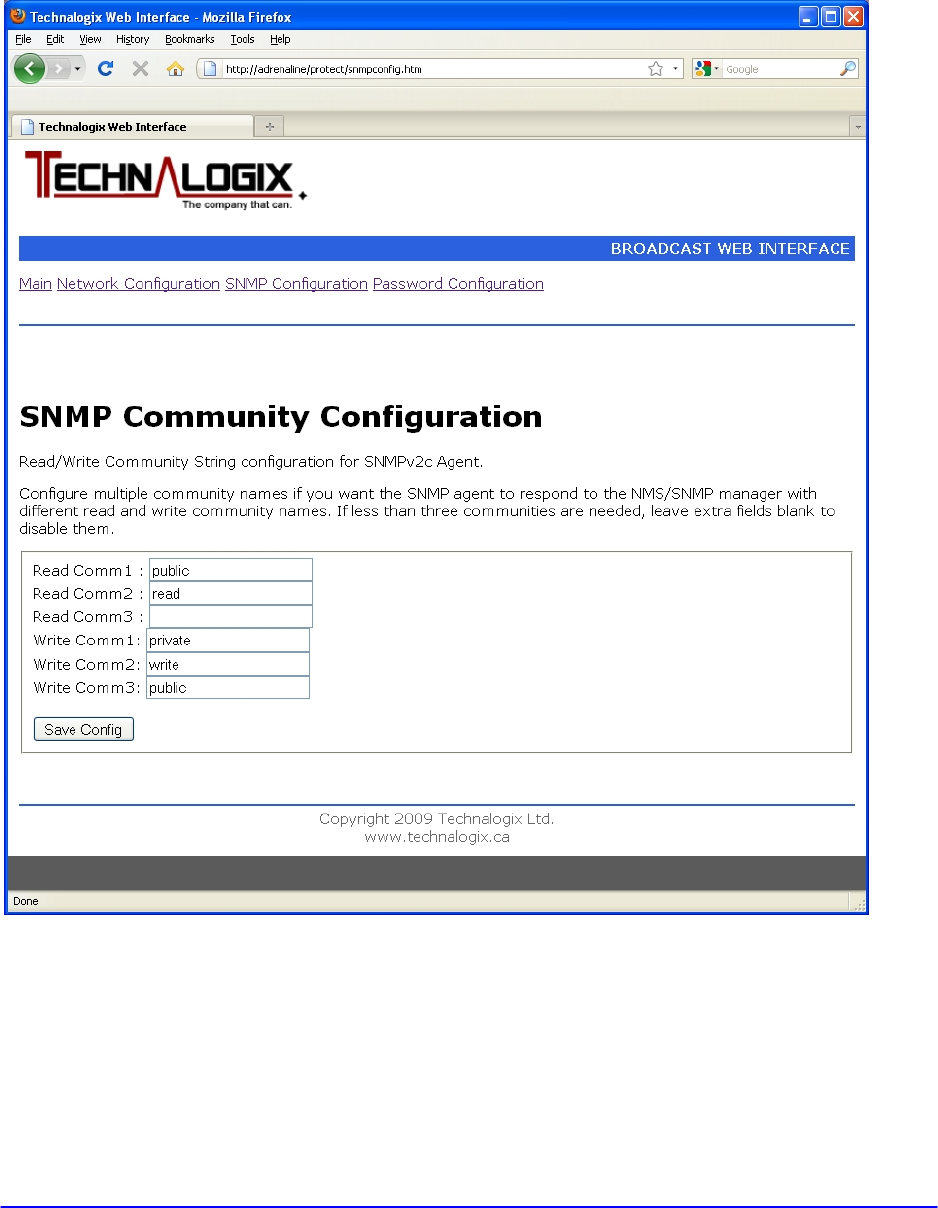
Technalogix Ltd Adrenaline Control System
VI-66
SNMP Configuration

Technalogix Ltd Adrenaline Control System
VI-67
The SNMP Configuration page allows you to set the SNMP communities. Set these to limit
access to the system via SNMP.
Default communities are READ: public
read
WRITE: private
write
public
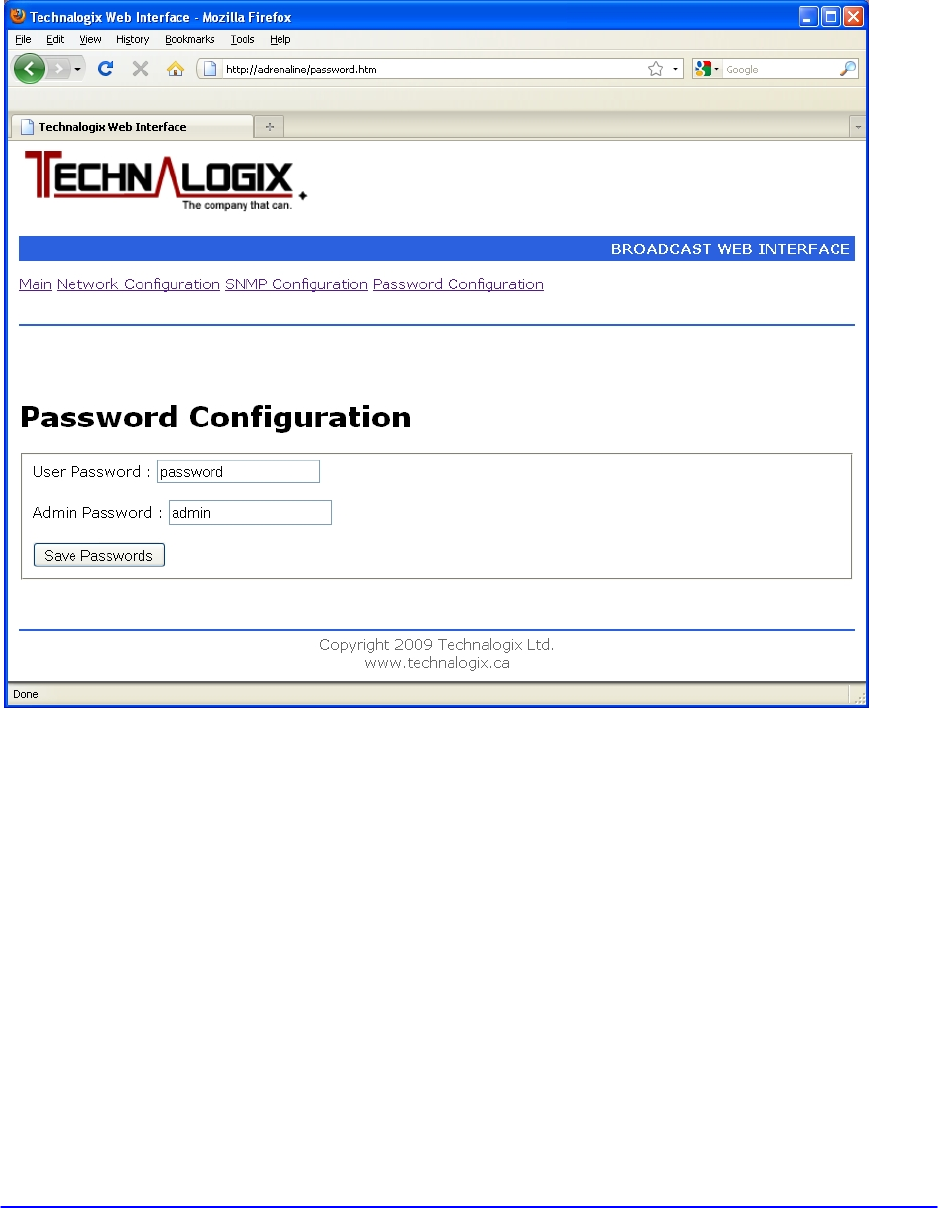
Technalogix Ltd Adrenaline Control System
VI-68
Password Configuration
This page allows setting of the User or Admin password.
The User account allows access only to the main page.
The Admin account allows access to the main and all the configuration pages.
Passwords are 8 characters long. Don’t forget your password. Resetting passwords isn’t fun
and may cause loss of all settings.

Technalogix Ltd Adrenaline Control System
VI-69
SNMP
The Technalogix.mib file allows access to the following
Read Only
Dip switch Setting - 8 bit value from dipswitch
Pallet Supply Voltage - voltage level (Vdc)
Temperature - temperature in (°C)
12V Current - current on12V bus (Adc)
48V Current - current on high voltage bus (Adc)
Attenuation - attenuation level
Forward Level - forward level as % rated full scale
Reflected Level - reflected level as % rated full scale
RF Input Level - input level as % rated full scale
RF Fault - hardware fault flag
Run Time - time since start up or reset
Serial Number
Model Number
SNMP Error Flag - error flag, also for trap (see below)
VSWR Flag - error flag for high VSWR
Overdrive - error flag for overdrive
Temperature Flag - error flag for high temperature
Read/Write
AGC mode - 1 AGC on / 0 AGC off
Reset - 1 Reset System 0 normal
Carrier On/Off - 1 Carrier On 0 Carrier Off
Carrier Up - 1 Increase Carrier Level
Carrier Down - 1 Decrease Carrier Level
VSWR - 1-8 set VSWR between 1.1 and 1.8:1
Read and Write communities can be set from the web interface.
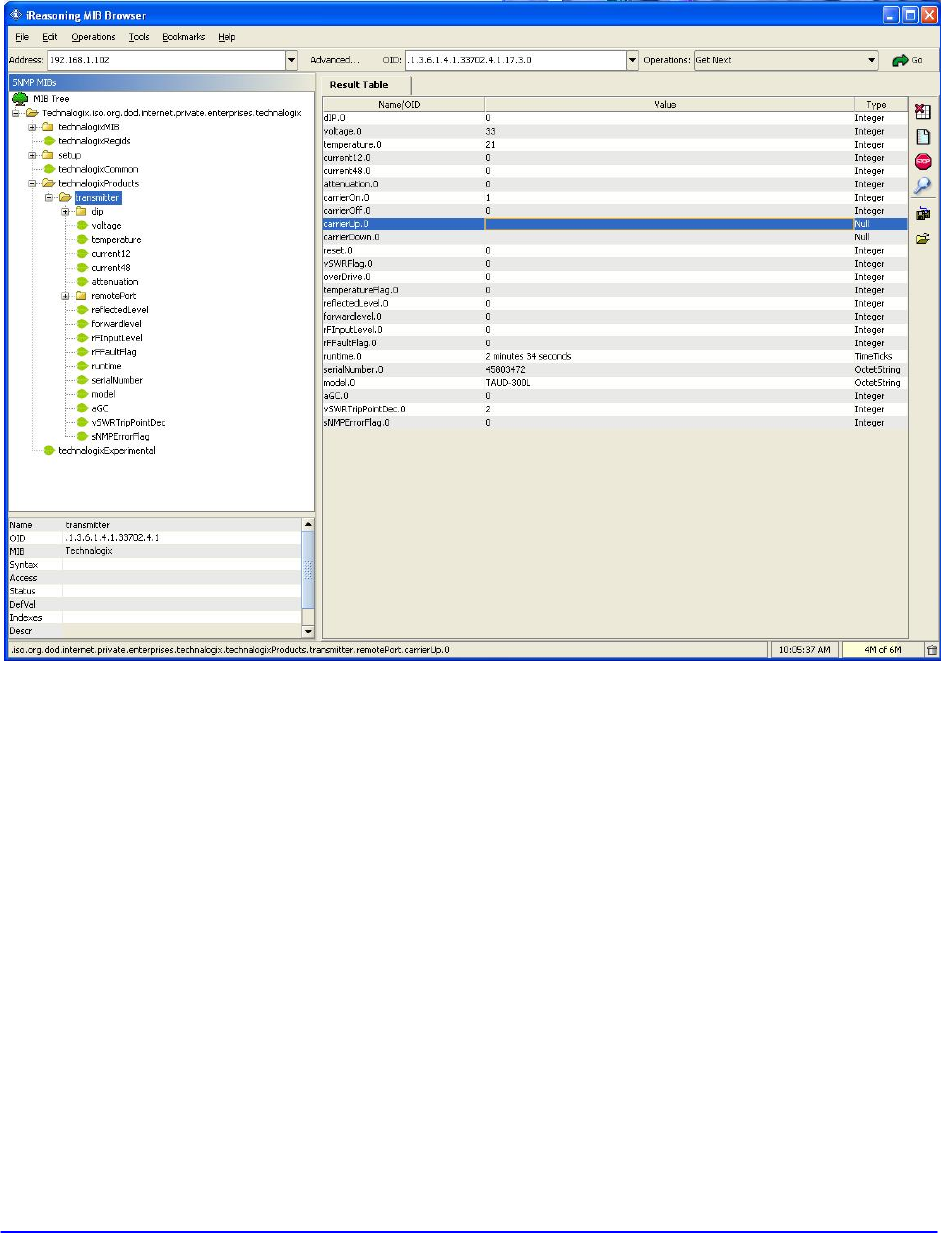
Technalogix Ltd Adrenaline Control System
VI-70
SNMP Traps
To Enable traps
Set enable traps to 1
Set the IP address to that of the receiving computer.
Set the community to one of the read communities set above.
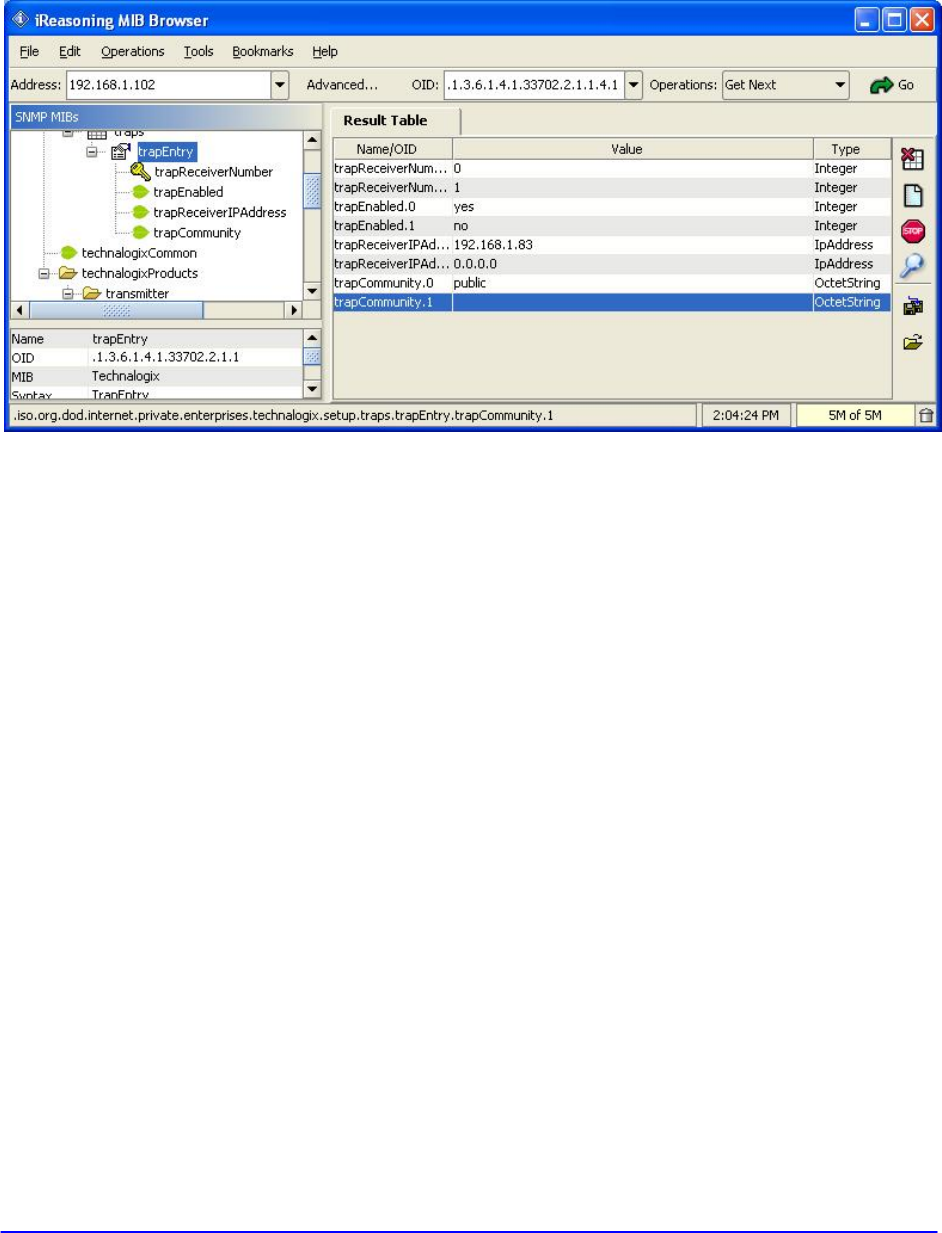
Technalogix Ltd Adrenaline Control System
VI-71
Ensure that your receiver’s port is set to 162
The system will generate a general trap on any error flag and send an 8bit value indicating the
type of error.
Bit 0(LSB) Overdrive
Bit 1 High VSWR
Bit 2 High Temperature
Bit 3 High Speed Hardware Shutdown
Bit 4(MSB) High Input Level
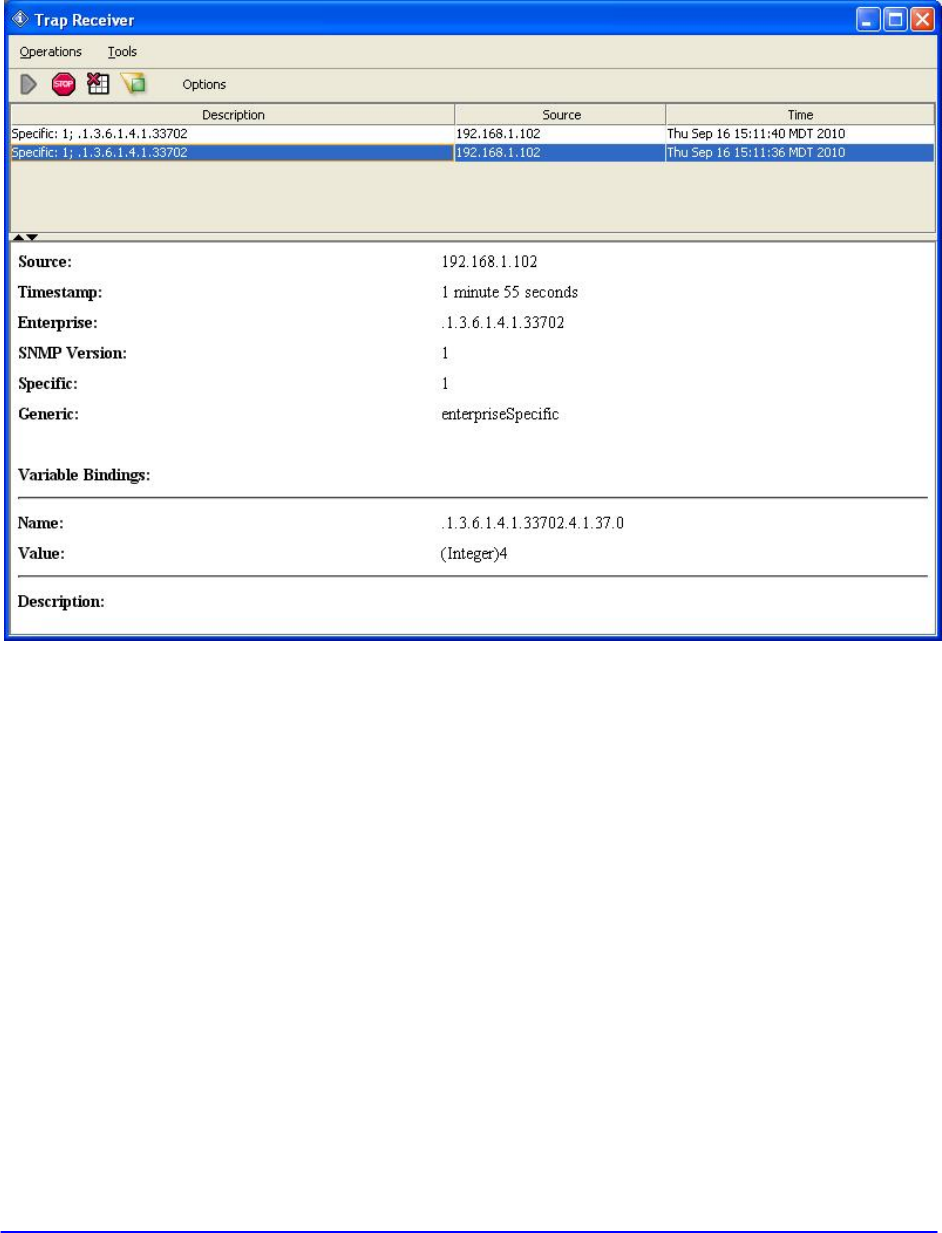
Technalogix Ltd Adrenaline Control System
VI-72
Shown here is trap of a high temperature fault (Value 4).

Technalogix Ltd Adrenaline Control System
VI-73
The overall functions of each pin on the Remote Port are indicated in the following:
DB25 pinout:
Pin Number Description
1 Ground
2 Forward power sample1
3 Reflected power sample1
4 Carrier off2
5 Carrier on2
6 Increase carrier level (level must have been decreased) 2
7 Decrease carrier level (1dB increments) 2
8 Do not use
9 Reset2
10 Do not use
11 High temperature flag3
12 High VSWR flag3
13 Amplifier overdriven flag3
14 Do not use
15 +3.3Vdc (for testing only, do not load)
16 Ground
17 Ground
18-25 Do not use
Notes: 1. Analog output with voltage ranging from 0 to 3.3Vdc.
2. TTL level digital input, active on rising edge.
3. TTL level digital output, active high.
In addition to the DB25 parallel data connector, the user may chose to remotely control the
transmitter/translator via an optional Ethernet web server or through an optional Simple Network
Managed Protocol (SNMP) interface, described later in this section.

Technalogix Ltd Adrenaline Control System
VI-74
Combiner
In higher power systems that contain more than one power amplifier enclosure, there also is a
combiner enclosure to combine the individual outputs of all of the power amplifier enclosures.
This combiner enclosure also monitors the total power of the overall system. The following is a
brief description of the operation of the monitor system found in the combiner unit, if applicable.
Carrier On/Off – Turning the carrier on or off can be done from the touch screen or the remote
port on any power amplifier or the combiner enclosure. It can also be done from SNMP or the
Ethernet interface which should be connected to the combiner enclosure. This will turn the
carrier off for the whole system.
Carrier Up/Down – The power level can be adjusted from the touch screen (RF Levels screen)
or the Remote Port on any power amplifier or the combiner enclosure. It can also be done from
the SNMP or Ethernet interface which should be connected to the combiner enclosure. This will
add or subtract attenuation on the individual power amplifier enclosures to achieve an overall
change in carrier level, and sets the AGC to the new levels if the AGC mode is enabled.
AGC mode – AGC mode and be turned on or off from the touch screen (RF Levels screen) or
the Remote Port on any power amplifier or the combiner enclosure. It can also be done from the
SNMP or Ethernet interface which should be connected to the combiner enclosure. This will
cause all the amplifier boxes to try and maintain the current forward power level.
Temperature, Voltage, Current - Temperature, voltage, and current readings on the enclosure’s
touch screen are for that unit only. The SNMP and Ethernet interface will show each units’
readings separately, and should be connected to the combiner enclosure.
Forward & Reflected Power – Forward and reflected power shown on the touch screen or the
Remote Port are for that power amplifier enclosure only, or show the total combined power if it
is on the combiner enclosure. The SNMP and Ethernet interface will show each units’ readings
separately, and should be connected to the combiner enclosure.
Display Units – Changing the temperature or power units on one enclosure won’t change the
display units on other enclosures. They will all have to be changed individually.
VSWR Trip point - The VSWR trip point between 1.1 and 1.8 can be changed from the touch
screen (RF Levels screen) on any power amplifier or the combiner enclosure. It can also be
done from the SNMP or Ethernet interface which should be connected to the combiner
enclosure. This will change the trip point for all the units.
Errors – An error that causes one enclosure to shutdown will cause the other enclosures to
shutdown. If one power amplifier or the combiner is to fold back its power levels to stay within
operating parameters, the others will match that power level.

Technalogix Ltd TAUD-1000 Transmitter
VII-1
Section VII – Mechanical Section
The heat sink in each TAUD-500 which make up the amplification stage of the TAUD-1000
allows the amplifiers to operate at a cooler temperature and prevents overheating, which helps
the longevity of the entire system. The heat sink has hollow fins, which help dissipate the heat
from the amplifiers faster than a conventional serrated or corrugated fin.
In addition to the cooling effects of the heat sink, within each TAUD-500 power amplifier
enclosure, there are four fans that each provide 170 cubic feet per minute (CFM) of air flow (into
zero static pressure). There are two fans mounted at the front of the heat sink and two mounted
at the back end of the heat sink. The fans are mounted side-by-side to produce the best cooling
for the system and are operating in a push-pull configuration to assist with heat dissipation.
The Combiner/Filter enclosure also contains additional fan cooling, specifically for the digital mask
filter and also for the termination resistors on the 2-way combiner. In the event of any RF power or
phase imbalance between the two TAUD-500 Power Amplifier enclosures, the unbalance gets
dissipated in the form of heat through the flanged resistor.

Technalogix Ltd TAUD-1000 Transmitter
VIII-1
Section VIII - Installation
This section contains installation recommendations, unpacking, inspection, and installation
instructions for the power amplifier. We are sure that you are chomping at the bit to install your new
system, so we recommend that you read the following sections very carefully.
Building Recommendations
The quality of the building is of great importance if you are to expect long life and continued
performance from the power amplifier. The building must be clean, dry, temperature controlled and
secure. Don’t forget to allow space in the building for any additional racks to house test equipment,
a workbench area, line regulating transformers, ladders, equipment and parts storage, first aid kit,
emergency generator if used, as well as heating and cooling devices that may be unique to your
installation. A sloping roof will tend to develop leaks less rapidly. The building should be well roofed
with good material. The cooling load will be lowered with reflective or light colored roofing material.

Technalogix Ltd TAUD-1000 Transmitter
VIII-2
Heating and Cooling Requirements
The environment’s temperature will contribute greatly to the length of the power amplifier’s life.
Technalogix recommends that the building’s filtered air intake must have capacity for all air-flow in
the building plus an additional 20%. Keep the intake below the roofline to avoid intake of solar
heated air. Please ensure that the intake and exhaust areas are on the same side of the building to
avoid pressure differentials during windy conditions. Also, do not position intake near exhaust’s
preheated air. If air conditioning is required to cool the shelter, discuss the situation with a qualified
HVAC technician. Under average conditions, 12,000 BTUs will cool approximately 500 square feet
to a comfortable level.

Technalogix Ltd TAUD-1000 Transmitter
VIII-3
Electrical Service Recommendations
Technalogix recommends that a qualified, licensed local electrician be consulted for the required
electrical service. We suggest local electricians because:
• The personnel knows the local codes
• The personnel can be on site readily
• You are apt to get better overall support if you give what business you can to local suppliers
Technalogix recommends that proper AC line conditioning and surge suppression be provided on
the primary AC input to the power amplifier. All electrical service should be installed with your
national electrical code in your area, any applicable provincial or state codes, and good engineering
practice. Special consideration should be given to lightning protection of all systems in view of the
vulnerability of most transmitter or translator sites to lightning. Lightning arrestors are recommended
in the service entrance. Straight and short grounds are recommended. The electrical serviced must
be well grounded. Do not connect the unit to an open delta primary power supply, as voltage
fluctuations could harm the unit. Branch your circuits. Do not allow your lights, your workbench
plugs, and your transmitting or translating equipment to operate on one circuit breaker. Each
transmitter or translator should have its own circuit breaker, so a failure in one does not shut off the
whole installation.

Technalogix Ltd TAUD-1000 Transmitter
VIII-4
Antenna and Tower Recommendations
Your preliminary engineering workgroup should establish your antenna and tower requirements,
both for receiving and transmitting antennas. Construction of sturdy, high quality antenna/tower
systems will pay off in terms of coverage of your service area, the overall quality and saleability of
your radiated signal, and reduced maintenance expenses. Technalogix provides complete turnkey
antenna systems if needed. If your site is serving as a translator, your receiving antenna should be
in line of sight to the originating station all year round. The foliage will change with season.
Transmitting antennas can enhance or seriously impair the transmitter/translator output.
The selection, routing, and length of coaxial cable are extremely important in the installation. If there
is a 3 dB line loss in the cable between your unit’s output and the transmitting antenna, your unit will
only deliver half power to the antenna. Buy the best cable you can obtain, route it via the shortest
way to the antenna, and keep it straight. Do not form it into sharp bends on its way. Do not use any
more cable fittings for the installation than absolutely necessary. All cautions here apply equally to
all coaxial cables in the system - input and output.
Pay attention to radial ice accumulation when designing the transmission system. It is not
uncommon for at least an inch of ice to build up on the tower and antenna. This in turn significantly
increases the weight, cross section, and wind loading of the system.
Attaching the transmission line to the tower is crucial to maintain a safe and reliable operation.
Nylon wire ties and electrical tape will breakdown in the sunlight and ultimately fail, creating a
potentially dangerous situation. It is important to use proper clamps and hoisting grips and also
ensure that the transmission line is grounded to the tower in several locations. When high currents
flow through the tower in the event of lightening strikes, some of that current will through the outer
conductors of the transmission lines. Due to the resistance difference between the steel tower and
copper transmission line, a significant voltage can be developed, often resulting in arcing between
the outer jacket and outer conductor, thus pitting the conductor.
Preventative maintenance is crucial in ensuring that safety is maintained. Specifically, check that
transmission line grounds are tight and are not missing any hardware. Frequently inspect support
clamps or spring hangers. Consider investing in an ice break, if you haven’t already done so, as
shards of falling ice can damage the transmission line – and if it is going to happen, it will happen at
an important time. Check the tower light photocells and conduit.
The better-known tower manufacturers offer complete technical and safety documentation with their
towers. Be sure that you have this information as it regards wind loading, guying, etc. The best-
designed antenna system will function poorly if shortcuts and compromises are used during
installation. Follow the manufacturer’s instructions exactly, along with any engineering data
prepared for the site. Be absolutely safe and certain about this aspect as human lives may be at
stake.

Technalogix Ltd TAUD-1000 Transmitter
VIII-5
Shelter Security
The FCC requires that the transmitter or translator be secure from entry or control by unauthorized
persons, and that any hazardous voltages or other dangers (including most tower bases) be
protected by locks or fences as necessary to protect personnel and prevent unauthorized tampering
or operation. Security of the building further implies that it be secure from wildlife. Use sturdy
construction materials, including sheet metal if necessary. Holes around conduit, cable, and other
similar entry points should be stuffed with steel wool and caulked to prevent entry of wildlife. Other
features of security for your shelter may include its location with respect to the prevailing wind
conditions. A location leeward of some natural topographical feature will prevent wind damage and
snowdrifts. Check the soil runoff conditions that may slow or hasten wind or water erosion and other
concerns that may be unique to your location.

Technalogix Ltd TAUD-1000 Transmitter
VIII-6
Unpacking and Inspection
Check the outside of the container. Carefully open the container and remove the power amplifier.
Retain all packing material that can be reassembled in the event that the equipment must be
returned to the factory.
Exercise care in handling equipment during inspection to prevent damage
due to rough or careless handling.
Visually inspect the enclosure of the power amplifier for damage that may have occurred during
shipment. Check for evidence of water damage, bent or warped chassis, loose screws or nuts, or
extraneous packing material in connectors or fan failures. Inspect all connectors for bent connector
pins. If the equipment is damaged, a claim should be filed with the carrier once the extent of the
damage is assessed. Technalogix cannot stress too strongly the importance of immediate careful
inspection of the equipment and subsequent immediate filing of the necessary claims against the
carrier if necessary. If possible, inspect the equipment in the presence of the delivery person. If the
equipment is damaged, the carrier is your first area of recourse. If the equipment is damaged and
must be returned to the factory, phone for a return authorization. Claims for loss or damage may not
be withheld from any payment to Technalogix, nor may any payment due be withheld pending the
outcome thereof. Technalogix cannot guarantee the carrier’s performance.
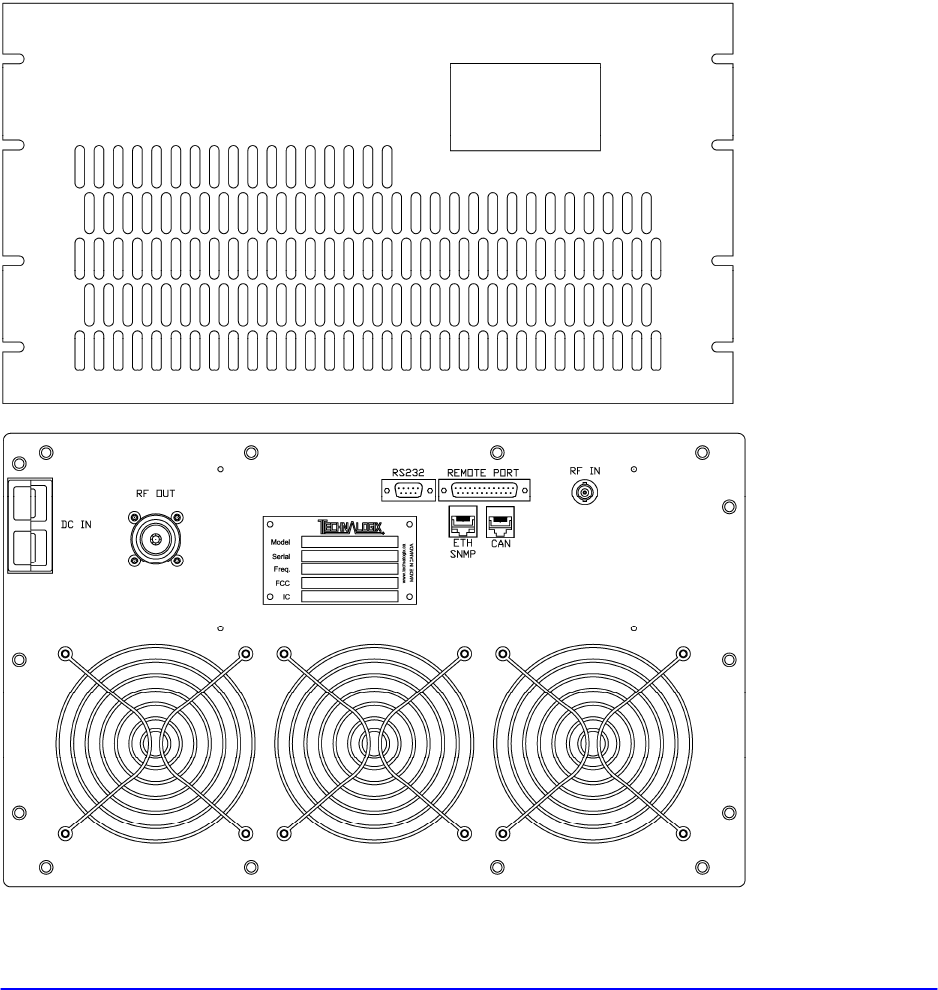
Technalogix Ltd TAUD-1000 Transmitter
VIII-7
Location and Function of Controls and Connectors (each TAUD-500 Power Amplifier)
The following illustration depicts the location of the connectors when installing each of the 500-watt
8VSB power amplifiers (TAUD-500) that comprise the TAUD-1000.
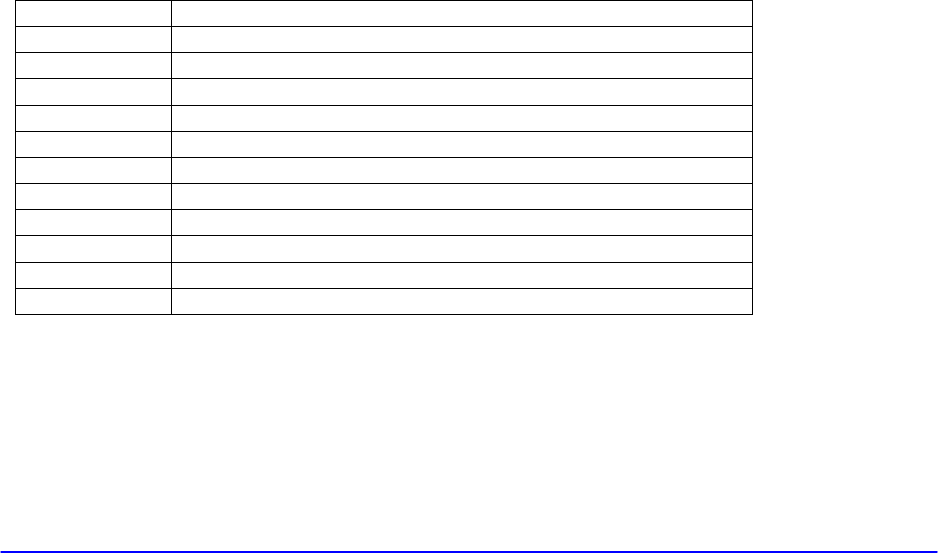
Technalogix Ltd TAUD-1000 Transmitter
VIII-8
RF IN – RF input from modulator or processor after the signal is split by the 2-way
splitter to go to each TAUD-500. BNC connector, 50 ohm.
RF OUT – 500-watt (RMS) RF output. Connects to Combiner/Filter enclosure through
phased cables to ensure phase and amplitude balance is maintained.
7/16”DIN connector, female, 50 ohm.
DC IN – DC input from switching power supply.
REMOTE PORT – Remote interface and control. Connector is individual pins and not
serial interface. Pinout described in Monitor and Control section.
CAN - No Connection
RS232 - No Connection
ETH/SNMP - Ethernet or SNMP RJ45 connection
Pin Number Description
1 Ground
2 Forward power sample1
3 Reflected power sample1
9 Reset2
11 High temperature flag3
12 High VSWR flag3
13 Amplifier overdriven flag3
14 +5Vdc
15 +3.3Vdc
16 Ground
17 Ground
Notes: 1. Analog output with voltage ranging from 0 to 5Vdc.
2. TTL level digital input, active on rising edge.
3. TTL level digital output, active high.
Remaining pins should not be connected.
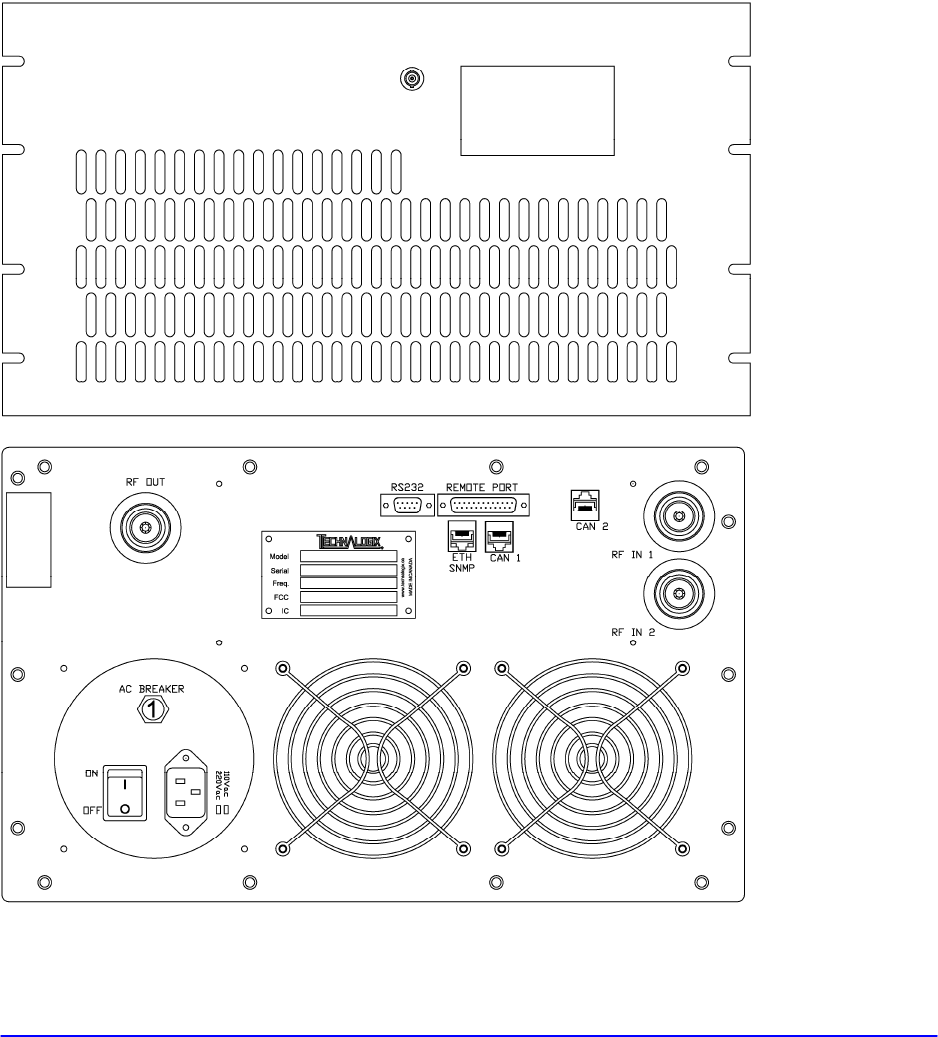
Technalogix Ltd TAUD-1000 Transmitter
VIII-9
Location and Function of Controls and Connectors (Combiner/Filter Enclosure)
The following illustration depicts the location of the connectors when installing the Combiner/Filter
enclosure that takes the outputs of the (2) TAUD-500, combines them, and passes the combined
1,000-watt (RMS) signal through a bandpass filter and directional coupler.
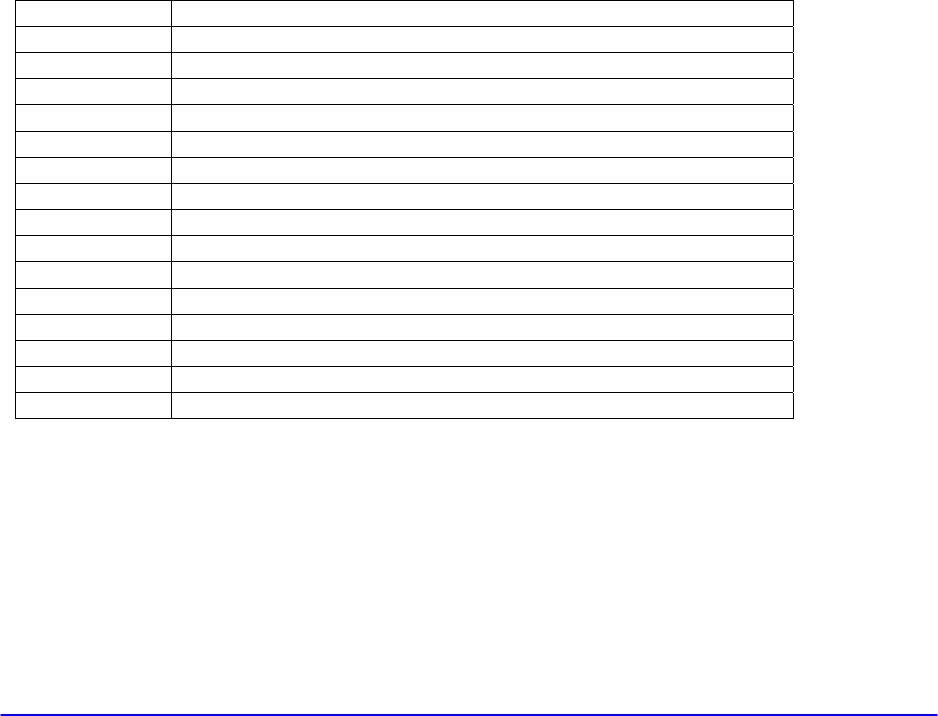
Technalogix Ltd TAUD-1000 Transmitter
VIII-10
RF IN – RF inputs from each of the (2) TAUD-500 power amplifiers. Cables are a
specific length to maintain phase relationship to input of combiner (contact
factory for lengths). 7/16”DIN female, 50 ohm.
RF OUT – 1,000-watt (RMS) RF output. Connects to user’s inline 8VSB-reading
wattmeter (not included) and/or the antenna via 7/16”DIN connector, female.
REMOTE PORT – Remote interface and control. Connector is individual pins and not
serial interface. Pinout described in Monitor and Control section.
CAN - No Connection
RS232 - No Connection
ETH/SNMP - Ethernet or SNMP RJ45 connection
Pin Number Description
1 Ground
2 Forward power sample1
3 Reflected power sample1
4 Carrier Off2
5 Carrier On2
6 Increase carrier level (level must have first been decreased) 2
7 Decrease carrier level (1dB decrements) 2
9 Reset2
11 High temperature flag3
12 High VSWR flag3
13 Amplifier overdriven flag3
14 +5Vdc
15 +3.3Vdc
16 Ground
17 Ground
Notes: 1. Analog output with voltage ranging from 0 to 5Vdc.
2. TTL level digital input, active on rising edge.
3. TTL level digital output, active high.
Remaining pins should not be connected.
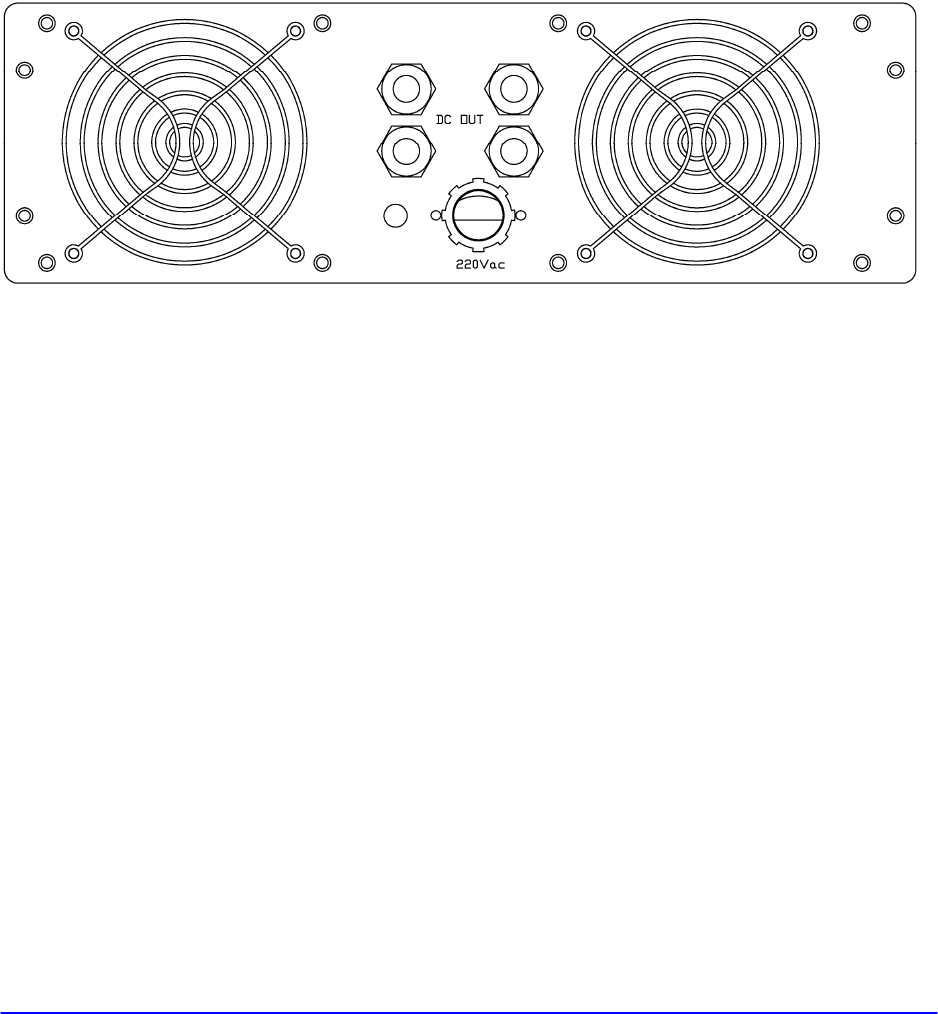
Technalogix Ltd TAUD-1000 Transmitter
VIII-11
Location and Function of Controls and Connectors (Power Supply Enclosure)
The following illustration depicts the location of the connectors when installing the Power Supply
enclosure.
DC OUT - DC output (30Vdc) fed independently to each of the (2) TAUD-500 Power
Amplifier enclosures.

Technalogix Ltd TAUD-1000 Transmitter
VIII-12
Initial Hook Up
1. Ensure that the antenna has been swept and, ideally, has a return loss of greater than 20dB
(VSWR = 1.2:1). This should be done before connecting the antenna cable to the system’s
output. The power amplifier’s control system allows the user to change the VSWR trip point
up to a maximum level of 1.8:1. Strive for the lowest possible return loss to maximize
transmission distance and improve operating performance. VSWR levels between the trip
point set by the user and 1.8:1 will cause a fold back in power. VSWR levels past 1.8:1 will
cause the system to shut down to avoid damage.
2. Place the transmitter/translator in its permanent location near a receptacle supplying the
required AC or DC mains voltage.
3. Place an appropriate AC or DC power line protector, conditioner, and/or surge suppressor
across the supply line.
4. Connect the transmitting antenna cable to the RF OUT N-type female connector on the PA
enclosure’s RF output. On medium and higher power systems, the RF OUT connector will
be 7-16 DIN female (or an alternative if the customer requested a different connector). The
system must be loaded into a 50-ohm antenna before any power is turned on.
5. Check that your baseband digital source is present, whether it is from an encoder, mux, or
otherwise, to feed the modulator if the system is a transmitter. If the system is a translator,
ensure that the modulated RF signal is present at the input to the processor/translator that
will feed the power amplifier.
6. Connect the CATS cables from the combiner outputs (2) to each CAN on the power
amplifier.
7. Hook up the modulator or processor as shown in their respective manuals for a transmitter
or translator. If the modulator or processor was produced by Technalogix, then the RF
output level has already been set and optimized for optimum performance and should not
be adjusted. Power level adjustment can be made through the power amplifier. If the front
end modulator or processor was not produced by Technalogix, ensure that modulator or
processor RF output level is turned down as far as possible. This will help ensure that the
different product does not overdrive the power amplifier due to mismatched RF levels.
8. Do not connect the modulated signal from the RF OUT on the modulator or processor to RF
IN on the power amplifier at this time. Because of the characteristics of LDMOS devices, the
RF drive should not be connected to the power amplifier until after the power supply and
bias voltages are present and stable.
9. If the power amplifier system includes a power supply that is external to the power amplifier
enclosure, install the DC power supply leads (4 AWG) between the power supply enclosure
and power amplifier enclosure. If the power supply is internal to the amplifier, then all DC
wiring is already hooked up.

Technalogix Ltd TAUD-1000 Transmitter
VIII-13
At this stage, the system is set up and ready to do a preliminary start up, as outlined in the
following section
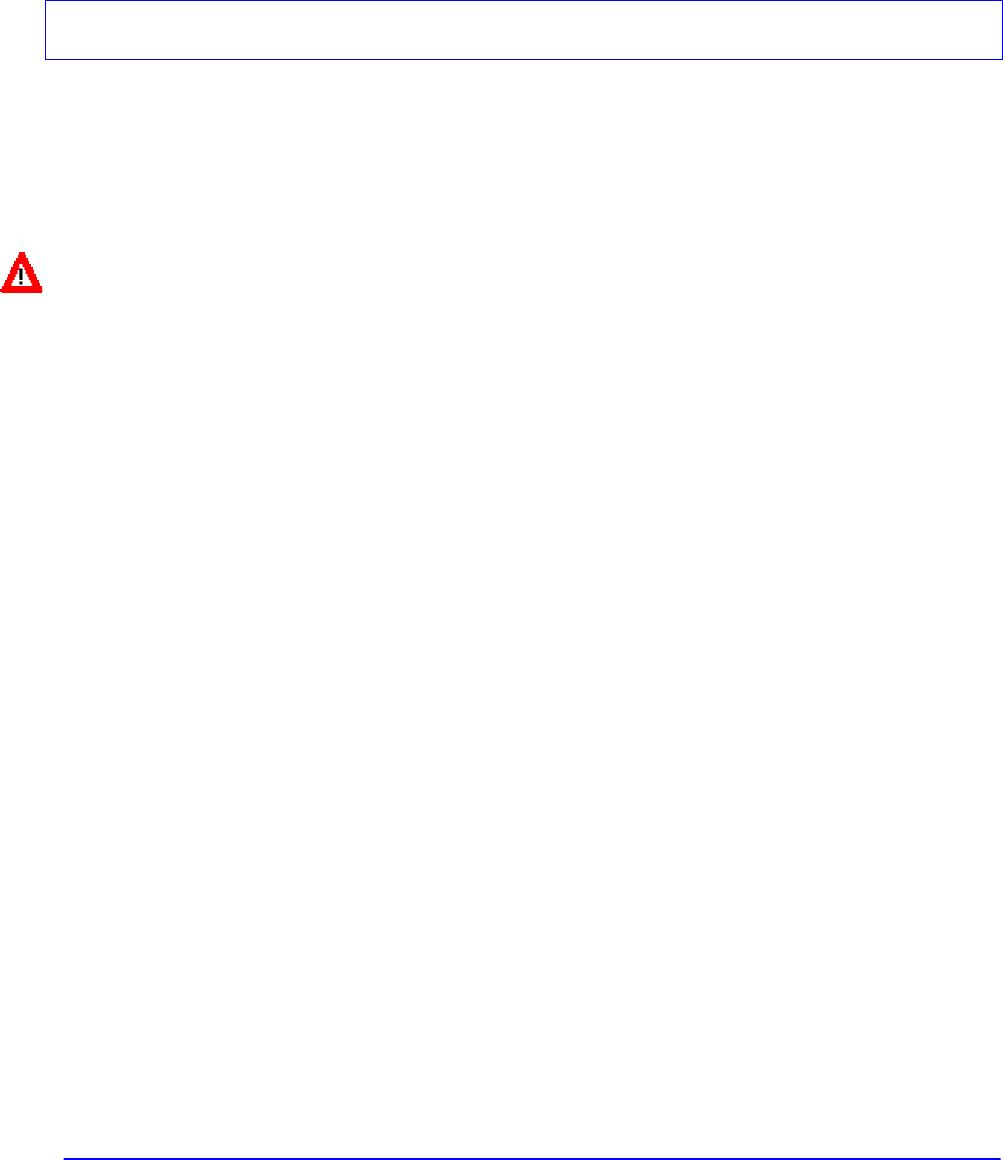
Technalogix Ltd
IX-1
Section IX - Operating Procedure
Assuming the previous installation instructions have been completed and cautions noted, and the
power amplifier is ready to receive a properly modulated signal, proceed with the following steps to
place the system in operation. The power amplifier has been factory aligned for channel frequency
(per system specification), signal levels and optimum performance.
IT IS HIGHLY RECOMMENDED THAT YOU RUN YOUR SYSTEM INTO A DUMMY LOAD
BEFORE INSTALLING TO MAKE SURE THERE ARE NO DAMAGES CAUSED IN SHIPPING AND
THE UNIT IS RUNNING PROPERLY
1. Do not apply a modulated RF drive signal to the power amplifier at this time.
2. Verify that all control and RF cables are tight and properly seated in or on the mating connector.
3. Plug the modulator or processor into AC mains (specified by the manufacturer), while still
disconnected from the power amplifier.
4. With the power amplifier loaded into the filter and the filter loaded into the antenna (or
dummy load), power up the amplifier by turning on power supply (either externally or via on
the ON/OFF switch on the back of the power amplifier depending on the system).
5. Verify that the power amplifier fans are all on. The fans are powered via DC voltage so this is an
indication that the power supply is started and running.
6. The internal soft start circuitry will turn the bias voltages off until the power supply to the
amplifier pallets is fully stable. The front display indicates when the soft start is running with
either a displayed message when an LCD option is installed or via maximum attenuation when
a touch screen option is installed. Once complete, the Forward and Reflected Power and Power
Supply readings will appear on the LCD in the filter and power amplifier enclosures.
7. Verify that a low input level warning is displayed. This ensures that the power amplifier has
placed maximum attenuation on its input and is ready to receive the RF drive signal. On
systems with the touchscreen option installed, this attenuation is displayed in the lower right
corner of the screen (39 is maximum attenuation).
8. After the soft start is complete, apply the RF drive signal (which still should be turned down)
between the modulator or processor and the power amplifier RF In (BNC female). This ensures
that the RF drive signal is applied only after the power supply is stable and the bias voltages are
applied to the amplifier.

Technalogix Ltd
IX-2
9. The front display shows the user the present status of the amplifiers. Adjust RF output power to
desired level. Verify that the FWD Power reads 80 to 100% of the system’s rated power on the
PA enclosure - depending on the modulation of the signal content. The system is set up for
100% rms 8VSB power, unless otherwise specified. A typical data signal with QAM64 or DVB
will show differently. The output power level can be adjusted from the power amplifier’s RF
Levels screen. Keep in mind that the system will fold back or shut down (depending on severity)
should the forward RF output power level be exceeded.
10. Ideally, the RFL Power should read zero. However, should a high VSWR be detected, the
system will automatically fold back or shut down and cycle as previously described in the control
system section.
11. Verify that the power supply reads correctly (see supplied final inspection sheet for factory
settings of power supply levels) on the display of the power amplifier.
12. Look at the transmitted output using a suitable monitor. The picture and sound quality should be
clean and sharp. If the output picture and sound quality is unsatisfactory, check the input
signals, connections to the antenna system, antenna and transmission line VSWR, and the
physical condition of the antenna.
If reception problems are encountered, and the quality of transmission is satisfactory, the difficulty is
often with the receiving antenna or with obstructions in the path between the transmitter/translator
and receiver. It is important to ensure that the transport stream has not been divided up into too
many sub-channels. This will likely cause “pixeling” during fast frame changes like sports and
movies in the case of broadcast video transmission.
Assuming the previous installation instructions have been completed and cautions noted, and the
power amplifier is ready to receive a properly modulated digital signal, proceed with the following
steps to place the system in operation. The power amplifier has been factory aligned for channel
frequency (per system specification), signal levels and optimum performance.

Technalogix Ltd
X-1
Section X – Maintenance and Troubleshooting
Periodic Maintenance
If your unit employs a filter on the air inlet for the fans, the filter should be cleaned every 30 days. If
the equipment is operated in a severe dust environment, the filters on the inlet fan may need to be
cleaned more regularly. Turn the system off and unplug all of the AC inlet cords. The filter can be
lifted off the fan and cleaned using an air compressor at low pressure. While the filter is out, clean
the fan blades themselves with a small brush. The fans themselves do not need lubrication.
The interior of the cabinets should be cleaned and inspected annually. Turn the system off and
unplug all of the AC inlet cords. Remove the top lid by unscrewing the 6-32 machine screws.
Use extreme caution when working near the AC input terminal. The power
amplifier and power supply store hazardous capacitances and voltages.
Using either compressed air or a brush with soft bristles, loosen accumulated dust and dirt and then
vacuum the interior of the cabinet. Complete a visual inspection of the interior, making sure there
are no loose connections or discolorations on any components from heat. Nothing inside the power
amplifier enclosure exceeds a temperature that is not comfortable to the touch under normal
operating conditions, so any signs of discoloration indicate potential damage.
All modular components inside the enclosure are attached to aluminium mounting plates for easy
removal and replacement. Ensure that plates are secured and the mounting hardware is tight.
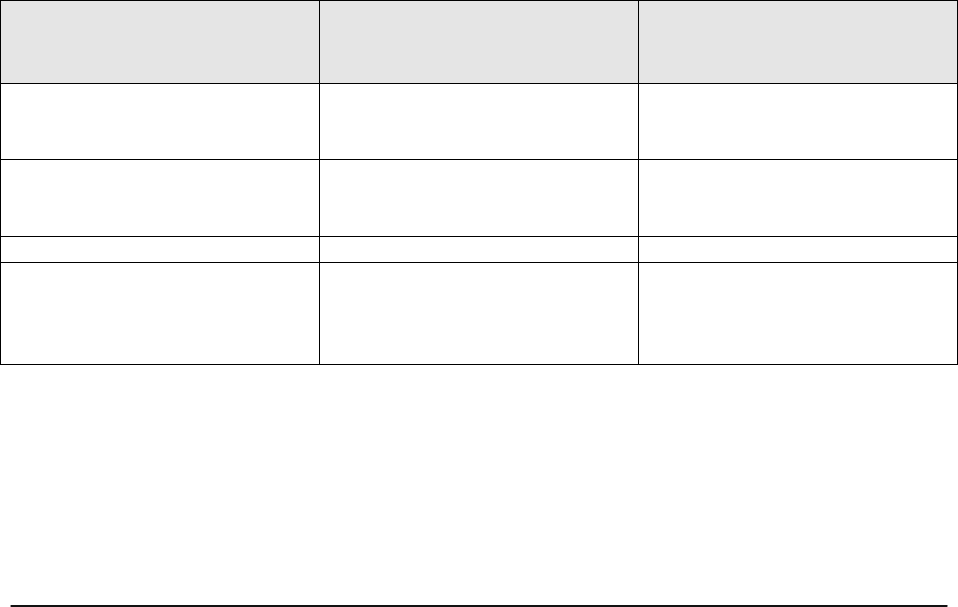
Technalogix Ltd
X-2
Troubleshooting
The first and most important aspect of troubleshooting anything is to be systematic. Note where
you have looked and what you found.
Look first for the obvious.
• Make a physical inspection of the entire facility. Are all necessary connections properly made?
Do you see any signs of obvious damage within the equipment?
• Is the AC power ‘ON’ to the site and the equipment? (Check fuses and circuit breakers if
necessary.)
• Are all the switches in the correct operating position?
• Is the input signal present?
• Check LCD readings for presence of forward and reflected power and 31 V DC supply levels.
The above is an aid in determining the fault if some aspect of the system is not operating. The
following table deals with quality of operation:
Symptom Possible
Fault
Correction
Horizontal bars in picture
(may roll either way
depending on phase)
AC grounding / AC
interference Install EMI/RFI filter in AC line
Ensure modulator/processor
and power amplifier share a
common ground
Diagonal lines in picture Interference Install EMI/RFI filter in AC line
Determine source and
frequency of interfering signal
(spectrum analyzer may be
required)

Technalogix Ltd
X-3
Symptom Possible
Fault
Correction
High reflected power Incorrect load Ensure amplifier connected to
transmission line
Ensure correct antenna
impedance (50 ohms)
Check antenna tuning and
VSWR. Verify correct cable
for transmission line length
Check all cables for visible
damage (kinks, nicks or cuts)
Check all connectors for poor
connections, water or corrosion
Check alignment of antenna
Check for physical damage of
antenna, including ice build-up
Thank you
for choosing
Technalogix Ltd.